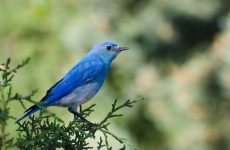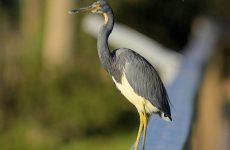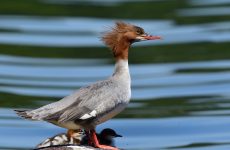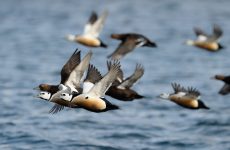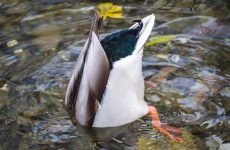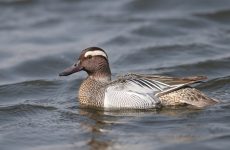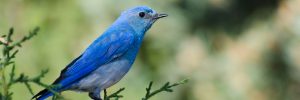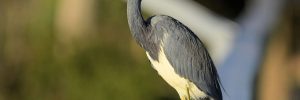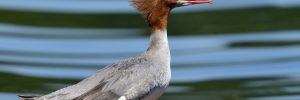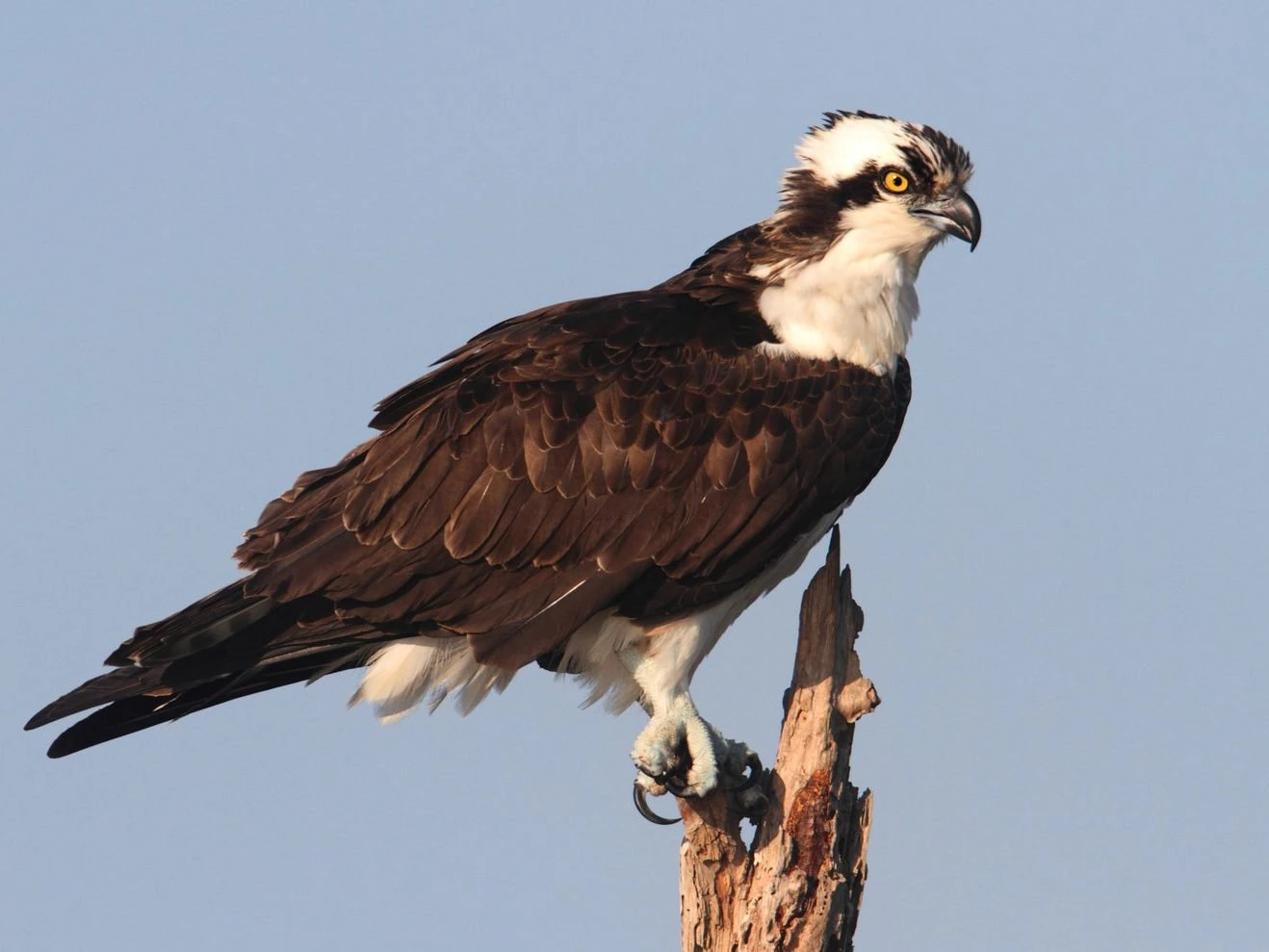
With prominent hooked bills, large powerful talons, incredible speed and keen eyesight these deadly predators of the skies fill legends and folklore with tales of their might.
It’s easy to see why we want to get a look at these majestic birds and this guide will help you identify all the birds of prey in the United States by sight and sound.
Birds of prey are made up of two orders of birds, the Falconiformes, and Strigiformes. Falconiformes are also known as raptors and include eagles, condors, kites, hawks, vultures, kites, and osprey. Strigiformes are known as owls.
North America has 40 birds of prey that have been spotted here which includes owls, eagles, hawks, vultures, falcons, kites, and osprey.
Birds of prey hunt and eat other animals, mainly mammals, reptiles, and smaller birds, but some also hunt fish. Most hunt in the diurnal and hunt in the day, except owls which are mostly nocturnal and hunt at night.
Check out all the birds of prey you can spot in the United States
40 Birds Of Prey In North America
Owls
1. Great Horned Owl
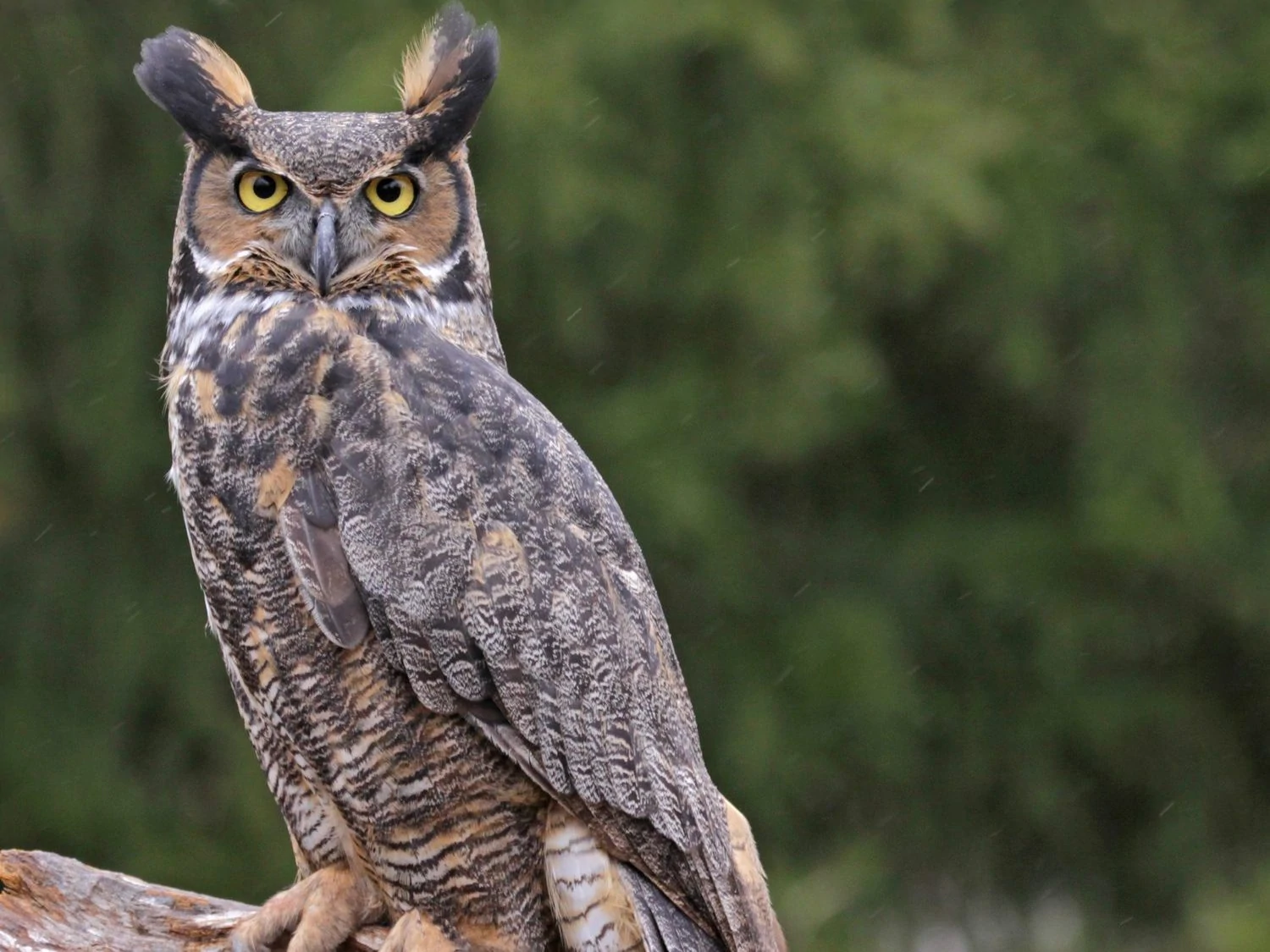
Great Horned Owls are one of the most common owls in North America.
Their most unique physical characteristic is their “Great Horns” which aren’t really horns but ear tufts. They’re tufts of feathers that they use as camouflage to make them appear like branches of trees.
They have grayish to reddish-brown faces, large yellow eyes outlined in black, and their hooked bills are dark gray.
The coloring and patterns of Great Horned Owls are also mainly for camouflage. Their backs and wings are mottled with gray, brown, black, or white. They can be darker or lighter depending on the region they are from and are smaller in the south than in the north.
Juveniles have white, cinnamon, or gray fluffy feathers that make them look “puffed up”. Their barring is less visible, and their ear tufts are smaller and hardly seen.
- Bubo virginianus
- Length: 18.1 – 24.8 in (46 – 63 cm)
- Weight: 32.1 – 88.2 oz (910 – 2500 g)
- Wingspan: 39.8 – 57.1 in (101 – 145 cm)
Great Horned Owls are widespread throughout North America and do not migrate.
You can find Great Horned Owls in almost any environment in North America. As long as they have nesting sites, roosting sites, and an abundance of prey, they will be able to adapt to forests, deserts, grasslands, or cities.
Their varied diet includes small rodents such as mice, skunks, geese, and hares. They will also eat insects, fish, and carrion.
Great Horned also hunt other raptors such as Ospreys, Peregrine falcons, or other owls.
They hunt from a perch, scanning their territory and swooping down to capture their prey with their strong talons. They will also hunt from the ground or wade in the water.
Great Horned Owls: The distinctive 5-note Hoo call of the Great Horned Owl is made by both males and females, but females are higher pitched. They also make various whistles, shrieks, hisses, and coos.
Nests of Great Horned Owls are usually in trees, and they often use an old nest from another species. They line the nest with bark, leaves, downy feathers, or pellets but sometimes leave it unlined. The female lays up to four eggs that are incubated for around a month.
Fun Fact: Great Horned Owls are the crows’ number one enemy. Crows will usually mob Great Horned Owls in their nests, and that is one of the best ways to find them.
2. Eastern Screech Owl
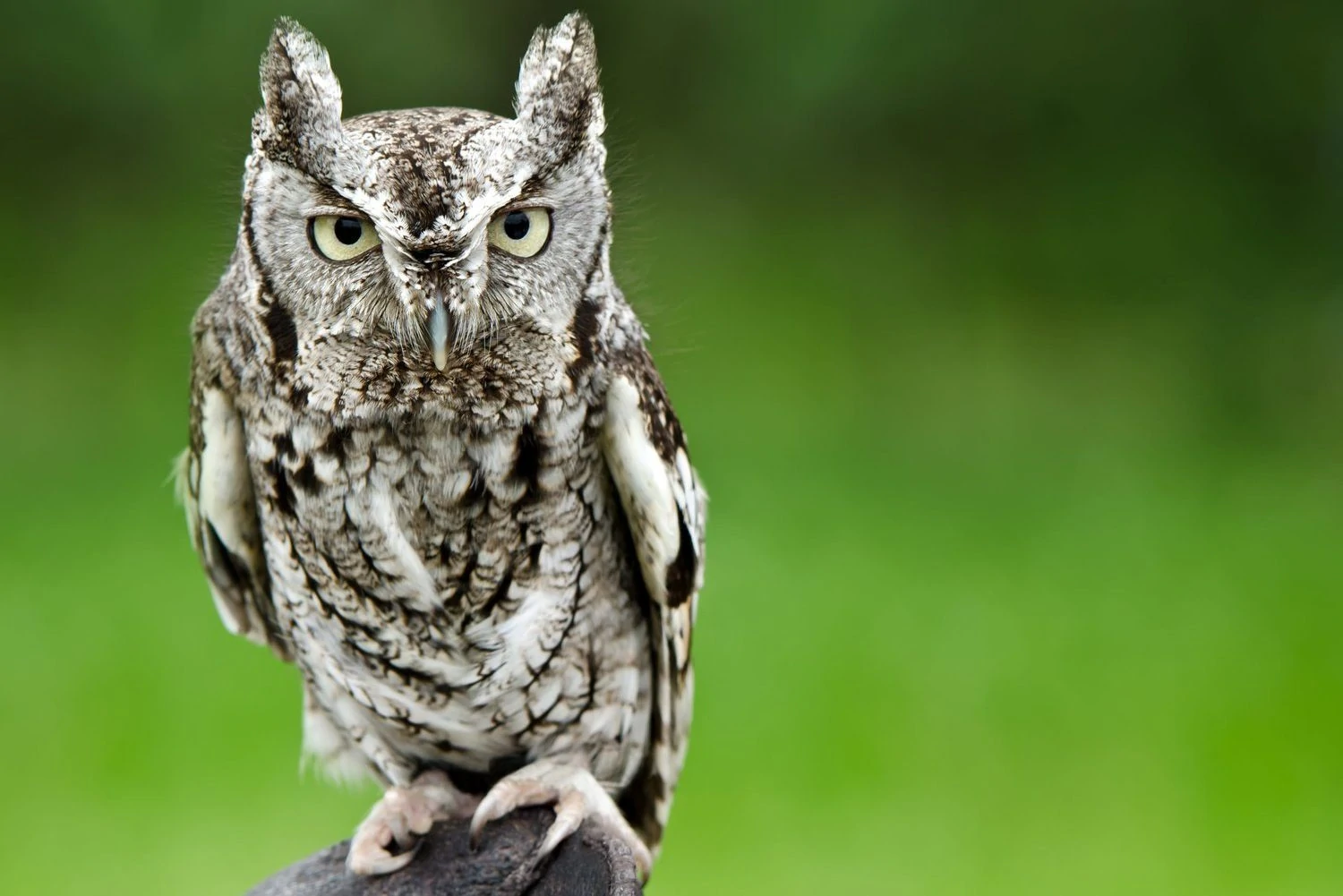
Eastern Screech Owls are short, stocky birds with mottled coloring, and they are either more red or gray depending on location. They have a large head and almost no neck. Their patterned and spotted camouflage makes them hard to spot against tree bark.
They are only about the size of a robin but much bulkier.
- Megascops asio
- Length: 6.3 – 9.8 in (16 – 25 cm)
- Weight: 4.3 – 8.6 oz (121 – 244 g)
- Wingspan: 18.9 – 24.0 in (48 – 61 cm)
Eastern Screech-Owls do not migrate and, as their name suggests, are resident in the eastern half of the US.
You can find Eastern Screech-Owls in woods and parks, and you may find one sunning itself in a tree cavity on cold sunny days or by the excited mobbing of songbirds when they find them. A pile of pellets is also a giveaway.
Eastern Screech-Owls hunt mostly at night but also at dawn and dusk. They hunt for small animals, including birds, mammals, insects, reptiles, and amphibians. They often sit and wait for prey to pass and then pounce from their perches.
Eastern Screech-Owls calls: They have a range of calls, hoots, screeches, and whistles. The common ones are a shrill descending whinny and a constant bouncing call which is known as a tremolo.
Nests of Eastern Screech-Owls are often in abandoned woodpecker nests as they never dig one themselves. They don’t add any nesting material, and instead, they lay their eggs on whatever debris is on the bottom of the cavity. They lay two to six white eggs.
Fun Fact: Young Screech Owls may fight to the death in the nest, often over food. This is known as siblicide.
3. Barn Owl
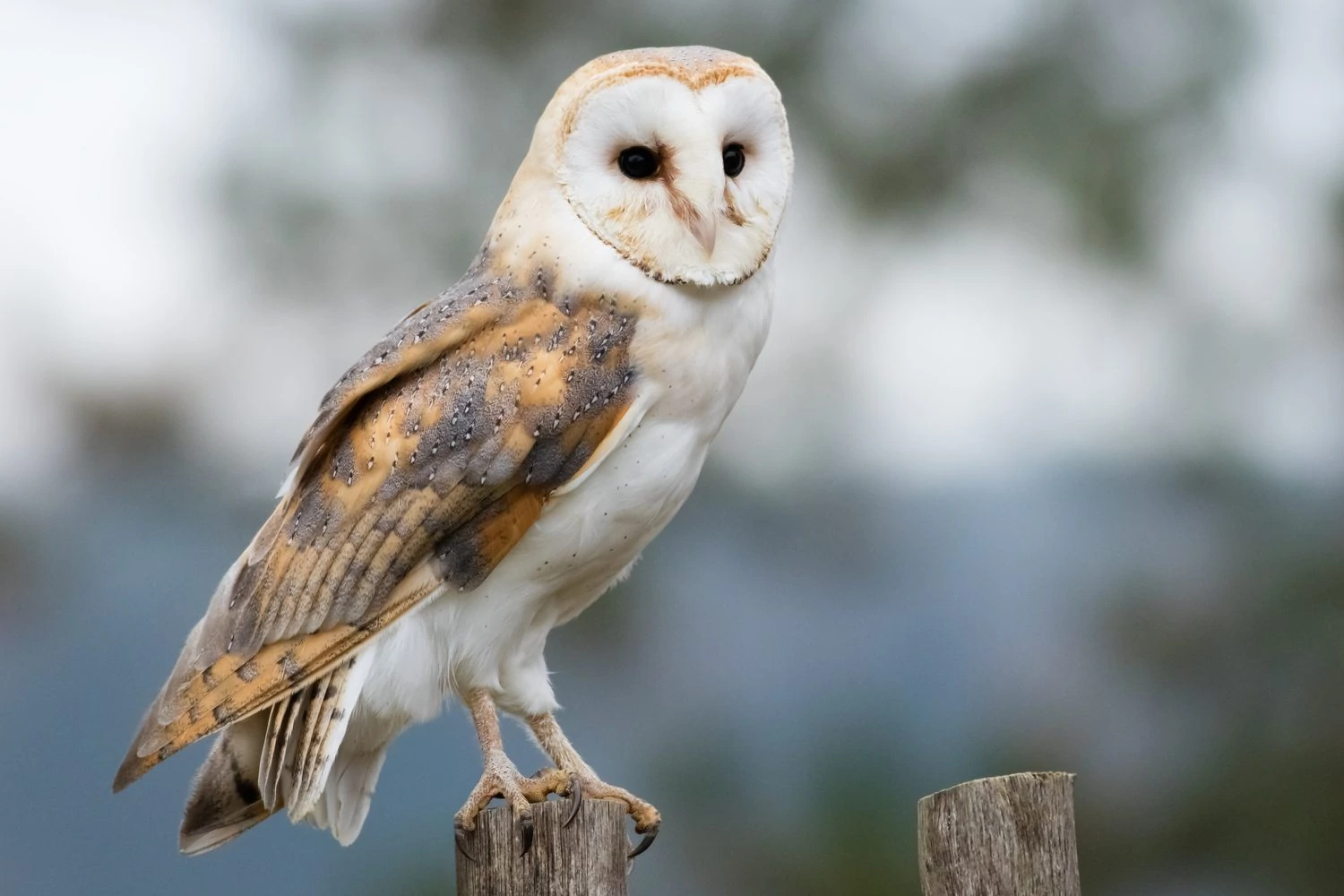
Barn Owls are the most widespread land birds in the world, with as many as thirty-five subspecies and they are found on all continents except Antarctica and the Saharan desert.
Barn Owls’ white heart-shaped faces and contrasting dark eyes make them one of the most beloved owls.
Their chests, bellies, and underwings are also white with varying amounts of spots. Their upperparts are a combination of gray, brown, and red colors, with some being lighter or darker than others. They have long rounded wings, short tails, and long legs.
- Tyto furcata
- Length: 12.6 – 15.8 in (32 – 40 cm)
- Weight: 14.1 – 24.7 oz (400 – 700 g)
- Wingspan: 39.4 – 49.2 in (100 – 125 cm)
Barn Owls do not migrate and can be found in most US states and just across the northwestern border into Canada.
You can find Barn Owls in largely open habitats, edges of forests, agricultural fields and farmlands, suburbs, and cities.
During the day, make sure to look in hollow logs and cavities in trees and in barns (hence their name) where they roost.
Barn Owls predominantly find prey by sound as they have the best hearing of any animal tested. This helps them to catch prey in complete darkness or those hidden under vegetation or snow.
Their usual prey includes small mammals like rats, voles, bats, rabbits, and lemmings. They will also hunt and kill small birds, lizards, and insects.
They swallow their prey whole and cough up pellets containing bones and fur twice a day.
Barn Owl Calls: They don’t hoot, but make a harsh screech.
Nests of Barn Owls are usually in tree cavities or caves and often in barns or other abandoned or quiet buildings. They lay up to eighteen white eggs and up to three broods. The incubation takes around a month.
The nest is made of regurgitated pellets arranged into a cup with their feet.
Fun Facts: Females have spots on their chests that have been shown to reduce parasites, and so the more spots the female has, the more a male helps build the nest!
4. Burrowing Owl
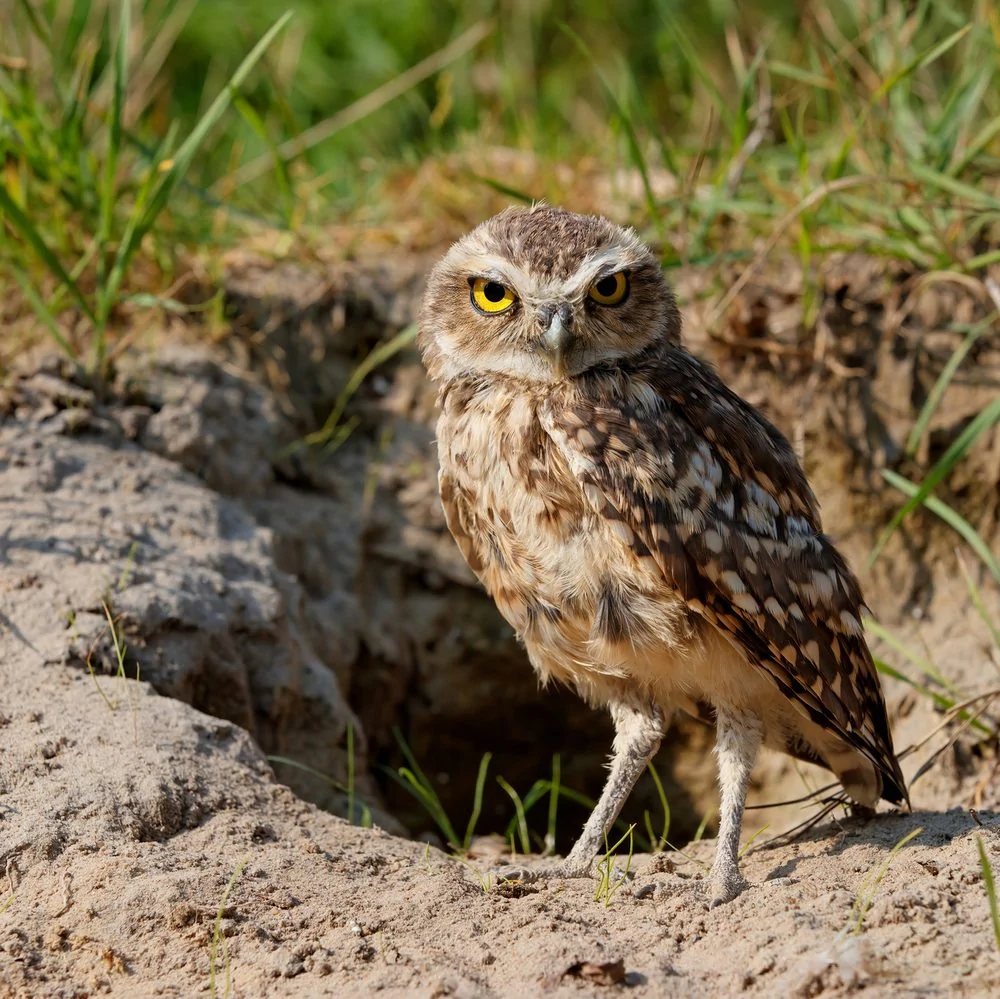
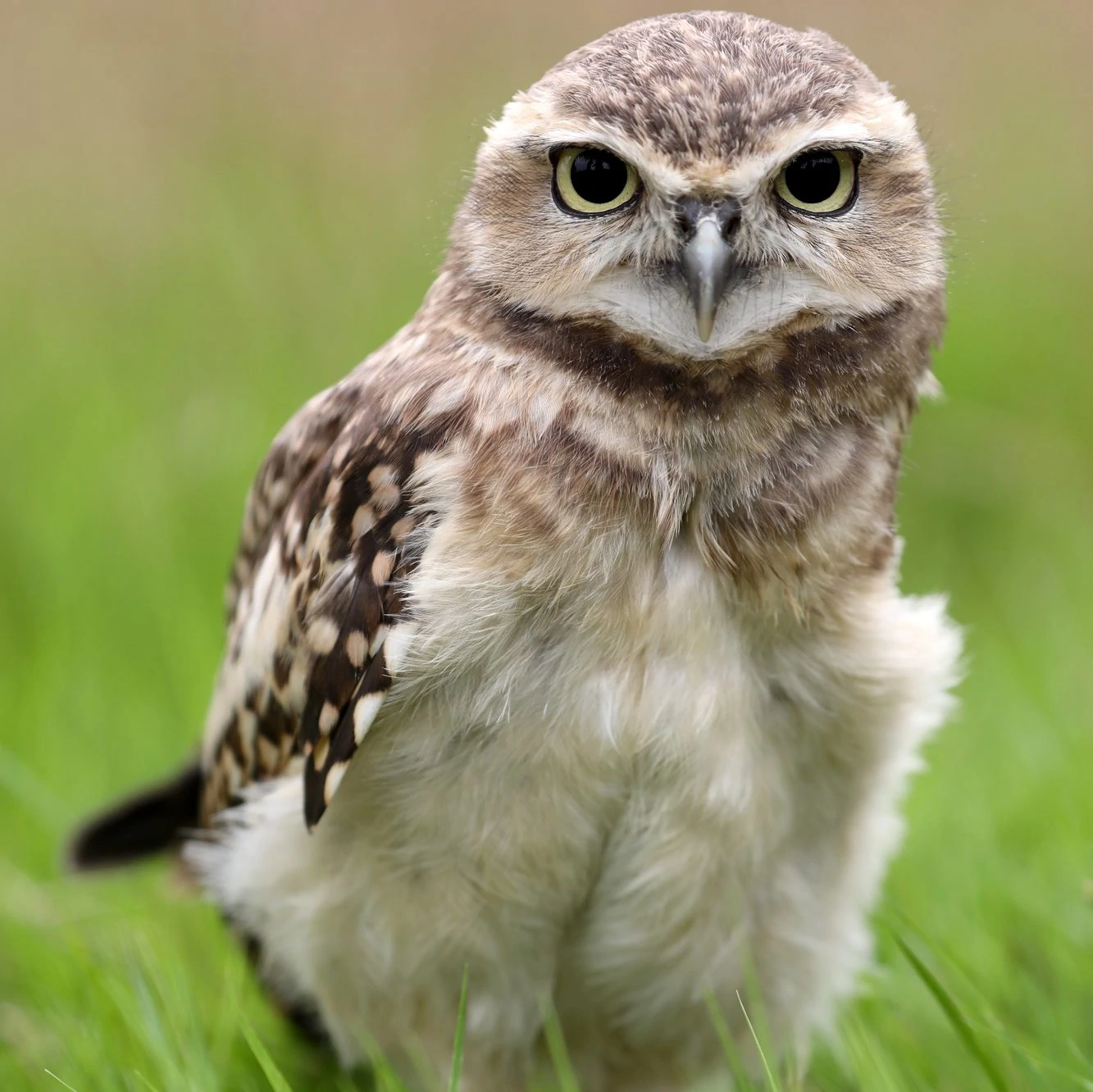
Burrowing Owls are small, long-legged owls that typically lives in prairie dog burrows (hence its name).
Adult Burrowing Owls generally have brown feathers with numerous white spots and no ear tufts.
They have yellow eyes and bills and a white patch on their chins which becomes visible when they bob their heads or when they become agitated.
Juveniles are also generally brown, they have no white spots on their heads, and they have plain white bellies.
- Athene cunicularia
- Length: 9 – 11 in (23 – 28 cm)
- Weight: 5.3 oz (150 g)
- Wingspan: 20 – 24 in (51 – 61 cm)
Burrowing Owls breed in western US states and migrate south to Mexico for winter. Those in southwestern US states and Florida remain all year.
You can find Burrowing Owls in deserts and open grasslands, prairies, and agricultural areas. Rather than looking for them in trees, look for them hunting on the ground, nesting in underground dens, and perching on fence posts.
Burrowing owls hunt both day and night.
They rest in their burrows in between hunting. They sit and wait from their perch and then silently glide to their prey. They catch mice, small rabbits, rats, gophers, bats, lizards, and small birds.
They can run and fly low when hunting on land, but they can also wade through shallow water to catch other animals.
Burrowing Owls calls: They are relatively quiet owls. Males make a coo call, and the young are able to mimic a rattlesnake rasp.
Nests of Burrowing Owls are old, underground holes dug by prairie dogs, badgers, and other burrowing animals. Florida Burrowing Owls dig their own burrows, and Cape Coral has at least 1,000 nesting pairs. They may also use old pipes or nest boxes.
The female lays seven to twelve eggs which she incubates for three to four weeks. The male supports her by bringing food. When the eggs hatch, both parents feed their young and will continue to do so until they’re about three months.
Fun Fact: Burrowing Owls use animal dung or manure to attract insects to the burrow and control the microclimate! The dung or manure that is often used in nest building was originally thought to mask the scent of juvenile owls.
5. Snowy Owl
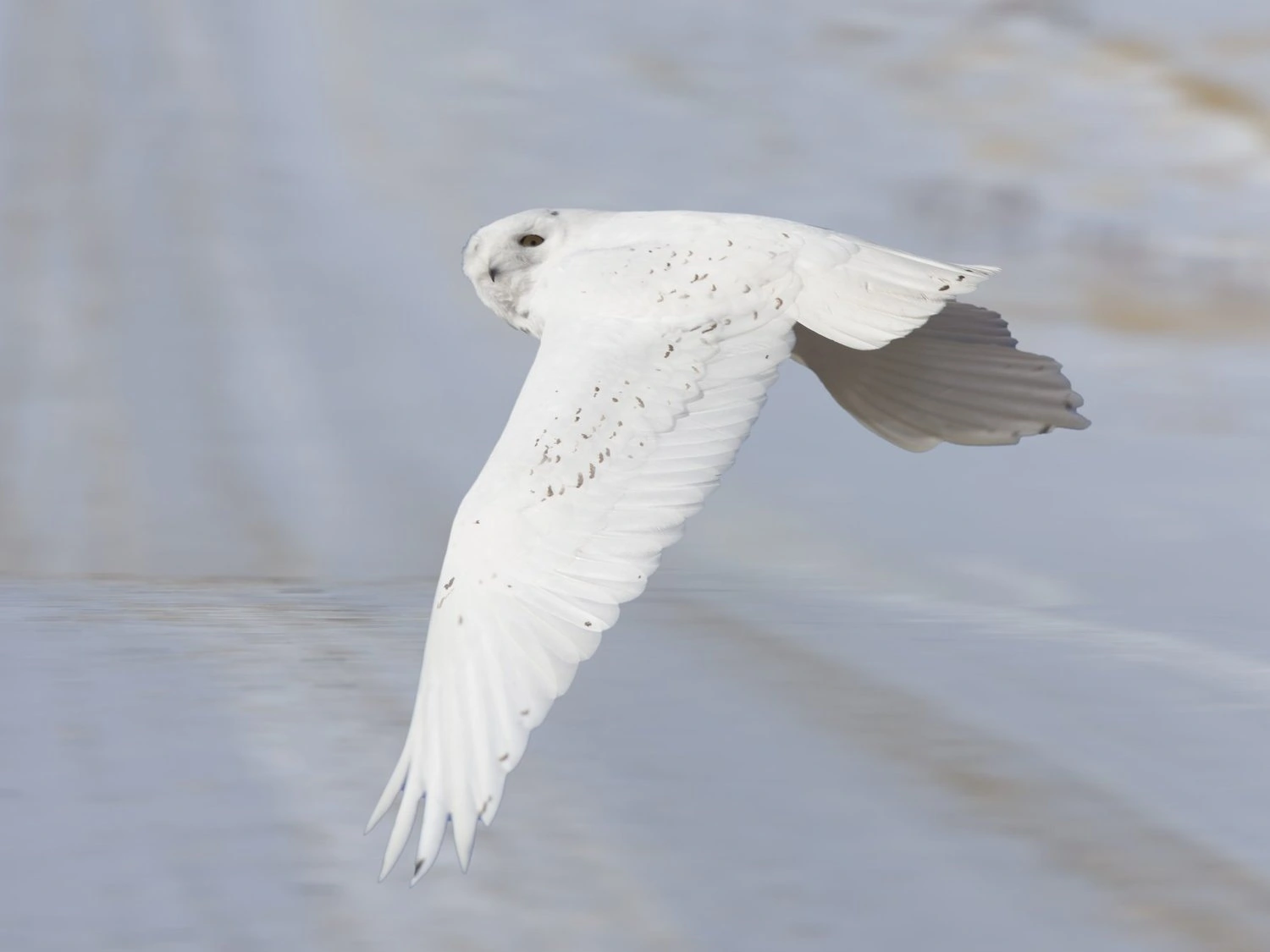
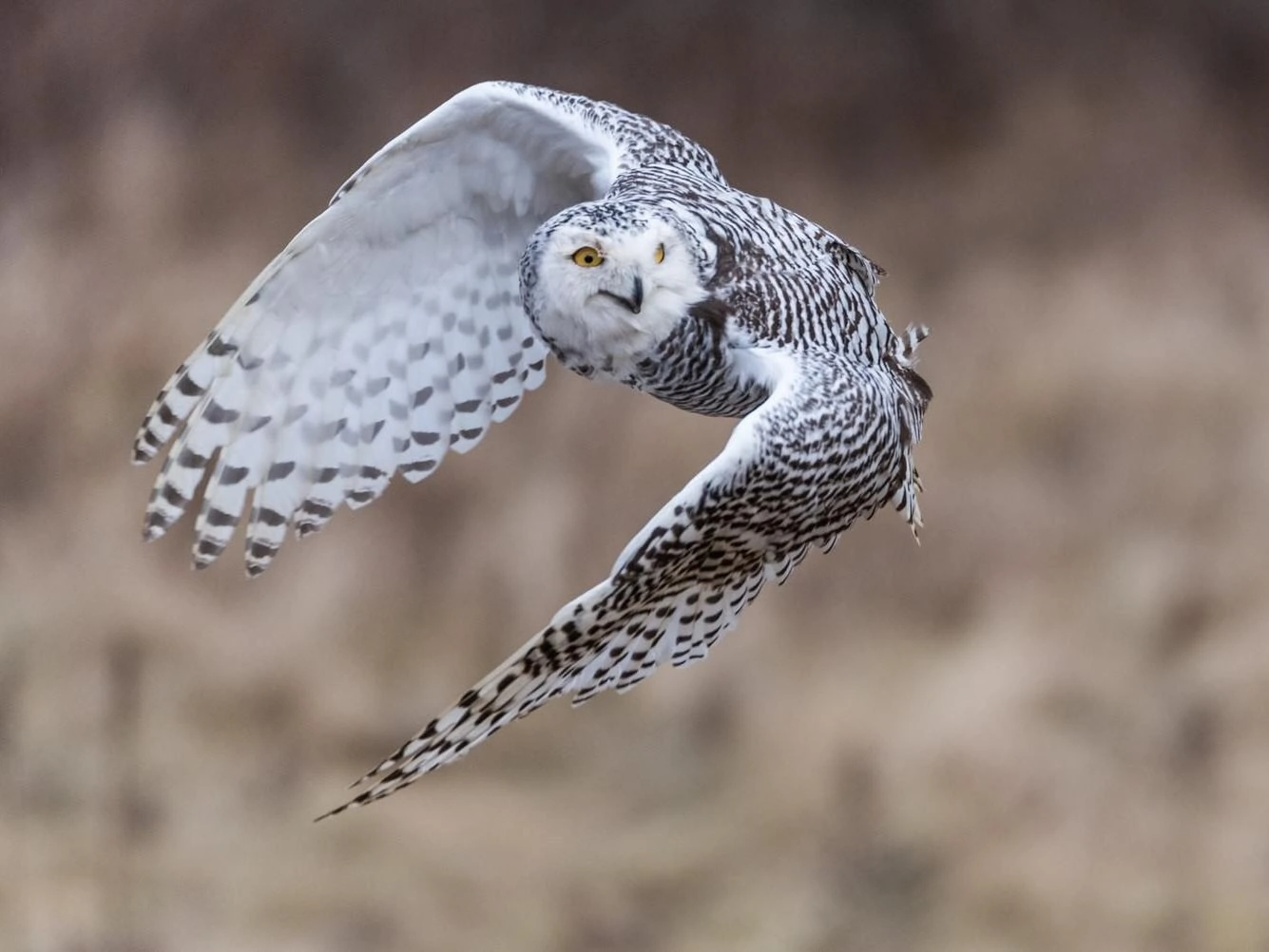
Male Snowy Owls are either white all over or have a small amount of brown spots.
Female Snowy Owls have flecks of dark brown to black on their backs, wings, and flanks, unlike the more white males. They also have thicker and more complete barring on their tails compared to the males.
Snowy Owls have bright yellow eyes, and their legs and feet are fully covered with feathers to protect them from the cold, harsh weather of the Arctic. They have thick dark bars on their wingtips but incomplete bars on their tails.
Juveniles have extensive brown barring all over their bodies except their faces, underwings, legs, and feet.
- Bubo scandiacus
- Length: 20.5-27.9 in (52-71 cm)
- Weight: 56.4-104.1 oz (1600-2950 g)
- Wingspan: 49.6-57.1 in (126-145 cm)
Snowy Owls breed in the arctic around the world, including the north of Canada, and migrate to southern Canada and northern US states.
You can find Snowy Owls in open Arctic tundra and prefer to situate themselves in areas with vantage points like hummocks, ridges, knolls, and bluffs so that they can keep a close watch on their surroundings.
Grassy meadows and marshes are favorite areas for hunting. However, they may move southward for the winter when prey is lacking. They may visit coastal dunes, lakeshores, prairies, and other shrubby environments that are similar to what they have in the Arctic.
Snowy Owls are diurnal, unlike most other owls, and spend the 24-hour summer daylight hunting in the arctic.
They hunt small mammals, especially lemmings, and can eat 1600 in a year.
They also catch birds in flight, such as ptarmigan or waterfowl. In winter, they will eat rodents, rabbits, squirrels, and birds such as ducks and geese.
Snowy Owls calls: They make a strong raspy Hoo sound. They also hoot, whistle, and hiss if threatened.
Nests of Snowy Owls are just scraped, shallow hollows in the ground on one of the raised areas of the tundra. They pick a windswept rise that will be blown free of snow and reuse the nest for many years.
The nests themselves have no insulating materials. The female lays three to eleven eggs at 2-day intervals. Incubation begins as soon as the first egg is laid. Both parents feed the chicks, with the female turning their food into bite-sized pieces.
Fun Fact: The Snowy Owl is also known as the Arctic Owl, the Polar Owl, and the White Owl.
6. Short-eared Owl
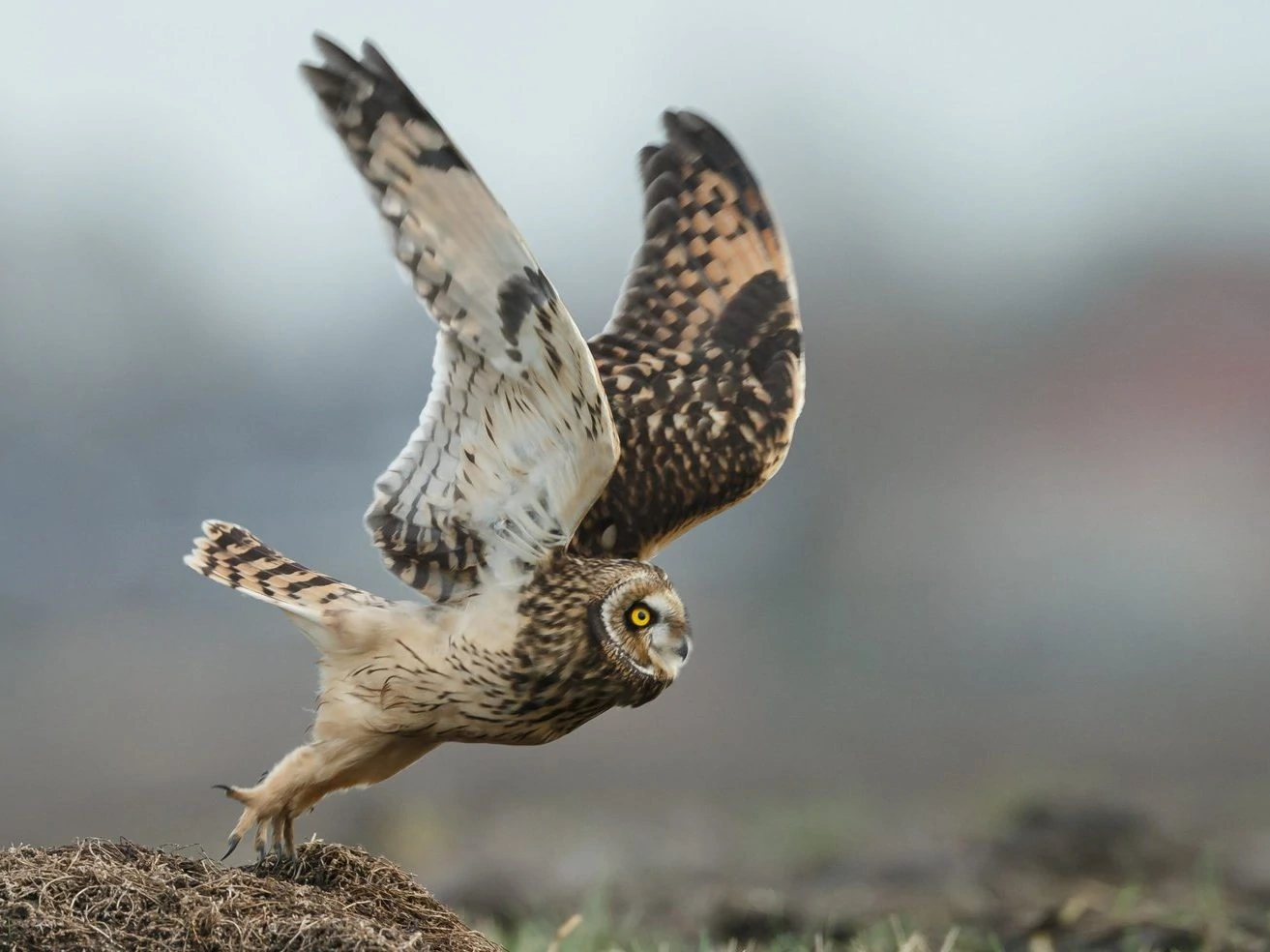
Short-eared Owls are aptly named because they do have short ear tufts, hardly visible except when in a defensive pose.
They are medium-sized, with a large, round, pale facial disk bordered in white. Their eyes are yellow and outlined in black. Their bills are short, hooked, and black.
Their backs and wings are light and dark brown and white mottling. The upper breast is heavily streaked with dark brown, but the chests and bellies are pale or buffy. Their tails are also barred with dark brown.
- Asio flammeus
- Length: 13.4 – 16.9 in (34 – 43 cm)
- Weight: 7.3 – 16.8 oz (206 – 475 g)
- Wingspan: 33.5 – 40.5 in (85 – 103 cm)
Short-eared owls that breed in Canada and Alaska usually migrate to the US for winter, but many remain all year in northern US states.
You can find Short-eared Owls everywhere in the world except for Antarctica and Australia. They particularly like uninhabited areas since they nest and roost on the ground, such as open prairies, coastal grasslands, tundra, marshes, and dunes.
Unlike most owls, Short-eared Owls hunt during the day, mostly at dawn and dusk, timing their hunt when voles are especially active.
They fly low over the ground looking and listening for movement from their prey of small mammals such as voles and mice.
They also eat birds like gulls and shorebirds, and usually take off the wings of the birds before they eat them.
Short-eared Owls calls: They are relatively quiet, but they make a series of continuous hoots and also scream, bark and whine.
Nests of Short-eared Owls are built by scraping the ground into a bowl and lining it with grass and soft feathers. They are usually concealed among tall grasses and low plants, and the female lays four to seven eggs but may lay more if their prey is abundant. Incubation is around four to five weeks.
Fun Fact: Short-eared owls are not very vocal, but during courtship, the males will make about a dozen hoots, and they may bark, whine or scream when defending the nest.
7. Western Screech-Owl
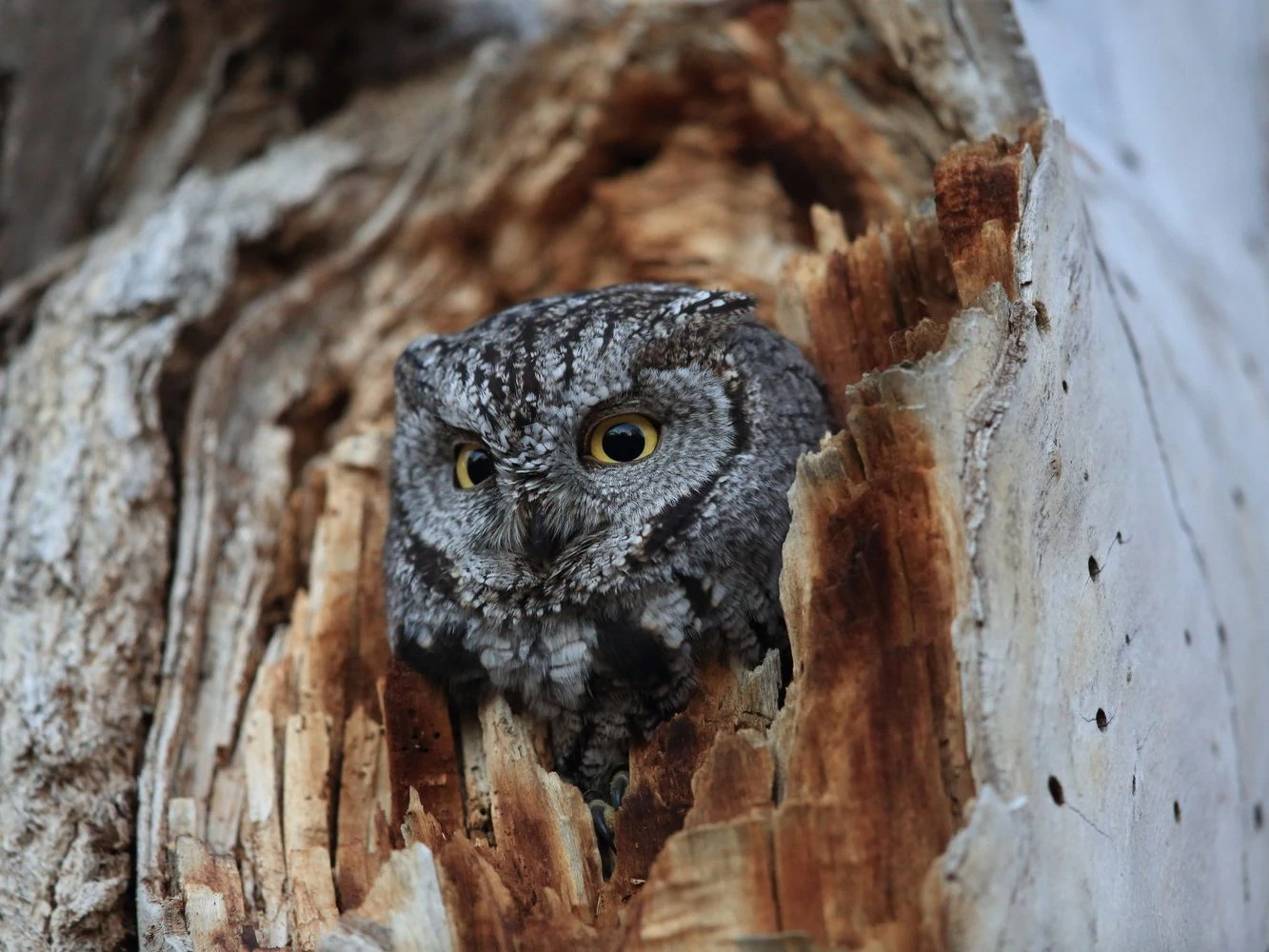
Western Screech-Owls are small owls that have squarish heads with dark outlines and visible ear tufts, and they are short-tailed. Their morphs are either gray, brown, or reddish-brown.
They have yellow eyes and yellowish bills. Their upperparts are dotted with white, gray, or brown streaks. Their breasts and bellies are pale with dark, vertical stripes.
Their coloring and pattern enable them to camouflage themselves against the bark of trees.
- Megascops kennicotti
- Length: 7 – 10 in (18 – 25 cm)
- Weight: 5.4 oz (153 g)
- Wingspan: 20 in (51 cm)
Western Screech-owls do not migrate and are resident of western US states, western Canada, and northern Mexico all year.
You can find Western Screech-Owls in environments as high as 6,000 feet. They live in forested areas, open woods with a mixture of pine, oak, and sycamore, and may also be found in the desert, rural fields, and suburban parks and gardens.
Western Screech-Owls are opportunistic feeders and eat small mammals, birds, fish, insects, and even scorpions.
They are wait-and-see predators, taking their time watching from their perch on tree branches and looking out at the ground or water for their prey.
Western Screech-Owls calls: Their distinctive speeding-up hoot sounds like a bouncing ball coming to a stop.
Nests of Western Screech-Owls are usually abandoned nests by woodpeckers or any natural cavities in trees, cliffs, and banks. The female lays two to seven eggs and incubates them for four to five weeks.
When the eggs hatch, the female stays with them for up to three weeks, and then she hunts with the male.
Fun Fact: While roosting during the day, Western Screech-Owls try to blend in with their surroundings, so they press themselves against the tree to be camouflaged against it.
8. Northern Saw-whet Owl
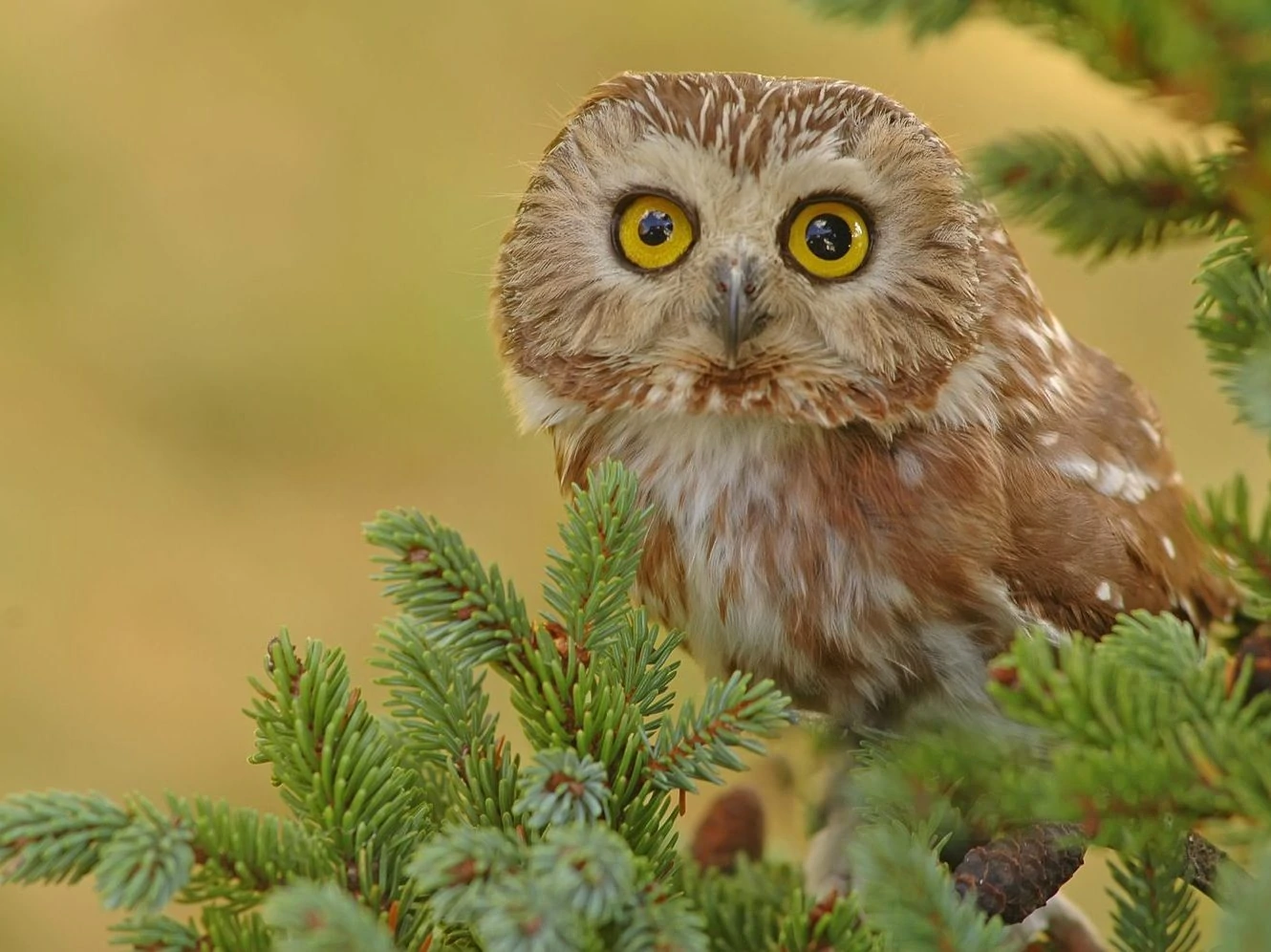
Northern Saw-whet Owls are one of the smallest owls in North America, with them being about the size of a robin.
They have tiny brown bodies but large round heads with fine white streaks. Their eyes are bright yellow with thick white feathers forming a “Y” in between them.
Their backs and wings are brown with white spots. Their chests and bellies are white with brown streaks.
Juveniles have plain brown heads and very visible white eyebrows on brown facial discs. Their underparts are plain cinnamon brown, and they also have no spots on their backs.
- Aegolius acadicus
- Length: 7.1 – 8.3 in (18 – 21 cm)
- Weight: 2.3 – 5.3 oz (65 – 151 g)
- Wingspan: 16.5 – 18.9 in (42 – 48 cm)
Northern Saw-whet Owls are usually resident all year in Canada, northern US states, and western US states. However, they may migrate to lower areas in winter to the rest of the US.
You can find Northern Saw-whet Owls in dense coniferous forests where they roost hidden among the thick branches and foliage. However, they like it near an open area and water source where they hunt.
They are nocturnal, so they hunt mostly mice from a perch at night. They may also eat voles, bats, chipmunks, and squirrels.
Northern Saw-whet Owls calls: A long series of urgent hoo calls.
Nests of Northern Saw-whet Owls are tree cavities that have been left from other species, such as Pileated Woodpeckers. They do not add any other nesting material and instead lay their eggs directly on the debris.
The female lays four to seven eggs that take four weeks to incubate. The male’s job is to bring the female food while she’s incubating.
Attracting Northern Saw-whet Owls to your backyard is possible with a nest box if you are in range and have lots of trees.
Fun Fact: The Northern Saw-whet Owl got its name from its repeated tooting whistle, or the “skiew” sound that it makes when it’s alarmed or threatened. The sound is similar to the whetting of a saw.
9. Northern Pygmy-Owl
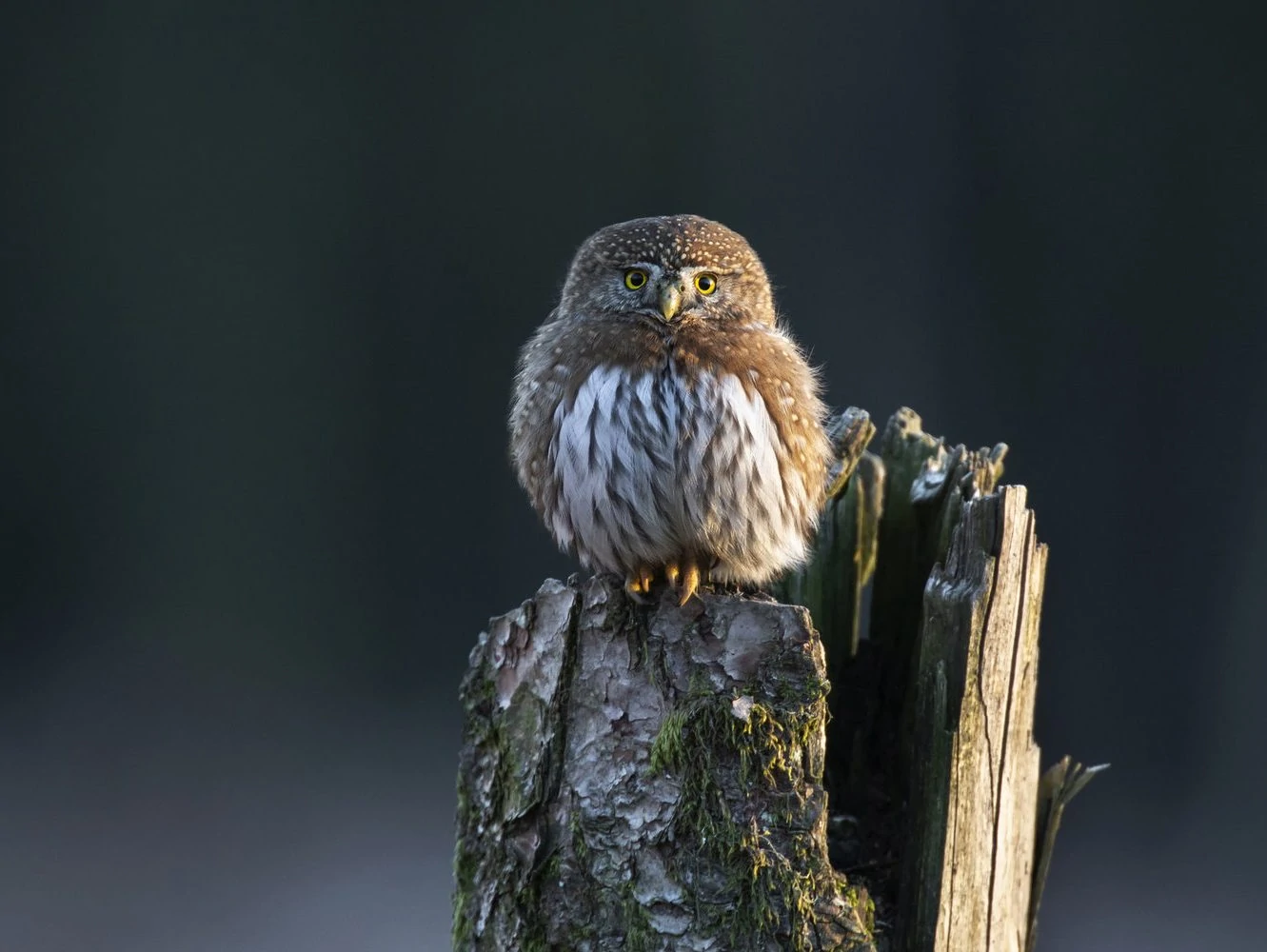
Northern Pygmy-Owls are small and compact, with large round brown heads. Their eyes are yellow, as are their bills. Their backs, wings, and breasts all have white spots on brown feathers, but their bellies are white with dark brown vertical stripes.
One unique feature of Northern Pygmy-Owls is that they have white-bordered black spots at the back of their heads that kind of look like an extra pair of eyes. There are also red morphs and gray morphs.
- Glaucidium californicum
- Length: 7 – 7.5 in (18 – 19 cm)
- Weight: 2/2 oz (62 g)
- Wingspan: 12 in (30 cm)
Northern Pygmy-Owls do not migrate and are resident in western regions from British Columbia down to Mexico.
You can find Northern Pygmy-Owls mostly in forests along streams with fir, spruce, cottonwood, aspen, and other mixed trees.
During winter, it’s possible that Northern Pygmy-Owls may be seen in towns and backyards, hunting songbirds flocking at bird feeders.
Northern Pygmy-Owls are active hunters during the day, adapting a “wait and see” strategy when choosing and tracking their prey.
They feed on small mammals, birds like hummingbirds, chickadees, warblers, and sparrows, and insects like beetles, butterflies, crickets, and dragonflies, which they can sometimes catch in mid-flight.
Northern Pygmy-Owls calls: A series of high ‘toots’.
Nests of Northern Pygmy-Owls are often the abandoned nests of woodpeckers or empty cavities in trees. The female lays up to seven eggs and incubates them for about a month. The male takes care of feeding the female and the chicks once they hatch.
Fun Facts:
10. Long-eared Owl
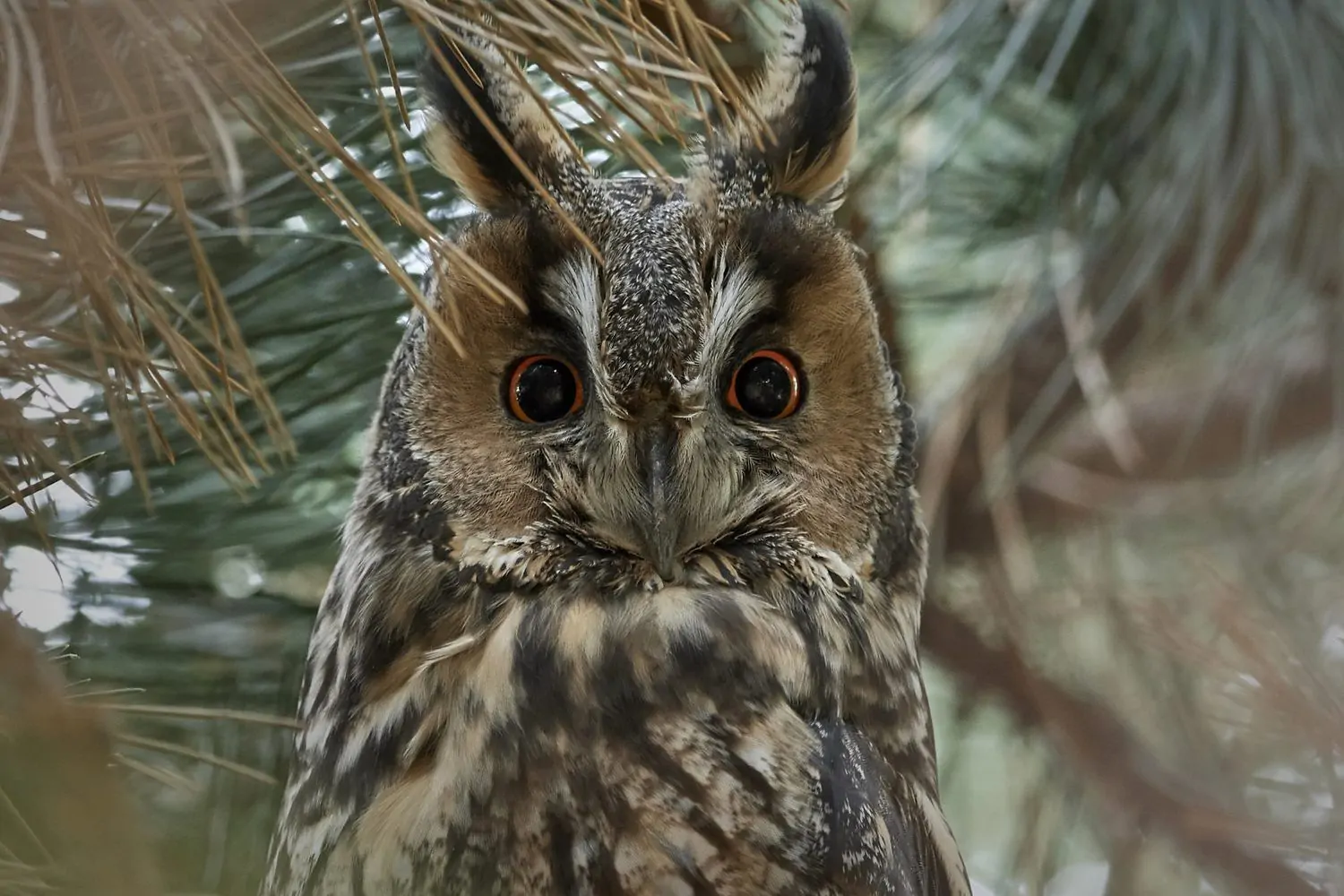
Long-eared Owls are slender, medium-sized owls known for their obvious ear tufts, hence their name. They look similar to Great Horned Owls but are much smaller, and the ear tufts are closer together.
They have a surprised expression due to their facial disc and mustache-like feathers around their bill.
Their upperparts are mottled gray, brown, white, and buff. Their underparts have a unique cross-barred pattern of varying orange, brown, black, and white. Their tails are white with dark brown barring.
They are darker in eastern US states and lighter in the west.
- Asio otus
- Length: 13.8 – 15.8 in (35 – 40 cm)
- Weight: 7.8 – 15.3 oz (220 – 435 g)
- Wingspan: 35.4 – 39.4 in (90 – 100 cm)
Long-eared Owls breed in Canada and northern US states and migrate to the rest of the US and Mexico for winter. However, some remain resident all year, especially in inland western US states.
You can find Long-eared Owls in wooded areas with dense coniferous or deciduous trees for roosting and near open grasslands for hunting. The thick foliage of these trees helps camouflage them from potential predators.
Small mammals such as voles, mice, young rats, and rabbits are the main prey of Long-eared Owls, but they may also eat small birds
They fly just a few feet off the ground, listening for movement of prey.
Long-eared Owls calls: They are relatively silent owls but make slow, steady ‘whoo’ calls during the breeding season.
Nests of Long-eared Owls are often stick nests abandoned by other species, or they use tree cavities or hollows.
The female lays up to ten eggs and incubates them for about four weeks. It takes around three weeks for the chicks to start “branching” out even though their parents will still feed them at this point.
Fun Fact: Long-eared Owls are rarely heard except during breeding time. They make soft low hoots and whistles, whines, shrieks, and cat-like meows.
11. Elf Owl
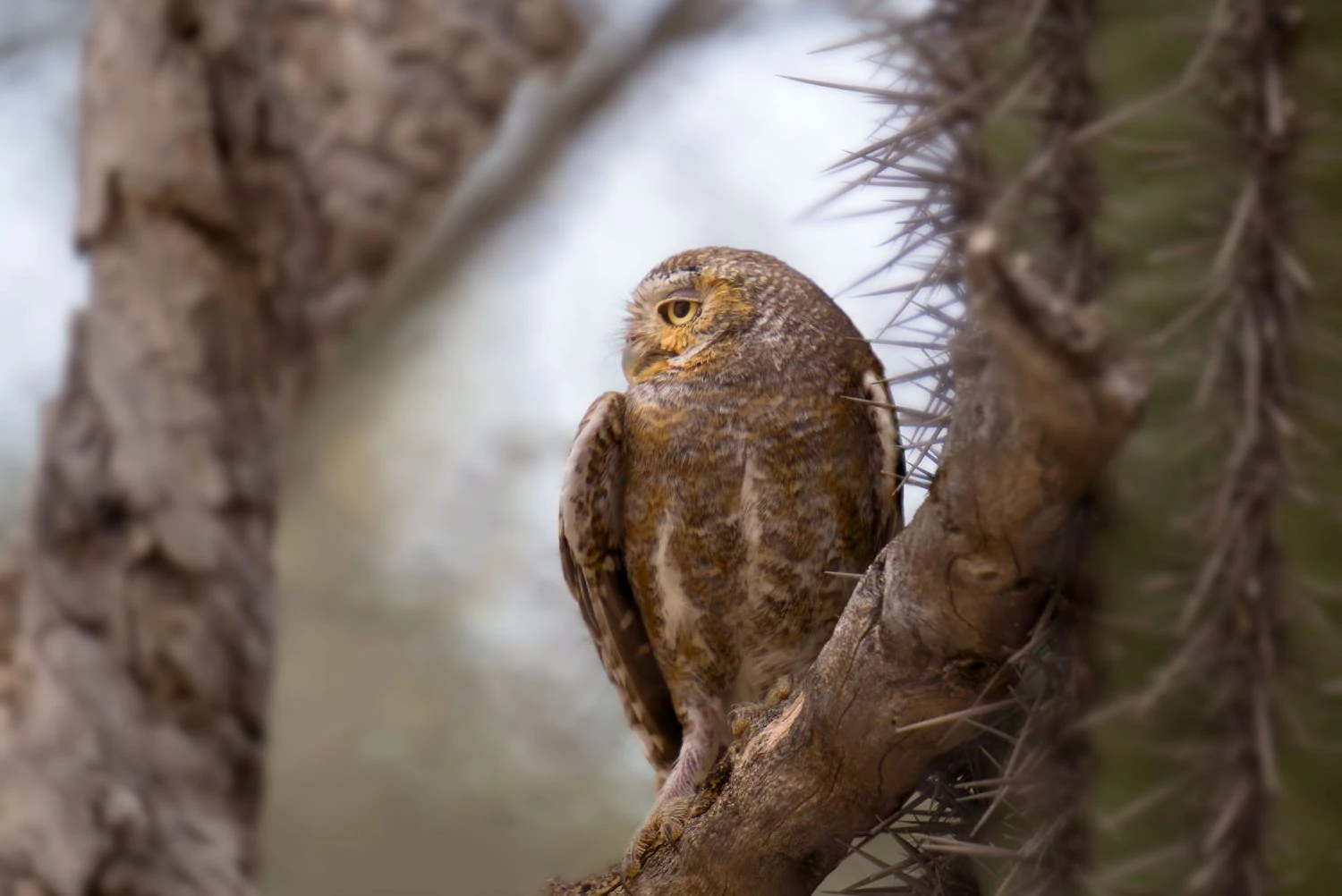
Elf Owls are tiny desert owls that are team players that will band together to deter predators.
They are usually brown and spotted with gray, cinnamon, brown, and white, and they don’t have any ear tufts, so their heads appear round and big.
The Elf Owl is the world’s smallest owl.
They have pale yellow eyes bordered with thin, white eyebrows and short tails. Juveniles are grayer than adults but otherwise the same.
- Micrathene whitneyi
- Length: 5 – 6 in (13 – 15 cm)
- Weight: ¼ oz (40 g)
- Wingspan: 15 in (38 cm)
Elf Owls breed in southwestern US states and northern Mexico before migrating further south for winter.
You can find Elf Owls primarily in deserts with plenty of giant saguaros or tree-like cacti that grow to over 12 meters tall. Aside from desert environments, they also inhabit thorn scrubs and woodlands near the banks of rivers or lakes with mesquite and other similar trees.
Elf owls are nocturnal by nature, so they do their hunting at night. They have incredible vision and hearing, which allow them to catch insects in mid-air, pluck them from vegetation, like moths and insects that are found in agaves and ocotillos, and they also chase their prey, such as lizards on foot.
They can even eat scorpions, but they remove their stingers before they swallow them.
Elf Owl calls: They make several calls, either softer when nesting or sharp in alarm. Males also sing a yapping-sounding series of notes.
Nests of Elf owls are in abandoned woodpecker holes in trees, in giant cacti, or in nest boxes and just leave it bare.
The female lays up to five eggs and incubates them from fourteen to twenty-four days. It’s the male’s responsibility to keep his family fed while the female takes care of the young.
Attracting Elf Owls to your backyard is possible if your house is within their range. Place the nest box high enough (72-120 inches) and face it north or northwest.
Fun Fact: Elf Owls practice “mobbing” or grouping together with other Elf Owls to overwhelm predators like snakes, mammals, and other larger owls.
12. Great Gray Owl
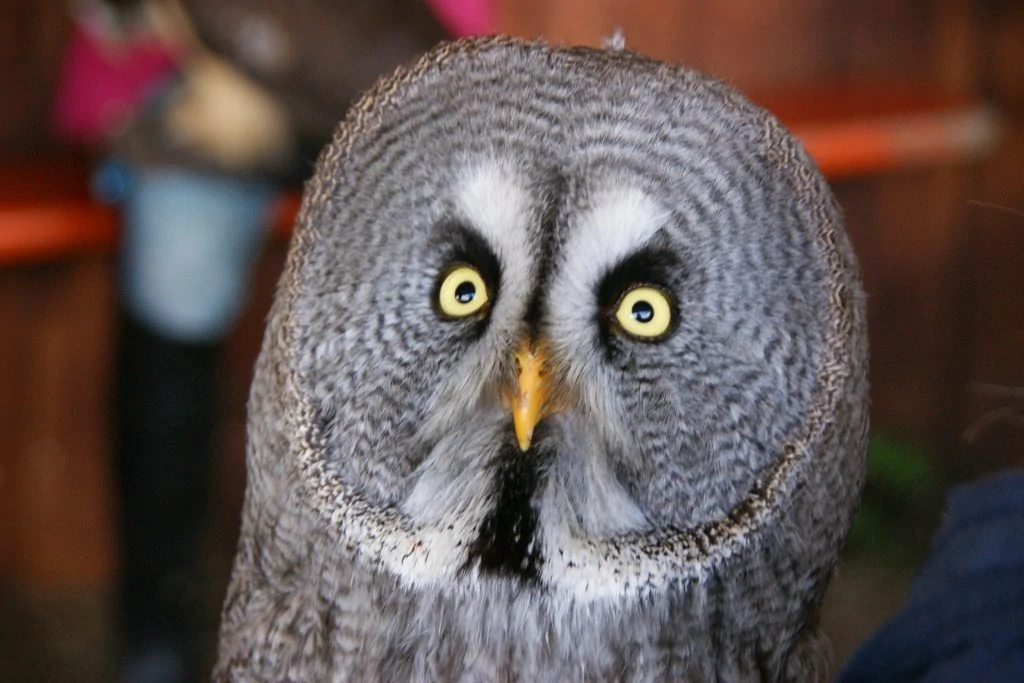
The Great Gray Owl deserves the title of “Great” because it has a large head and has the largest facial disk among birds of prey, and a tail that’s a foot long. Its actual body may be small, but its feathers are thick and fluffy, making it look bigger than it really is.
They have long wings and tails, earning them the title “World’s Largest Owl”
Great Gray Owls are generally silvery gray with some pale gray, brown, and white streaks. They have large round heads, small yellow eyes, a hooked bill, and a white collar just under the bill. They do not have any ear tufts.
- Strix nebulosa
- Length: 24 – 33 in (61 – 84 cm)
- Weight: 27.2 oz (771 g)
- Wingspan: 54 – 60 in (137 – 152 cm)
Great Gray Owls do not migrate but may move around in some years looking for food. They are resident in Canada, Alaska, northwestern US states, and down the Pacific Coast.
You can find Great Gray Owls in dense, wet, evergreen forests. They usually hunt in open meadows with scattered trees. Bogs are also hunting grounds, and you can find them in mixed pine and oak forests.
Great Gray Owls are night hunters. First, they listen and wait at their perches. When they’ve targeted their prey, they swoop down and capture them, if in the open.
Their large facial disks give them excellent hearing that allows them to identify prey even under two feet of snow.
If their prey is under snow, they “snow-plunge” their way in to grab their prey.
Prey usually includes small mammals like voles, gophers, mice, chipmunks, and lemmings. Sometimes, they may also feast on ducks, jays, and quail.
Great Gray Owl calls: The hoo calls of the Great Gray Owl are made by males and females.
Nests of Great Gray Owls are usually in abandoned stick nests of other large birds, like hawks, ravens, or crows. They don’t build their own nests or add anything else to repair the existing nest.
Female Great Gray Owls may lay two to five eggs but may not nest at all if their food is scarce. However, when the female does lay eggs, she will incubate them for about a month, and it takes about another month for the young to leave the nest.
Fun Fact: Great Gray Owls although they look large they are actually quite small under all those feathers and so only catch small prey such as rodents.
13. Whiskered Screech-Owl
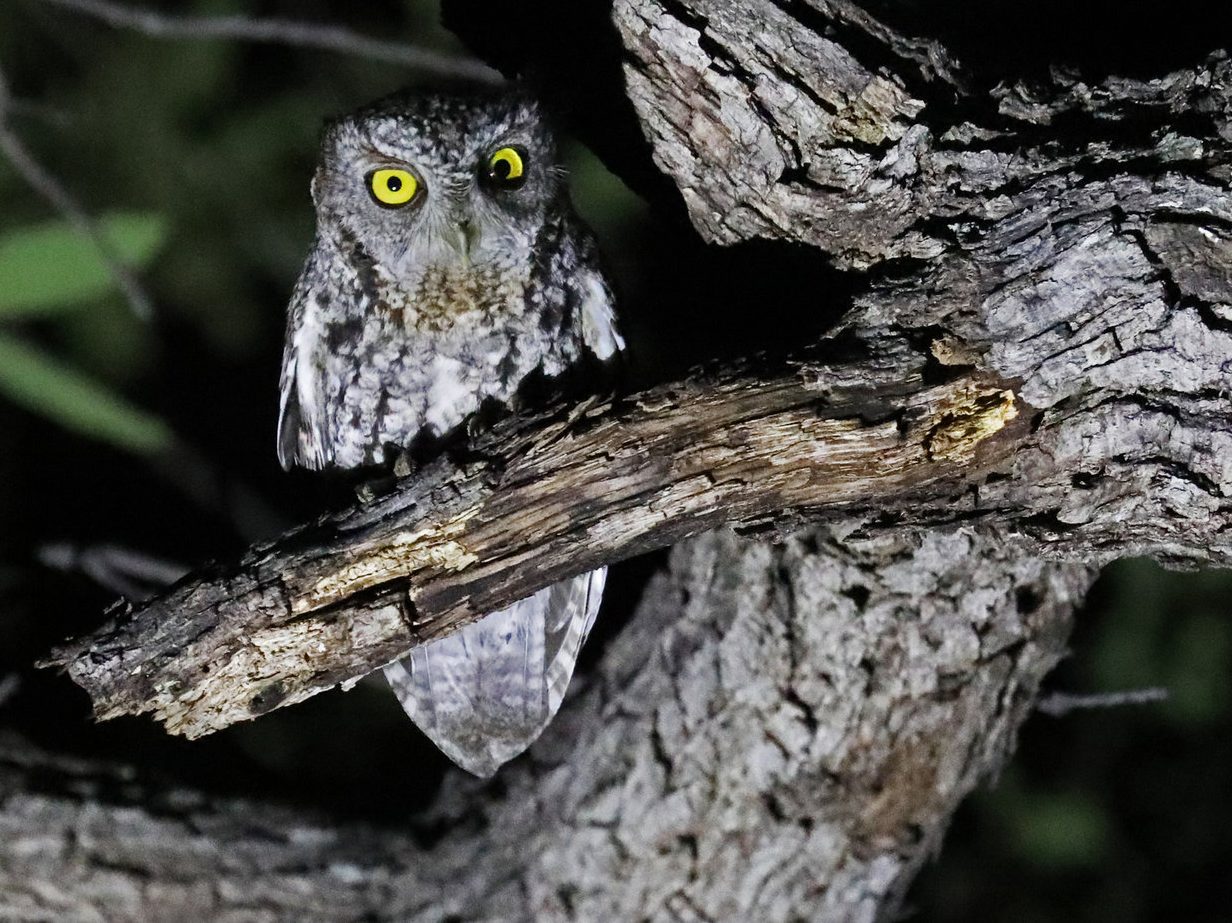
Whiskered Screech-Owls are small owls that have rounded heads and short ear tufts. They have large, yellow eyes and long whiskers at the base of their grayish-yellow hooked bill. Their legs and feet are feathered.
The Whiskered Screech-Owl is often mistaken for the Western Screech-Owl because they look very similar. However, the Whiskered Screech-Owl is smaller in size and has thicker vertical stripes on its belly.
They have dark-gray and reddish-brown morphs.
- Megascops trichopsis
- Length: 6.5 – 8 in (17 – 20 cm)
- Weight: 3 oz (85 g)
- Wingspan: 17.5 in (44 cm)
Whiskered Screech-Owls do not migrate and are resident all year in Mexico and across the border into southwestern US states.
You can find Whiskered Screech-Owls in dense pine-oak woodlands at 5,249 feet (1,600 meters) elevation. They also inhabit canyons with groves of sycamores which may be near oak woodlands. You may see them with Western Screech-Owls when they go to lower elevations during winter.
Whiskered Screech-Owls usually forage between branches of trees for insects, like grasshoppers, praying mantises, crickets, beetles, moths, and caterpillars. They will also hunt their prey from their perch or capture them in flight.
Whiskered Screech-Owl calls: They make a long series of fast hoots.
Nests of Whiskered Screech-Owls are often in abandoned woodpecker holes, empty tree cavities, or holes in cacti.
They may also stay in nest boxes with the appropriate entrance and about 10 to 30 feet above the ground.
The female lays around two to four eggs and incubates them by herself. During this time, the male supports her by feeding her and defending their territory. Once the eggs hatch, the female will also join in the hunt for food.
Fun Fact: The Whiskered Screech-Owl is also called the Arizona Whiskered Owl, Spottech Screech-Owl, and Whiskered Owl. Its whiskers define it because they’re longer and denser than any other owl.
14. Flammulated Owl
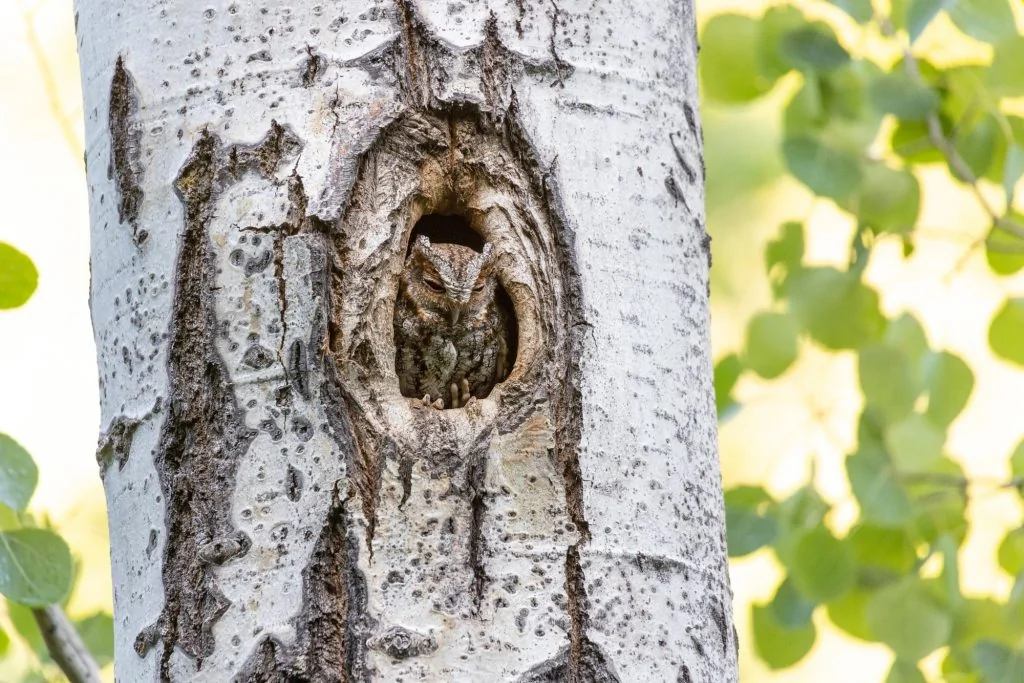
Flammulated Owls are small owls that are either gray or rufous and are well-camouflaged against the trees.
Their heads have a rectangular shape, and they are the only small owls that have dark eyes (the others have yellow eyes). The reddish-brown coloring on their facial disk contrasts against the white eyebrows and dark eyes.
- Psiloscops flammeolus
- Length: 6 – 7 in (15 – 18 cm)
- Weight: 1.9 oz (54 g)
- Wingspan: 13 in (33 cm)
Flammulated Owls breed in western US states, southwestern Canada, and northern Mexico before migrating further south for winter.
You can find Flammulated Owls in forests. They prefer habitats with open, mature trees, especially when there’s an abundance of natural nesting holes.
An unusual trait of Flammulated Owls is that they eat mostly insects, not mammals, particularly moths, crickets, grasshoppers, bugs, and beetles.
Since their preferred habitat is in high treetops, they forage for insects among the trees’ foliage or in the lower shrubs. They may occasionally eat small rodents, which they snatch from the ground.
Flammulated Owls calls: They make a variety of calls, peeps, hisses, and screams. Males also make a low hoot.
Nests of Flammulated Owls are almost always abandoned woodpecker holes. If no woodpecker holes are found, any natural tree cavity will do. They also use nest boxes which are intended to replace the fast-disappearing natural cavities in trees.
Flammulated Owls are monogamous, having one mate for many consecutive breeding seasons.
They also use their previous nest territories. The female lays two to three eggs that take about twenty-three days to hatch. The male cares for the female and brings her food. When the eggs hatch, their parents will still take care of the young owls until they’re five weeks old.
Fun Fact: The Flammulated Owl gets its name from the Latin word “flammeolus” meaning flame-colored or with flame-like markings.
15. Spotted Owl
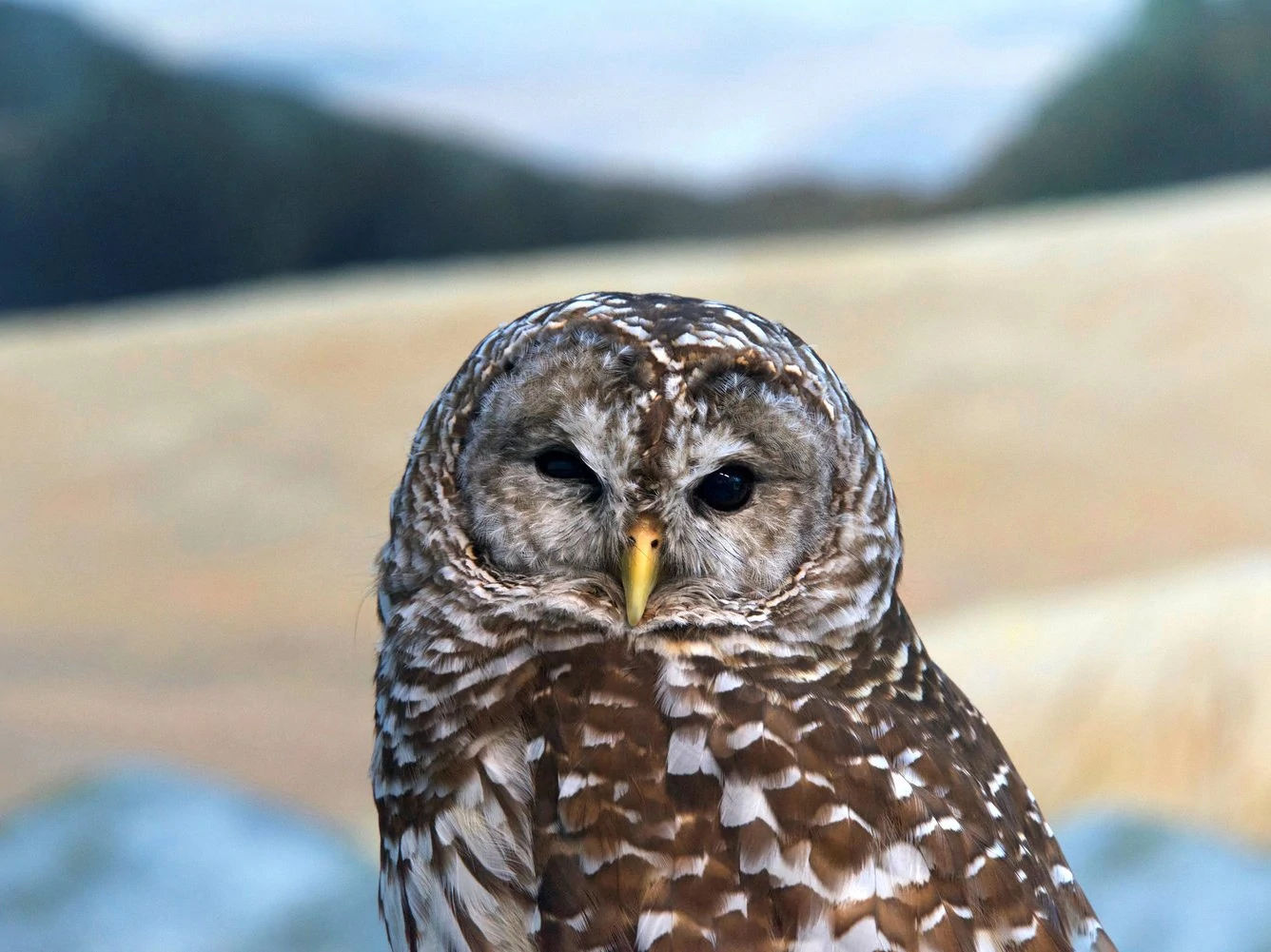
Spotted Owls are medium-sized and dark brown with white spots. The further south the species, the paler their coloring and the larger their white spots become.
Its facial disk is quite defined with a dark border. It has white eyebrows and whiskers, dark eyes, and a hooked yellow bill. Its back and wings are dark-brown with white spots. Its belly is dark-brown with white horizontal lines or bars.
There are three subspecies in North America, the Northern Spotted Owl, California Spotted Owl, and Mexican Spotted Owl. They differ slightly in how dark they are and the size of their spots.
- Strix Occidentalis
- Length: 16 – 19 in (41 – 48 cm)
- Weight: 20.8 oz (589 g)
- Wingspan: 40 in (102 cm)
Spotted Owls do not migrate and are resident all year along the Pacific Coast and southwestern US states.
You can find Spotted Owls in old, mature, dense forests with a lot of canopy cover. It prefers environments with old, large trees, which is why it’s considered a “Near Threatened” species due to habitat loss from timber logging.
Spotted owls mostly feed on small to medium-sized prey such as flying squirrels and dusky-footed woodrats. Other prey includes mice, red tree voles, snowshoe hares, gophers, and bats. They may also target small owls, birds, amphibians, and insects.
Spotted Owl Calls: As they are a threatened species, the calls of Spotted Owls are restricted to help prevent their decline. However, they do make hoot, like many owls.
Nests of Spotted Owls are mostly in abandoned nests or cavities in trees. They make sure that a dense cover from the treetops protects the nest and the young.
While the male selects the nesting site, the female makes it her own by adding a few feathers or materials to the nest. She will lay up to four eggs which incubate for about a month.
The male will tend to her, bringing her food while she incubates their young.
Fun Fact: The spotted owl looks similar to the barred owl, but the spotted owl has horizontal lines and the barred owl has vertical streaks.
16. Northern Hawk Owl
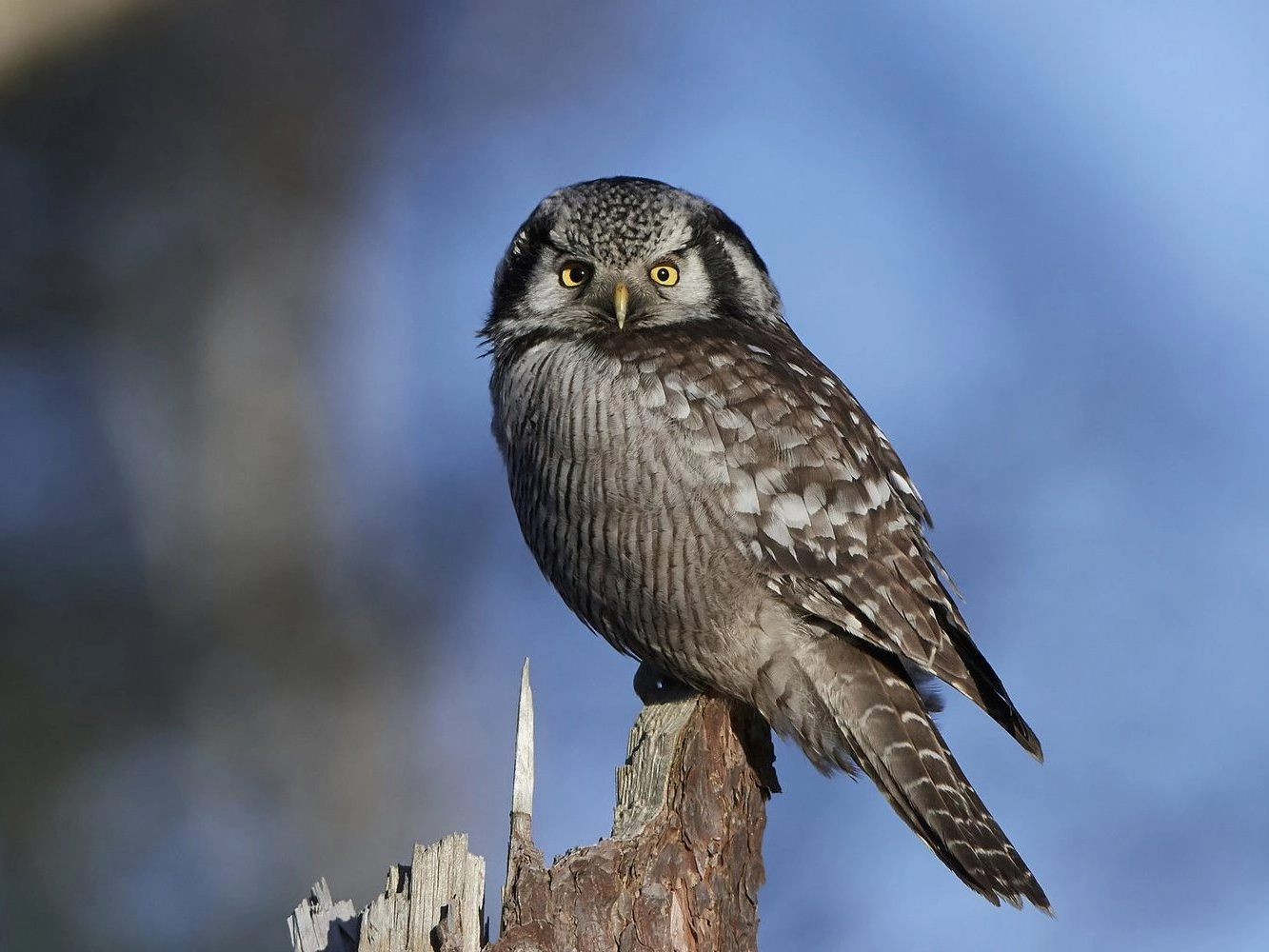
Northern Hawk Owls have white faces that are outlined by thick black lines, and their eyes and bills are yellow. Their backs and wings are brown with white spots.
Their breasts and bellies are white with horizontal brown stripes, and their tails are long and brown with white horizontal lines. Their legs and feet are fully feathered.
Juveniles have the same features, except that they’re paler and fluffier.
- Surnia ulula
- Length: 14.5 – 17.5 in (37 – 44 cm)
- Weight: 10.5 oz (298 g)
- Wingspan: 33 in (84 cm)
Northern Hawk Owls do not migrate and are mainly resident in the cold north in Canada and Alaska.
You can find Northern Hawk Owls in open pine and spruce forests or those mixed with larch, birch, poplar, and willow. They also favor burned areas of forests because these are good nesting sites.
Northern Hawk Owls primarily feed on mammals, particularly voles, during the summer. During the winter, they shift their diet to eating ground-dwelling birds, like ptarmigan and grouse.
Unlike most owls, Northern Hawk Owls are day hunters
Northern Hawk Owls calls:
Nests of Northern Hawk Owls are usually on broken, open tree stumps or in abandoned woodpecker holes or decayed hollows. Both parents scout their nesting area and prefer locations in open forests with scattered trees, usually near the water.
The female lays up to thirteen eggs and incubates them for about a month while the male looks for food to feed her. Once the eggs hatch, parenting roles shift.
The female is then the one who hunts, and the male tends to the nest. When the young leave the nest, the female once again takes over tending duties, but the male will still be around to provide food for his family.
Fun Fact: Northern Hawk Owls have ‘hawk’ in their name because they look hawk-like and hunt in the day.
17. Boreal Owl
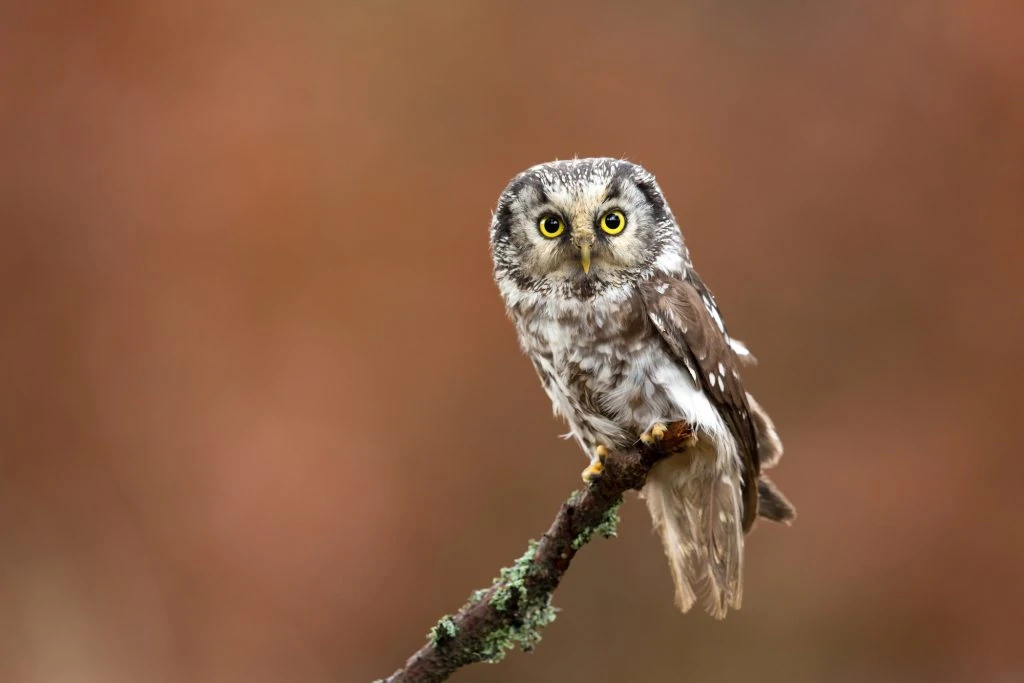
The Boreal Owl is a rather small owl with a large square head.
Adult Boreal Owls are generally brown. They have white spots on their heads and back. Their faces are grayish or whitish, bordered by black or brown.
They have bright, yellow eyes and light yellow beaks. Their bellies are white but with vertical, brown streaking.
Adults look similar, but females are heavier. Juveniles are chocolate brown, and they don’t have white spots on the crown and back.
- Aegolius funereus
- Length: 9 – 10 in (23 – 25 cm)
- Weight: 3.6 oz (102 g)
- Wingspan: 20 – 26 in (51 – 66 cm)
Boreal Owls do not migrate and predominantly live in Canada and northwestern US states.
You can find Boreal Owls, as their name suggests, in the boreal or northern coniferous forests of North America.
They normally live in forests or high-elevation mountains with spruce, aspen, poplar, birch, and fir trees.
Boreal Owls are night-hunters, but in some areas, like those where nights are short, they have no choice but to hunt in daylight.
They hunt small mammals, birds, and insects, waiting from their perches and attacking them with their talons. They normally feed on voles, mice, shrews, bats, frogs, and squirrels.
Boreal Owl Calls: Male Boreal Owls sing a series of whistled toots. They also make short calls.
Nests of Boreal Owls are made by males, and then females choose from among the nest sites that he shows her. These nests are often old woodpeckers’ holes.
The female lays three to seven eggs and starts incubating them after the 2nd egg is laid for around a month. The male brings food to the female all throughout the nesting period.
Attracting Boreal Owls to your backyard is possible with nest boxes as will often use them in the absence of natural cavities in trees.
Fun Fact: One ear opening of Boreal Owls is much higher than the other to help them judge the distance and height of sound to find prey.
18. Ferruginous Pygmy-Owl

Ferruginous Pygmy-owls typically have brown backs and wings with a few white spots. Their heads are lighter in color with white streaks, and they don’t have any ear tufts.
Their eyes are lemon-yellow, like their hooked bills.
One unique physical feature of the Ferruginous Pygmy-owl is the marking on its nape that resemble eyes. They have two black patches outlined in white on their napes that birders fondly call “false eyes”. They are thought to confuse predators and smaller prey.
- Glaucidium brasilianum
- Length: 6.5 – 7 in (17 – 18 cm)
- Weight: 2.2 oz (62 g)
- Wingspan: 15 in (38 cm)
Ferruginous Pygmy-owl are resident all year from South America up to Mexico and into southwestern US states along the border.
You can find the Ferruginous Pygmy-owl on wooded riverbanks in the desert. They prefer habitats with mesquite, live oak trees, and saguaro cacti.
They hunt during the day but are considered crepuscular (active during twilight). They sit and wait at their perch and then swoop in for a quick strike. Usually, they capture insects, birds, rodents, and lizards.
Ferruginous Pygmy-owls calls:
Nests of Ferruginous Pygmy-owls are usually in tree cavities like abandoned woodpecker holes. In the absence of woodpecker holes, any natural hole that is roughly ten to thirty feet above ground will do.
The female lays three to four eggs and incubates them for four weeks. While she’s incubating, the male regularly feeds her. When the eggs hatch, the male will continue to find food to feed both the female and their young.
Fun Facts: The Ferruginous Pygmy-owl may be small in size but is considered a dangerous predator because of its oversized feet and talons that allow it to attack animals much larger than itself.
Eagles
19. Bald Eagle
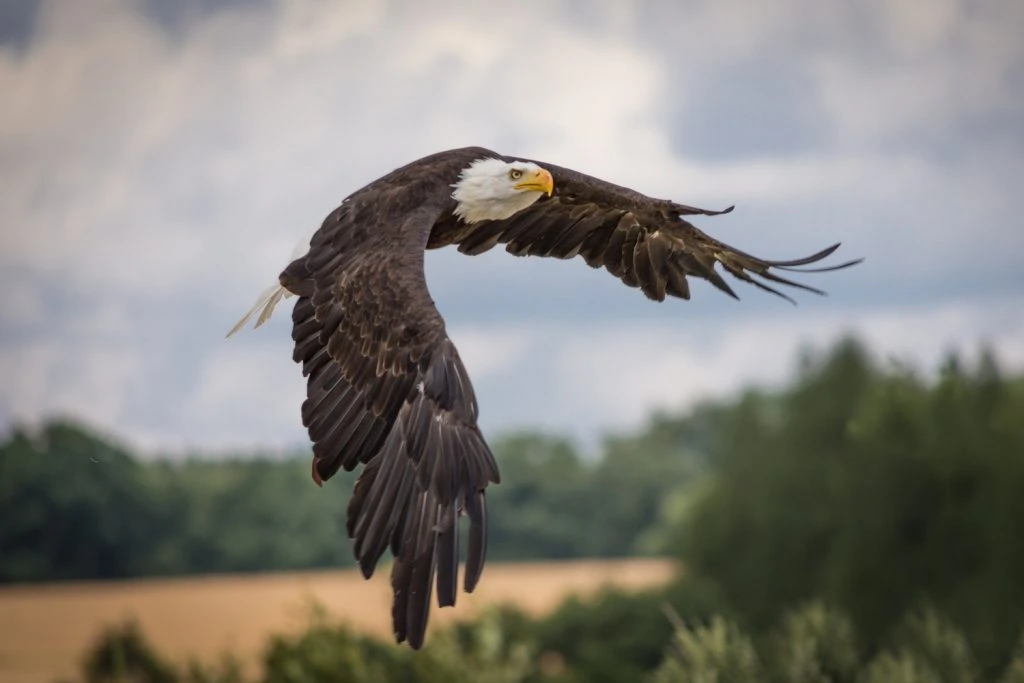
Bald Eagles are very common in the United States and are spotted here all year, but their numbers increase during winter in the south of the country.
They are recorded in 5% of summer checklists and 9% of winter checklists submitted by bird watchers for the country.
The Bald Eagle is a widely-recognized bird of prey. It has a white head, yellow eyes, and a large, hooked yellow bill. Its body is chocolate brown, and its legs are yellow, with huge talons.
Females look similar to males, except they’re about 25% larger. Juveniles have dark brown heads and bodies with variable white mottling or streaking until they reach their fifth year.
- Haliaeetus leucocephalus
- Length: 34 – 43 in (86 – 109 cm)
- Weight: 168 oz (4761 g)
- Wingspan: 72 – 96 in (183 – 244 cm)
Bald Eagles breed predominantly in Canada and then migrate to the United States for winter. However, some remain resident all year, especially in coastal regions.
You can find the Bald Eagle, during its breeding season, in wetland environments. Open and large bodies of water with plenty of fish are ideal spots.
When they’re nesting, roosting, or perching, Bald Eagles need tall, mature, and large trees for good visibility and have to have an open structure allowing the Bald Eagles to see the forest floor, and must be near water, especially when nesting.
In the winter, Bald Eagles flock to spots with a lot of perches around unfrozen water with plenty of fish. When there’s no available unfrozen water source, Bald Eagles will congregate in open habitats with medium-sized mammals like in prairies and meadows.
Bald Eagles are opportunistic feeders and will eat what is available in their environment. Their favorite food is fish, and they prefer large ones, like trout and salmon. They may hunt these fish themselves or steal them away from other birds. Sometimes, they also eat carrion (dead) fish.
They also eat medium to large-sized birds, like ducks, herons, owls, and geese. During winter, bald eagles turn to mammals for their prey when fishing for food is not as lucrative. They will initially target weak, dying, or young prey. They hunt rabbits, squirrels, raccoons, beavers, and deer fawns.
Bald Eagle Calls: The squeak of the Bald Eagle does not fit its size as they make a rather disappointing high-pitched whistle!
Nests of Bald Eagles are large and sturdy to be able to withstand their size and weight. They build a stick nest, around 6 feet in diameter and 4 feet high. The male brings the materials such as sticks, grass, moss, and downy feathers, and then the female puts it all together.
Bald Eagles’ nests are considered the largest of any bird in North America.
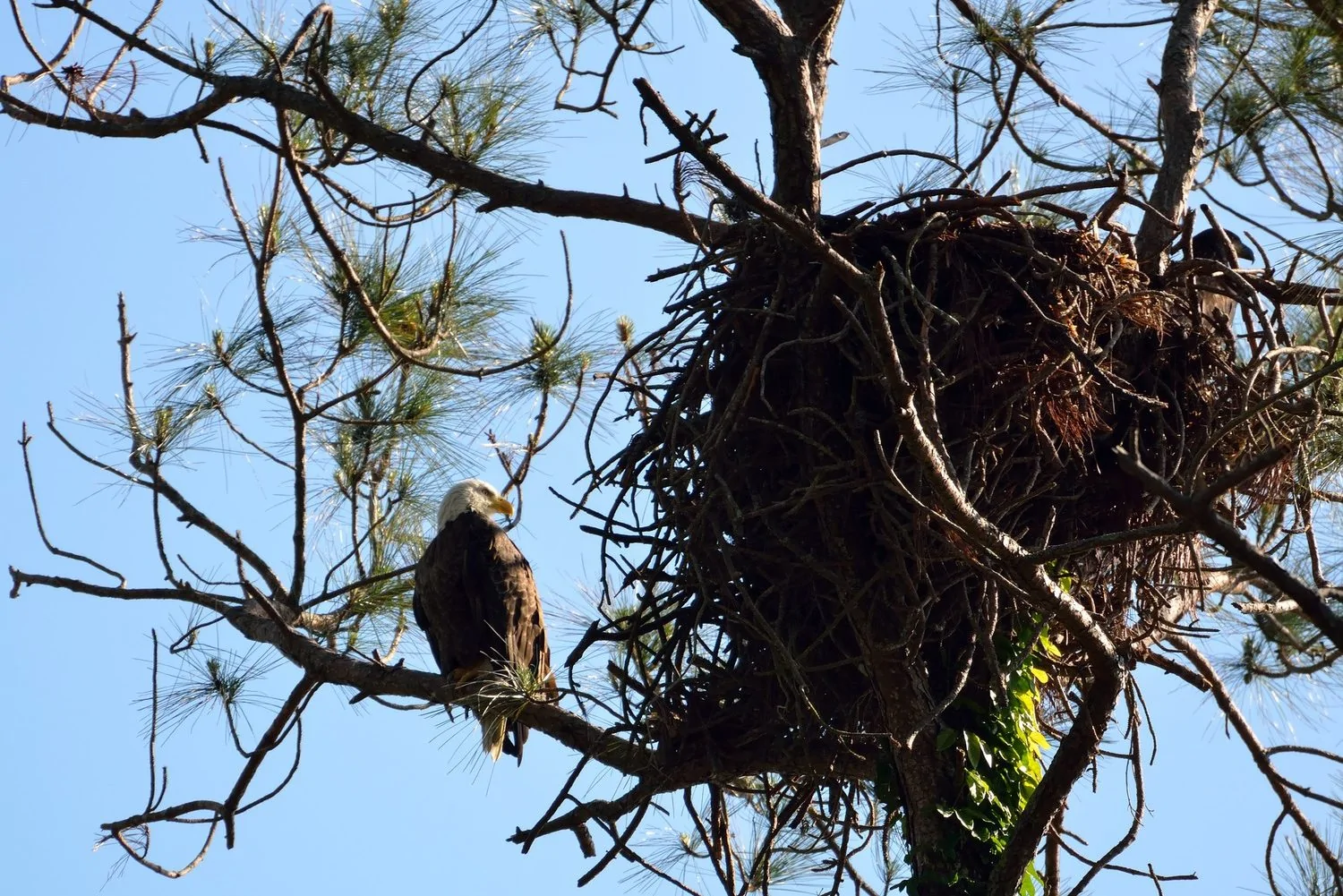
Females may lay one to three eggs per year in the wild. In captivity, they may lay up to seven eggs. The parents take turns in incubating the eggs for thirty-five days. Whoever is not sitting on the eggs gets to hunt for food to feed the other.
Fun Fact: The Bald Eagle has been the national symbol of America since 1782. It may be named “bald,” but it isn’t actually bald. The old version of “bald” actually meant “white,” referring to its white head and tail.
20. Golden Eagle
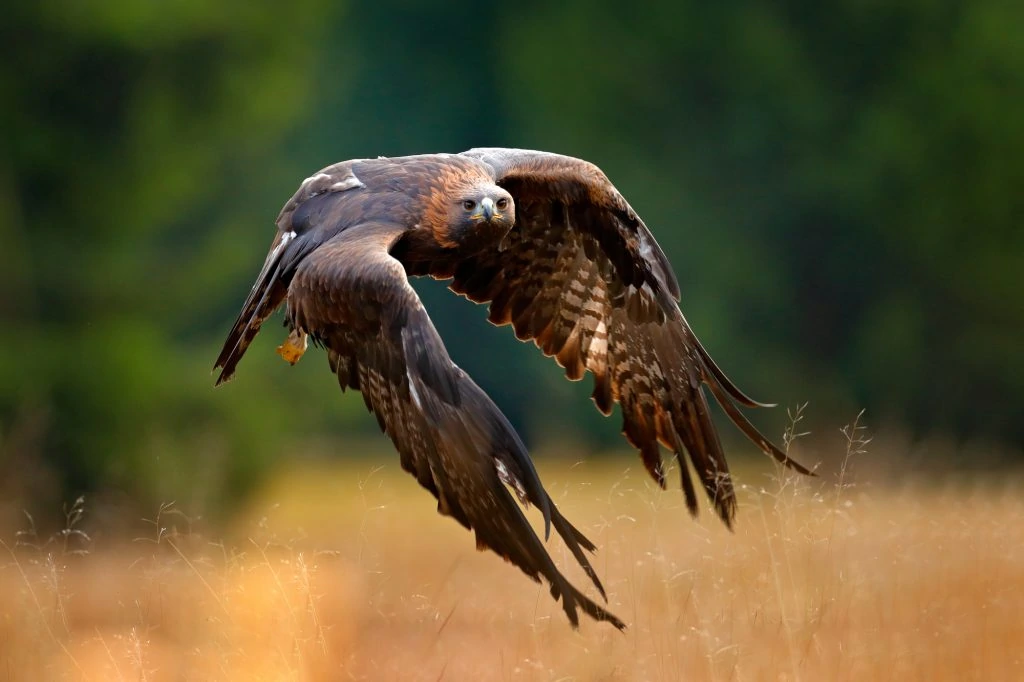
Golden Eagles are spotted all year in the west of the United States, and they are also spotted during migration and winter in the east of the country.
Golden Eagles are the most widely distributed eagles in the world. Their crown and nape (neck) are golden-brown and are a sight to behold when in the right light.
Their bodies are darker brown but with pale flight feathers. Their eyes vary from light yellow to dark brown. They have a yellow cere, which is the skin on the beak which attaches to the forehead, and their bill is dark at the tip.
While adults look similar, females are larger than males. Juveniles are also similar, but they tend to have a darker color, sometimes appearing black on the back. They also have white patches on the underside of their wings and some white coloring on the tail.
The Golden Eagle has six subspecies: European Golden Eagle, Iberian Golden Eagle, Asian Golden Eagle, Japanese Golden Eagle, North American Golden Eagle, and the Kamchatkan Golden Eagle. Their differences lie in their size and the slight variations in the color of their feathers.
- Aquila chrysaetos
- Length: 27 – 38 in (69 – 97 cm)
- Weight: 160 oz (4534 g)
- Wingspan: 72 – 96 in (183 – 244 cm)
Golden Eagles that breed in Canada and Alaska migrate south for winter to the United States and northern Mexico. However, Golden Eagles in western US states remain all year.
You can find Golden Eagles in mountainous habitats far above the treelines. They also inhabit canyons, riverside cliffs, and bluffs when nesting. They generally prefer to avoid human presence.
If you want to get a birds-eye view of a Golden Eagles’ day then check out the video below, but only if you’re not scared of heights!
Since Golden Eagles are birds of prey, naturally, they’d prey on small to medium-sized animals like rabbits, prairie dogs, and hares. On occasion, they may also hunt and take down larger prey like cranes, swans, and domestic livestock. They usually hunt in pairs, with one chasing down the prey until it gets tired, and then the other swoops in for the kill.
Golden Eagle Call: The main calls that are made by Golden Eagles are during the breeding season when chicks are begging, and parents respond. Otherwise, they are pretty quiet. They make high-pitched whistled calls.
Nests of Golden Eagles are usually located at high elevations, like cliffs. However, they also build them in trees or artificial structures like observation towers, nesting platforms, and even windmills. They’re built high so the parents can have a wide view over their nesting and hunting grounds.
Golden Eagle nests take anywhere from one to three months to build out of sticks and plant material.
They even line their nests with aromatic leaves to keep the insects and other pests at bay. These nests are re-used for many years and grow in size as the adults continue to add material to them.
The female lays one to three eggs, and the parents take turns in incubating the eggs from forty-one to forty-five days. The chick hatches from its egg in 37 hours.
Fun Fact: The Golden Eagle, the Rough-legged Hawk, and the Ferruginous Hawk are the only American birds of prey that have feathers on their legs up to their toes.
21. Steller’s Sea-Eagle
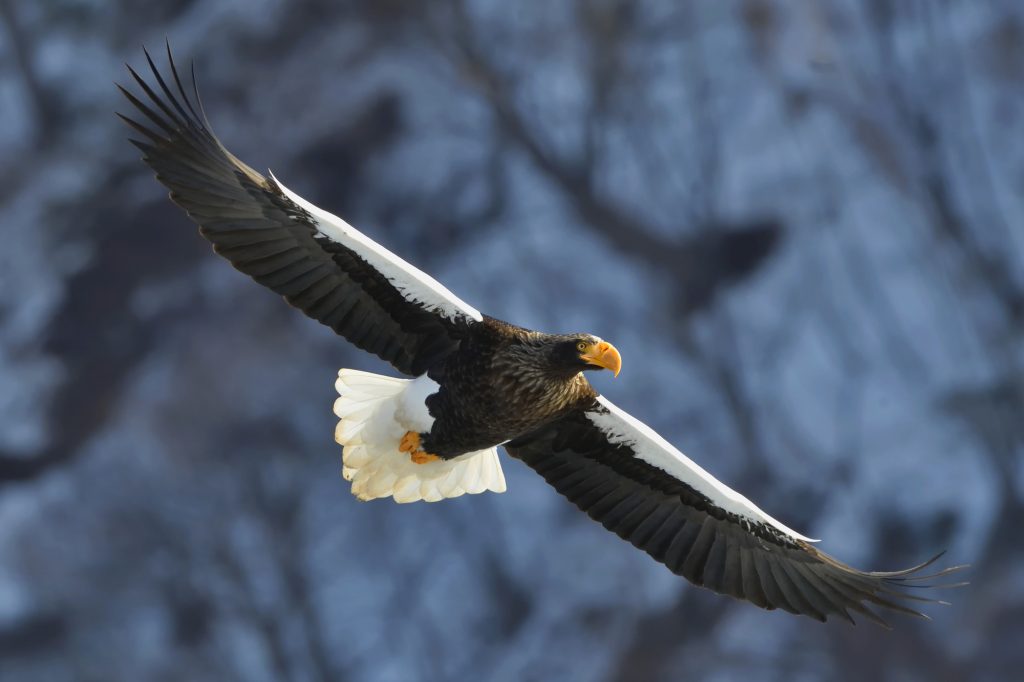
Steller’s Sea-Eagles are considered vulnerable and rare species in the United States. They have only been spotted around Alaska, Maine, Massachusetts, and Texas.
Steller’s sea-eagle is the largest bird in the genus Haliaeetus and possibly the heaviest eagle in the world. Its weight ranges from 5 to 9 kilos, with females being heavier than males.
It has a white forehead, yellow eyes with a dark pupil, and a really large, yellow hooked bill. Its body is dark-brown or black with white shoulders, belly, wings, legs, and tail. Its feet are yellow with sharp talons.
Juveniles are similar to adults, but they have no white shoulders, and the end of their tails are dark. It takes around four years for them to attain the coloring of the adults.
Steller’s Sea-Eagle has a very rare dark morph that has black feathers everywhere except for its white tail.
- Haliaeetus pelagicus
- Length: 42 – 45 in (107 – 114 cm)
- Weight: 273.6 oz (7754 g)
- Wingspan: 86 – 98 in (218 – 249 cm)
Steller’s Sea-Eagles are usually found in the rocky seacoasts and rivers of northeastern Siberia in Russia. They migrate to Korea, Japan, and China during winter, staying in coastal areas and on lakes near the coast. However, they occasionally wander into North America.
Steller’s Sea-Eagles love fish, particularly river fish like salmon and trout, which they hunt in shallow water. They also consume salmon that die after spawning because these are more abundant and available in areas with unfrozen water in autumn.
In other areas, they may also hunt and feed on water birds like ducks, geese, swans, and cranes. Mammals are also part of their diet. They favor the American mink, Arctic fox, red fox, and small domestic dogs.
Steller’s Sea Eagle Calls:
Nests of Steller’s Sea Eagle, or as they’re called “aeries,” are built on tops of trees or on rocky outcrops, as high as 100 feet above the ground. While they’re high, they’re still close to the water so that they have easy access to food from their nests.
Steller’s Sea-Eagles build massive nests out of sticks and branches. Since they tend to re-use these nests, they keep adding more sticks and branches to them to keep them sturdy and strong.
The female lays one to three eggs in their chosen nest. Incubation lasts as long as forty-five days. When the chicks hatch, they need all the protection they can get, as it takes about a couple of months or so for them to fly.
Steller’s Sea-Eagles are considered “Vulnerable” due to threats of habitat destruction, industrial pollution, and over-fishing.
Fun Fact: Steller’s Sea Eagles sometimes build a second alternate nest in the event that the first one becomes so heavy that the branches it’s sitting on can’t carry the weight and break.
22. White-tailed Eagle
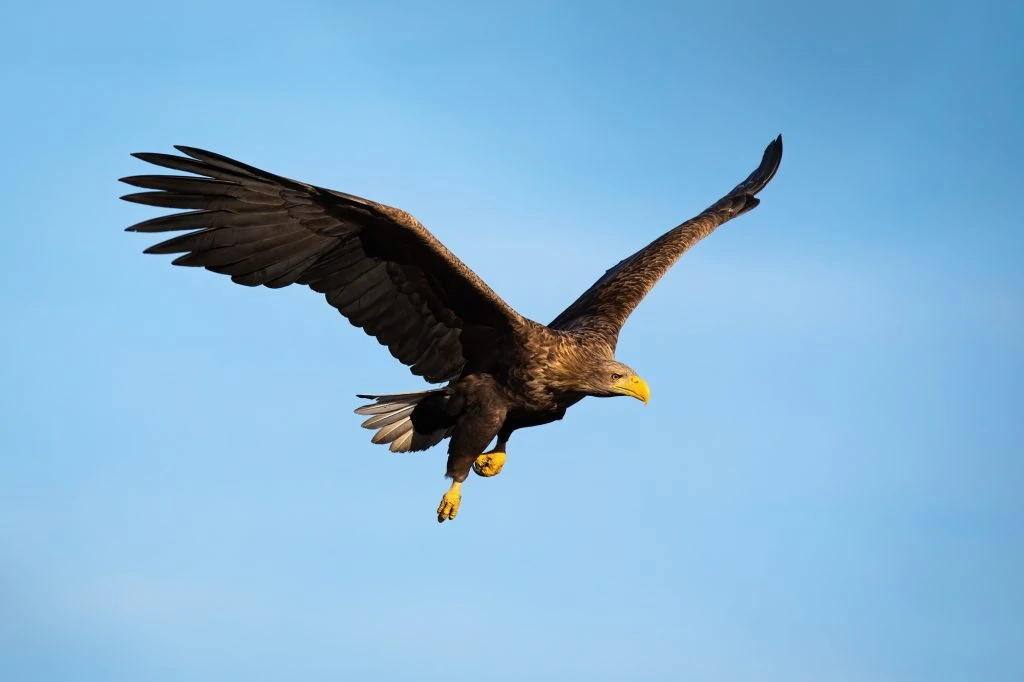
White-tailed Eagles are not often spotted in the United States, and there have only been recorded sightings around Alaska and New York.
The White-tailed Eagle is a large eagle having possibly the largest wingspan of any living eagle.
White-tailed Eagles generally have dark brown bodies. Their heads, necks, and upper breasts have a paler or lighter shade of brown and are streaked with white. They have yellow eyes, a short hooked yellow bill, white wedge-shaped tails, and yellow feet. Older birds may show whitish heads.
Juveniles have darker brown coloring with uneven, whitish mottling or streaks across their bodies. Their bills and tails are also dark. It takes four to five years before they attain full adult feathers.
- Haliaeetus albicilla
- Length: 31 – 40 in (79 – 102 cm)
- Weight: 194 oz (5498 g)
- Wingspan: 72 – 96 in (183 – 244 cm)
White-tailed Eagles are more commonly seen across Europe and Asia, but it has been known to visit North America, particularly on the western shores of Alaska.
You can find White-tailed Eagles around rocky coastlines near large bodies of water. In winter, they move to low coastal spots and coastal marshes. During nesting, they need forested areas with large, tall, mature trees or cliffs near lakes, rivers, and seas.
They may also visit human environments with access to food like commercial fish farms but only if they won’t be disturbed by actual humans.
White-tailed Eagles are keen predators that hunt fish, birds, and mammals whenever and wherever they can. Their primary food is fish which they capture when flying from a perch or when flying low.
They may even walk on shallow water and fish from the shore. They are also known to steal food from other birds foraging near their territory.
In hunting birds, White Eagles use stealth and low flight to catch them unaware. They usually target diving ducks, exhausting them until they’re too weak to fight. They may also prey upon nestlings and juveniles. During the lean winter months, they are known to eat carrion or decaying animals.
White-tailed Eagles Calls:
Nests of White-tailed Eagles are often found in large trees, built in-between branches, supported by the main fork, a canopy, or a large side branch. They are usually high up in trees, near the water, or at the edge of an open space. Sometimes, even if trees were available, they would still build on sea cliffs or other rocky spots.
The male White-Tailed Eagle will bring the materials, mostly sticks and branches, and lichen, moss, seaweed, and ferns for lining the inside. The female then constructs the nest. They are known to build alternate nests, with as many as 11 but usually around 2 nests per pair.
The female lays one to three eggs which she incubates for about forty days. The male, for his part, hunts for food and feeds the female, even when the eggs have hatched for up to three weeks.
After that, the female will also join in hunting for food. When the young start to fledge, they may rely on their parents to feed them, but they won’t feed them much in order to encourage them to hunt on their own.
Fun Fact: The White-tailed Eagle had once gone extinct in Europe due to killing by humans. They shot and poisoned them and destroyed any nests that they found. Their numbers have recovered well today due to governmental restrictions and conservationists’ protection.
Hawks
23. Red-tailed Hawk
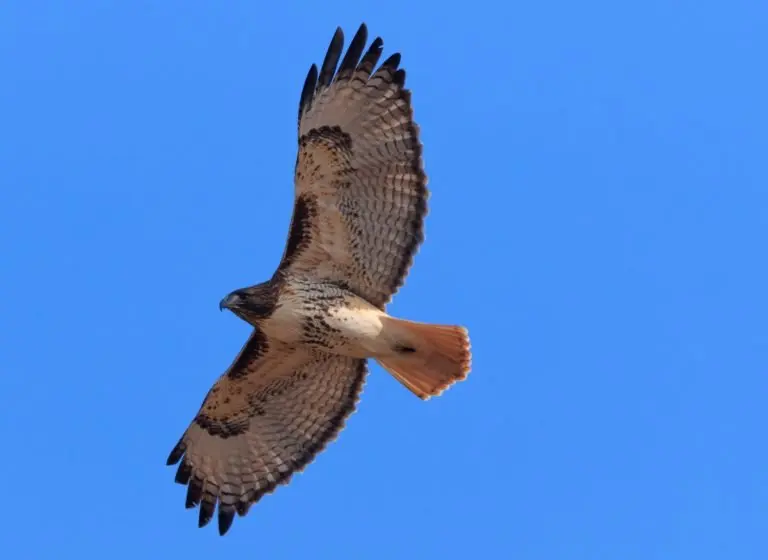
As their name suggests, Red-tailed Hawks have a distinctive short, wide red tail. They are large, with broad, rounded wings. Most Red-tailed Hawks are brown on the back and pale underneath.
They are also the easiest to spot, often on long car journeys, as they circle slowly over open fields looking for prey such as small mammals, birds, and reptiles. You can also see them perched on telephone poles.
Male
- Length: 17.7-22.1 in (45-56 cm)
- Weight: 24.3-45.9 oz (690-1300 g)
- Wingspan: 44.9-52.4 in (114-133 cm)
Female
- Length: 19.7-25.6 in (50-65 cm)
- Weight: 31.8-51.5 oz (900-1460 g)
- Wingspan: 44.9-52.4 in (114-133 cm)
Red-tailed Hawk Call:
The high-pitched descending raspy-screech sound of the Red-tailed Hawk is often used in movies for all birds of prey.
Red-tailed Hawks remain resident in the US and Mexico, but those birds in Alaska, Canada, and the northern Great Plains fly south for winter.
Nests are high in tall trees, cliff ledges, and sometimes on tall buildings or towers. They lay 2-3 whitish, brown-spotted eggs.
24. Red-shouldered Hawk
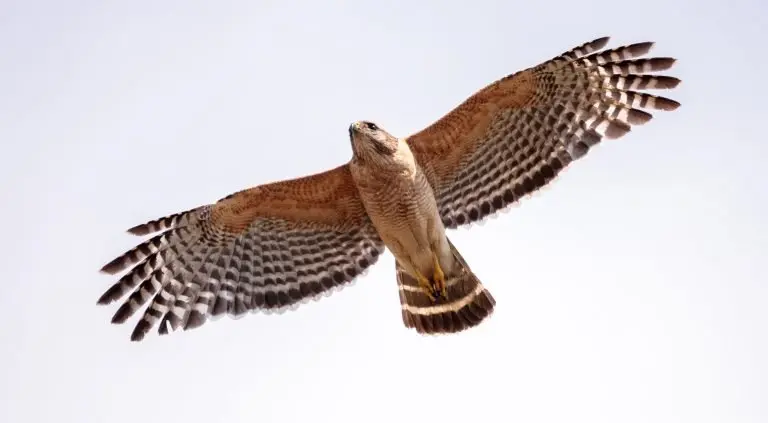
Red-shouldered Hawks are distinctly marked, with dark and white checkered wings and reddish barring on the breast. They are medium-sized, between the size of a crow and a swan with a strongly banded tail. They make a loud cack-cack-cack-cack call.
- Length: 16.9-24.0 in (43-61 cm)
- Weight: 17.1-27.3 oz (486-774 g)
- Wingspan: 37.0-43.7 in (94-111 cm)
Red-shouldered Hawk Call:
Red-shouldered Hawks are resident in eastern states, but those in the Northeast may migrate further south for winter. These hawks are also resident on the West Coast.
They tend to be seen near wet forests hunting along a stream or pond. Their prey is mammals and frogs or snakes.
Nests are often reused each year in a broad-leaved tree near water. They lay 2-5 white or bluish eggs.
25. Cooper’s Hawk
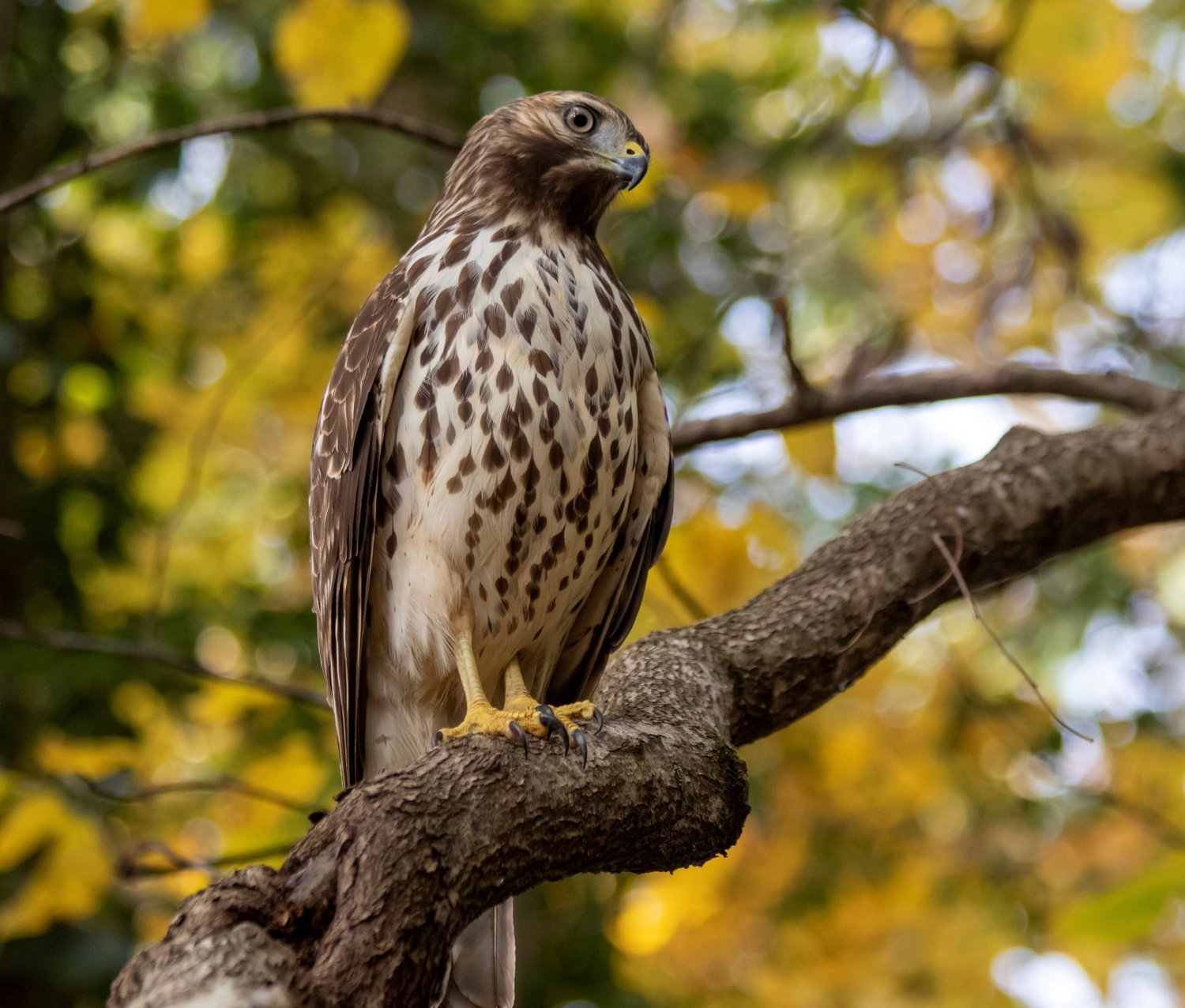
The Cooper’s Hawk looks very similar to the Sharp-shinned Hawk but is bigger at about the size of a crow. They can be hard to identify between them as they have the same blue-gray back and red-orange breast and also with dark bands on the tail.
They have a larger head that projects well beyond the wings, unlike the Sharp-shinned Hawk.
Male
- Length: 14.6-15.3 in (37-39 cm)
- Weight: 7.8-14.5 oz (220-410 g)
- Wingspan: 24.4-35.4 in (62-90 cm)
Female
- Length: 16.5-17.7 in (42-45 cm)
- Weight: 11.6-24.0 oz (330-680 g)
- Wingspan: 29.5-35.4 in (75-90 cm)
Cooper’s Hawks remain resident over most of the US, but some in the north of the range, including Canada, migrate south for the winter down as far as Mexico and Honduras.
Look out for them at the edge of forests, but they can also be seen at feeders looking for an easy meal.
They feed on medium-sized birds and small mammals and nest in tall trees, often on top of an old nest of a large bird or clump of mistletoe. They lay 2-6 pale blue to bluish-white eggs.
26. Northern Harrier
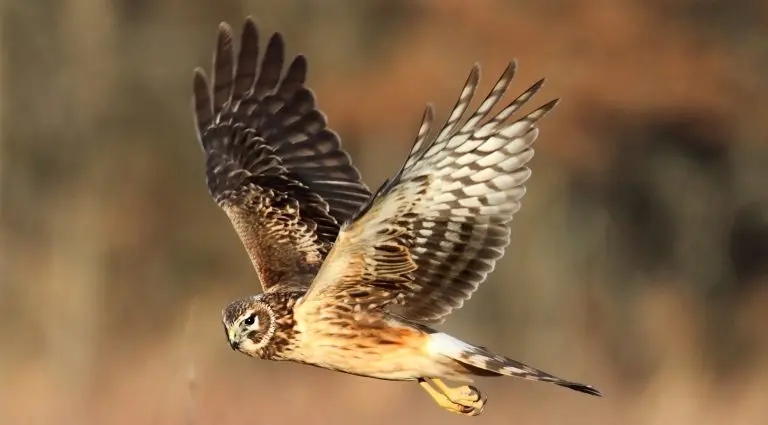
Northern Harriers are slender with long broad wings and are between the size of a crow and a goose. They often fly with the tips of their wings higher than their bodies in a v-shape.
Females are brown, and males are gray above and white below, and they have a white rump patch.
- Length: 18.1-19.7 in (46-50 cm)
- Weight: 10.6-26.5 oz (300-750 g)
- Wingspan: 40.2-46.5 in (102-118 cm)
Northern Harriers that breed in Alaska, Canada, the northern Great Plains, and the Northeast before migrating south for the winter to southern states, Mexico and Central America. Those in the middle of the range remain all year.
This slim, longed-tailed hawk can be seen gliding low over grassland or marshes.
Northern Harriers mostly eat small mammals and small birds. They nest on the ground in dense vegetation such as reeds, willows, or brushtails. They lay 4-5 dull white eggs.
27. Sharp-shinned Hawk
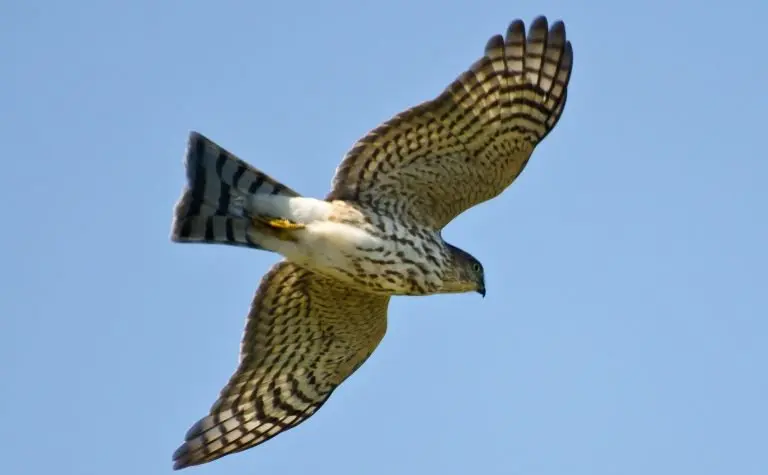
Adult Sharp-shinned Hawks are small hawks with blue-gray across the back and red-orange breasts. They have dark bands across their tails.
The females are a third larger than the male. They have long square-ended tails, short rounded wings, and small heads.
- Length: 9.4-13.4 in (24-34 cm)
- Weight: 3.1-7.7 oz (87-218 g)
- Wingspan: 16.9-22.1 in (43-56 cm)
Sharp-shined Hawks that breed in Canada and some northern states migrate south. Those birds in the Appalachians and Western Mountains may remain all year.
Sharp-shined Hawks are very secretive but can be seen as they fly across open areas at the edges of forests. They are very agile and can speed through dense woods to catch their prey in flight, usually songbirds.
They can sometimes be seen near feeders catching small birds, but if you have problems with them in your backyard, remove the feeder for a few weeks.
Sharp-shinned Hawks pluck their prey on a stump or low branch before eating it. They usually eat songbirds about the size of a robin.
Nests of the Sharp-shinned Hawk are often in conifer trees in dense cover, usually towards the top of tall trees. The nest is quite large, being 1-2 feet in diameter and 4-6 inches deep. They lay 3-8 white or pale-blue mottled eggs.
28. Broad-winged Hawk
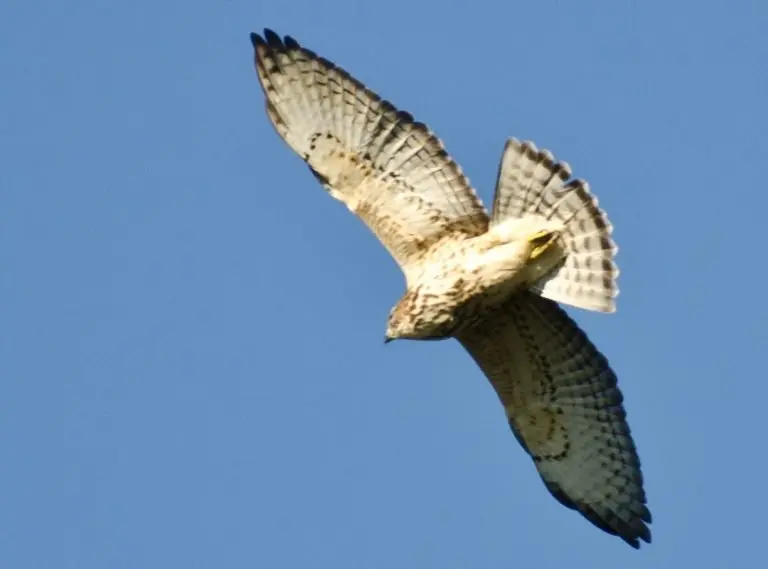
The Broad-winged Hawk is a compact, stocky bird between the size of a crow and goose. They have reddish-brown heads, barred breasts, and narrowly banded short square tails.
- Length: 13.4-17.3 in (34-44 cm)
- Weight: 9.3-19.8 oz (265-560 g)
- Wingspan: 31.9-39.4 in (81-100 cm)
Broad-winged Hawks breed in the Eastern US and Canada before migrating in large numbers to Central, and South America in a swirling flock called a kettle. As a result, the migration in the fall is often the best chance to see them.
Hunting from a perch, often on the edge of woods or water, these hawks eat small mammals, frogs, snakes, and even young turtles.
The Broad-winged Hawk often reuses the nest of another animal, such as a crow or squirrel, and lays 2-3 whitish eggs.
29. Swainson’s Hawk
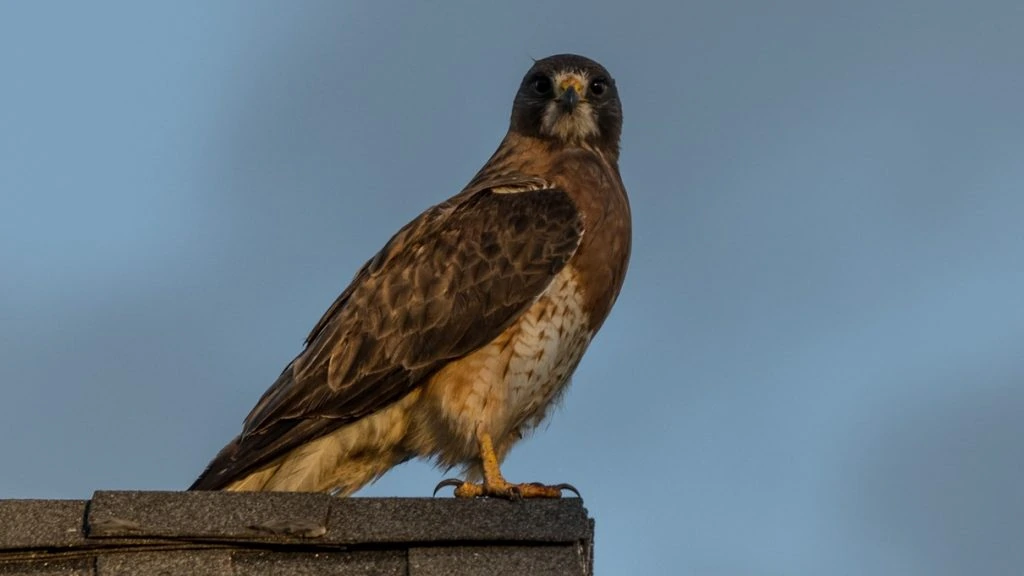
Swainson’s Hawks are long-winged hawks with short tails and pointed wingtips. They are usually brown or gray mottled on the back and with lighter bellies and brown or red chests.
When in flight, you can see the contrast between the black flight feathers on the lower edges of the wings and tips and the white upper part of the wing (called the linings).
- Length: 18.9-22.1 in (48-56 cm)
- Weight: 24.4-48.2 oz (693-1367 g)
Swainson’s Hawks can be found in open country in the West and over the Great Plains in the summer before heading to South America for winter in large flocks, reaching into the thousands. They breed as far as British Columbia and Alaska and in the West from the Pacific to the Midwest.
May and September are the best times to see these hawks as they migrate long distances and are famous for providing spectacular displays in the tens of thousands of birds during the day.
Swainson’s Hawks hunt for rodents by perching on any high points, such as utility poles or fences, making them easier to spot in the relatively flat lands where they hunt. If no high points are available, they may be found on the ground in grassland and fields, hunting for insects.
They may also eat Burrowing Owls in areas where they are abundant, but they are not fussy and eat anything from snakes and lizards to bats, mice, and rabbits or crickets and dragonflies.
There are not many nest sites in the open country for Swainson’s Hawks, so they use any trees near fields or low mesquite bushes and power poles. The nests are a large collection of twigs and sticks and can be up to 2 feet wide and up to a foot high. The inside of the nest is lined with softer material, such as dung, bark, wool, and grass.
30. Rough-legged Hawk
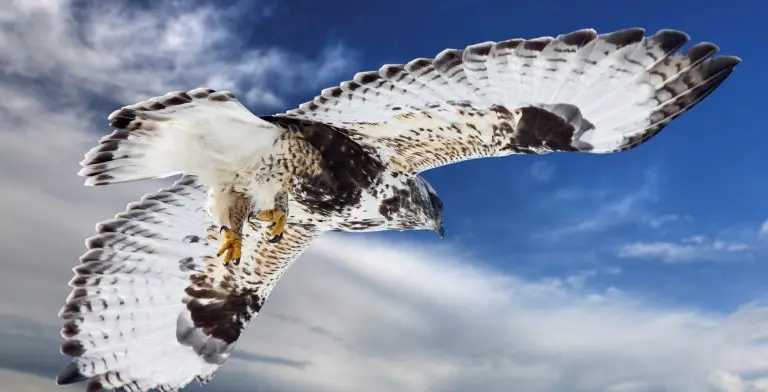
The feathered legs give the Rough-legged Hawks their name and help to keep them warm in the arctic. They are fairly large hawks, between the size of a crow and a goose.
This predominantly dark-drown species occurs in light and dark forms, with dark patches at the bend of the wing, end of their tails, and across the belly. They have broad wings that are relatively long and narrow compared to other hawks.
- Length: 18.5-20.5 in (47-52 cm)
- Weight: 25.2-49.4 oz (715-1400 g)
- Wingspan: 52.0-54.3 in (132-138 cm)
Rough-legged Hawks breed in Alaska and northern Canada before migrating to the US for winter. They are usually sighted hovering over marshes and open fields or perched on a pole.
Lemmings and voles provide most of the prey for Rough-legged Hawks. Voles, mice, ground squirrels, and other small mammals provide winter prey in states such as West Virginia. Nests are usually on a high cliff ledge, and they lay 3-5 pale bluish-white eggs.
31. Ferruginous Hawk
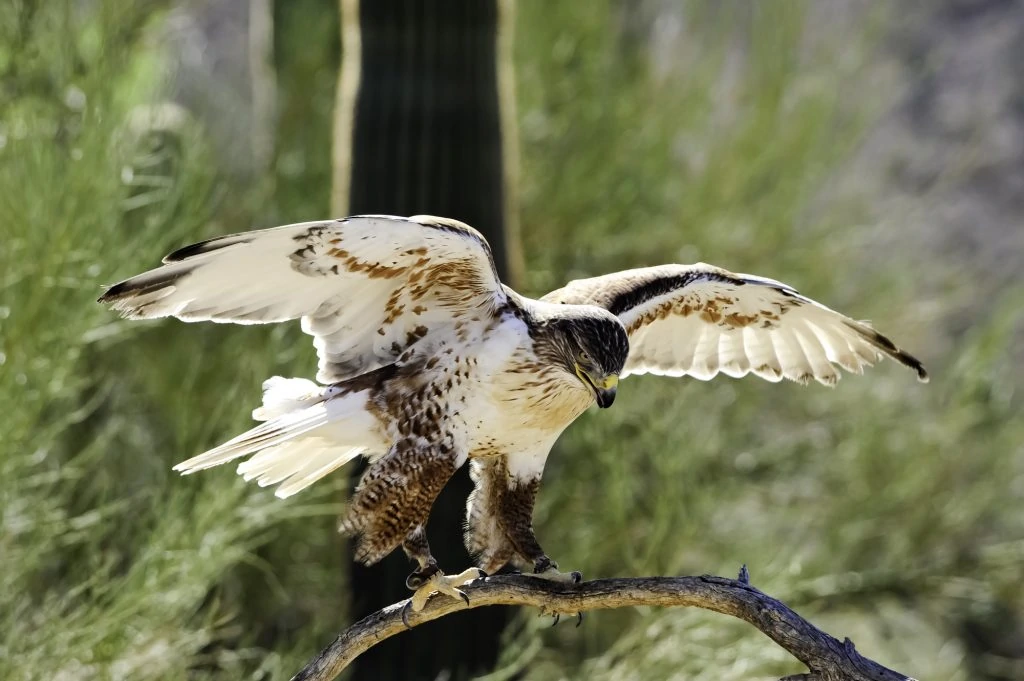
Ferruginous Hawks are the largest hawks in North America. They have large heads and long wings. To make identification harder, they come in a light and a dark morph, which can vary quite considerably in the color pattern.
The more common light morph Ferruginous Hawks are white underneath on the wings, belly, and head. Their backs and the upper side of the wings are a rusty brown, and they have darker legs. Immature light morphs have more brown spotting on the belly and legs.
Dark morphs are much rarer, and they have brown bellies and under the wings, except for white flight feathers on the wingtips and tail.
- Length: 22.1-27.2 in (56-69 cm)
- Weight: 34.5-73.2 oz (977-2074 g)
- Wingspan: 52.4-55.9 in (133-142 cm)
Ferruginous Hawks are another species of hawk that lives in the open country of the West. They breed as far north as Southern Canada and down to Nevada and Utah. In winter, they move short distances to Southern States and Mexico. Some birds may remain residents all year in the middle of their range.
You can spot Ferruginous Hawks in grassland and shrublands in the low country. They do not cross the Rockies, even when migrating. Small mammals make up the majority of their diet, and depending on what is available, they eat jackrabbits and cottontail rabbits in the West and ground squirrels and prairie dogs in the East.
They are daytime hunters and hunt both on the wing and by perching or even hunting on the ground.
Their nests are very large and can measure 3 feet high and 3 feet across, and they can lay up to 8 eggs.
32. Harris Hawk
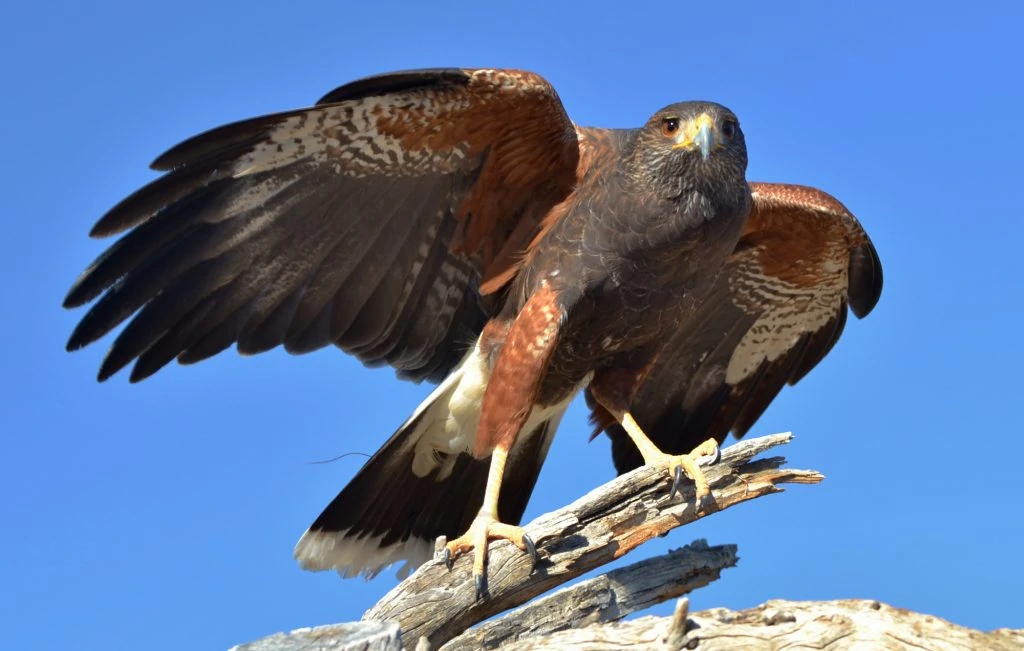
Harris Hawks are unusual in both their coloring and habits. Their dark brown and reddish tones with flashes of white stand out against the arid environments they inhabit.
They are medium-sized hawks with broad rounded wings and long tails. Their tails are often fanned out and have distinctive dark and light bands. Females can be twice as heavy as males but usually around 30-40% heavier.
- Length: 18.1-23.2 in (46-59 cm)
- Weight: 18.2-31.0 oz (515-880 g)
- Wingspan: 40.5-46.9 in (103-119 cm)
They are unusual birds of prey in that they often live in social groups of about six or seven birds. They cooperate in hunting and helping breeding pairs in the group.
Due to their intelligence, they are prized in falconry as they are easy to train.
Harris Hawks can be found in arid Southern States, Mexico, and down through South America.
Birds, mammals, and insects or lizards make up the main diet, but they can also catch jackrabbits or larger birds such as small wild turkeys when they hunt in groups.
33. Gray Hawk
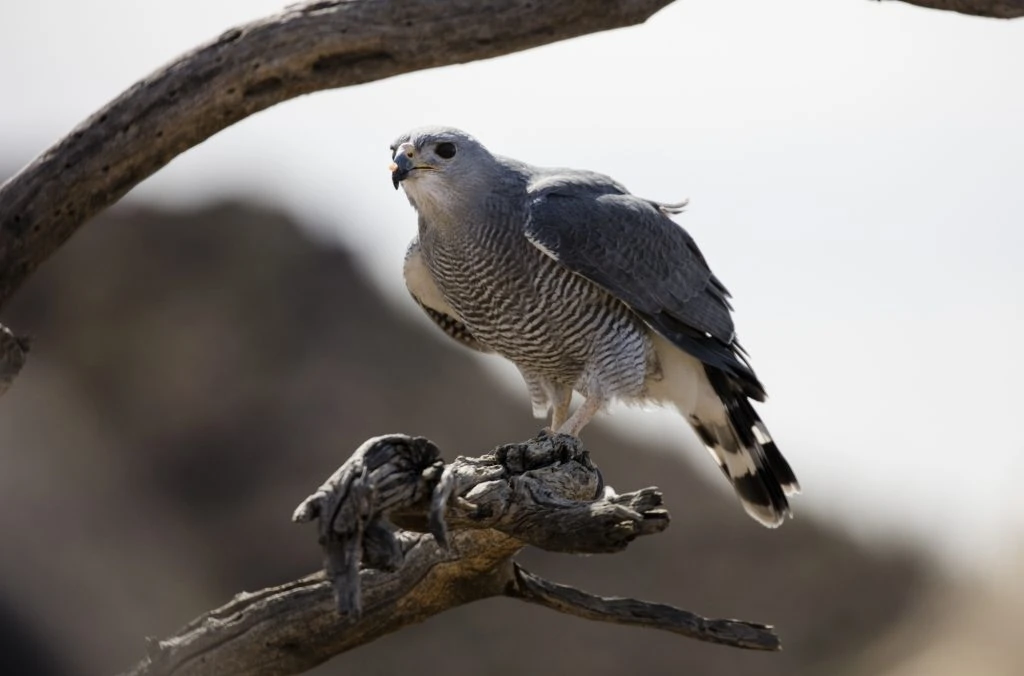
Gray Hawks are light gray in color with solid gray on the upper parts, barred on the chest and belly. Their tails are long and have three white bands against black. They have short, broad wings and are smaller hawks in this family.
- Length: 18–24 in (46–61 cm)
- Weight: 13.8-16.6 oz (391-470 g)
Gray Hawks migrate and spend the summer breeding in Central America, Mexico, and Southern Texas, and Arizona.
Try looking for Gray hawks in cottonwood and willow woods, with streams or rivers nearby. They can be spotted soaring over open areas or perched on branches waiting patiently for lizards.
34. White-tailed Hawk
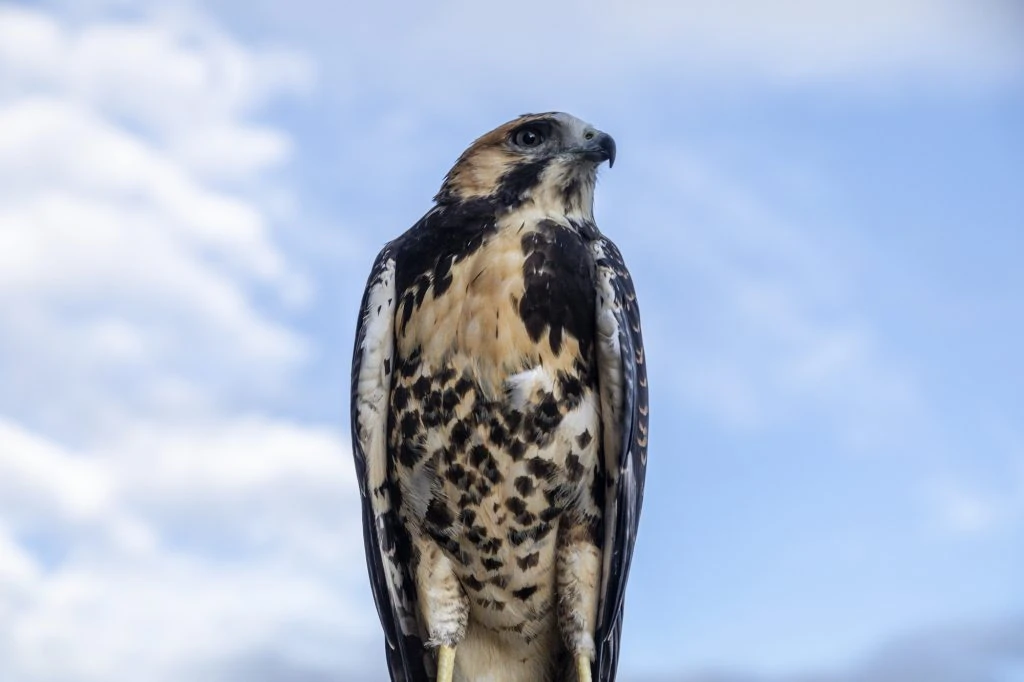
White-tailed Hawks are distinctive hawks with dark coloring on the back, with red shoulders and a flash of white underneath. Their tails also stand out, being white on the top and underneath and with a dark band running around the edge.
Immatures are speckled across the chest and belly, and some birds can be an all-dark morph. Females are larger than males.
- Male
- Length: 18.1-20.5 in (46-52 cm)
- Weight: 31.0-43.6 oz (880-1235 g)
- Wingspan: 50.4-51.6 in (128-131 cm)
- Female
- Length: 18.9-22.8 in (48-58 cm)
White-tailed Hawks do not migrate and are more common in South America, with some birds reaching up as far as Texas.
Grasslands and savannahs are the usual hunting grounds for White-tailed Hawks. Rodents, rabbits, lizards, and other birds make up their diet.
They are especially easy to spot after fires when they take advantage of the fleeing animals for a quick meal.
35. Northern Goshawk
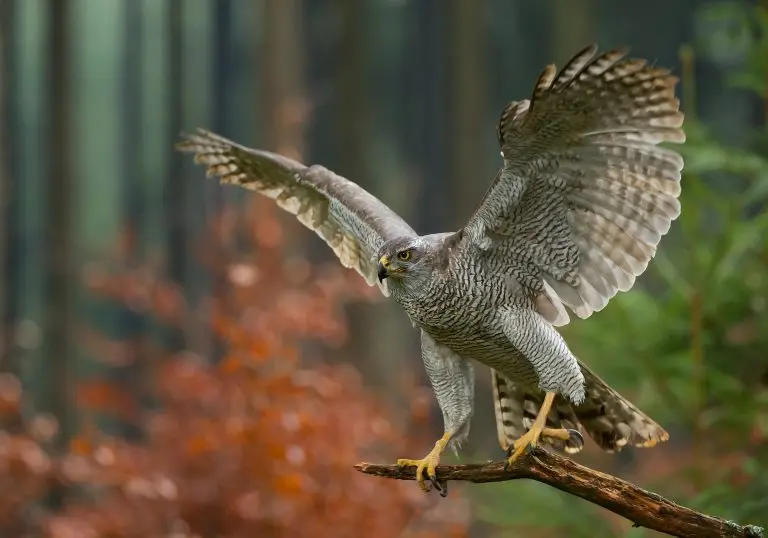
Northern Goshawk are the bigger and fiercer relative of the Sharp-shinned and Cooper’s Hawks. They are mostly gray with short, broad wings and a long tail and have a white stripe over their yellow eyes.
- Length: 20.9-25.2 in (53-64 cm)
- Weight: 22.3-48.1 oz (631-1364 g)
- Wingspan: 40.5-46.1 in (103-117 cm)
Northern Goshawks are resident in Alaska, Canada, and the mountainous west. Some younger birds may migrate to Central States during the winter.
They live in large forests, so they are hard to find, especially as they are very secretive and can be aggressive if you get too close to a nest.
Northern Goshawks live in large tracks of mostly coniferous or mixed forests. They watch for prey on high perches and mostly eat medium-sized birds and small mammals.
Northern Goshawks prepare up to eight nests and lay between 2-4 bluish-white eggs.
36. Zone-tailed Hawk
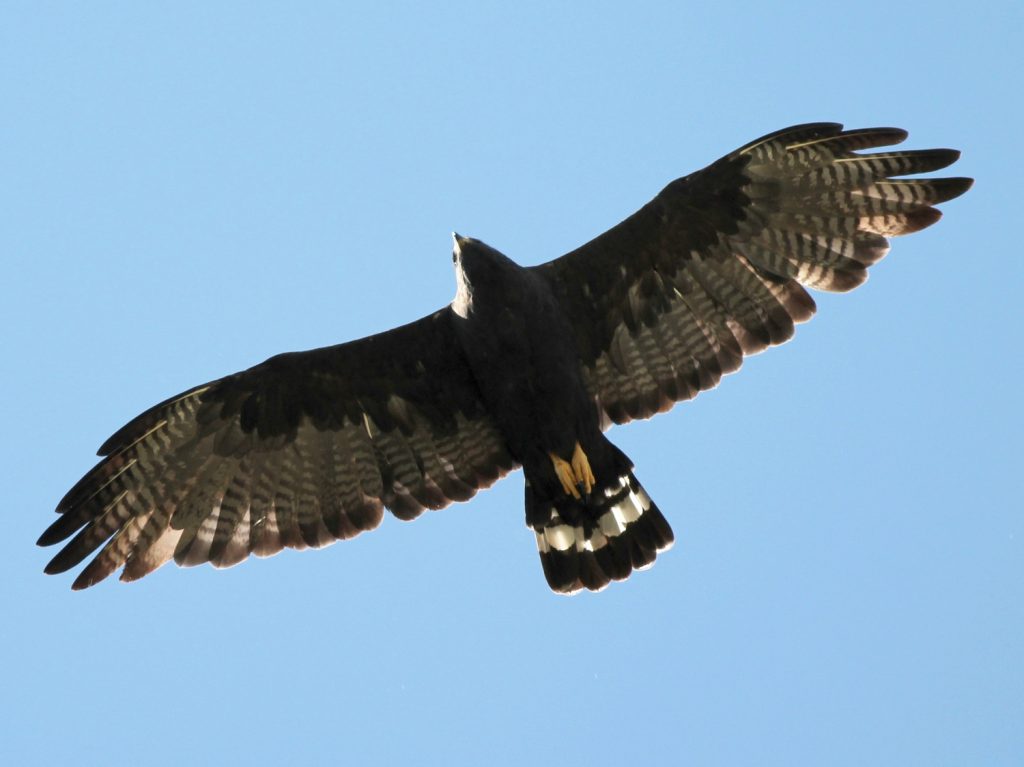
Zone-tailed Hawks are dark, almost black hawks with barring on the flight feathers’ underside and white bands across the tail.
- Male
- Length: 17.7-22.1 in (45-56 cm)
- Weight: 21.4-23.5 oz (607-667 g)
- Wingspan: 46.9-55.1 in (119-140 cm)
- Female
- Weight: 29.8-33.0 oz (845-937 g)
- Wingspan: 46.9-55.1 in (119-140 cm)
Zone-tailed Hawks are another Hawk that can only be spotted in a few states along the border during the breeding season. In winter, they migrate further south into Mexico. In South America, Zone-tailed Hawks remain all year.
They hunt along canyons and cliffs, often in high elevations, and can be spotted soaring over desert and scrub. They will also hunt down to coastal plains.
Mammals, birds, reptiles, and amphibians make up the diet of Zone-tailed Hawks. They hunt by flying low and using the landscape as a screen to hide them until it’s too late.
37. Short-tailed Hawk
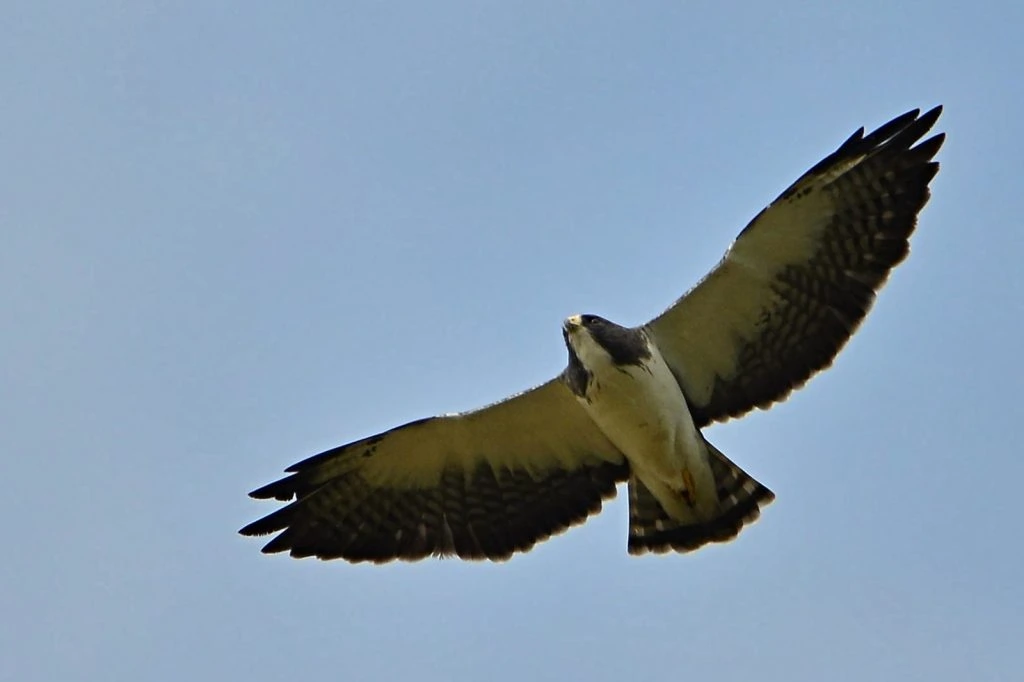
Short-tailed Hawks are small hawks that can either be light or dark in color. Dark morphs are very dark brown, but with lighter flight feathers underneath, Light morphs are white below and brown on the back. As the name would suggest, they have short tails compared to other hawks.
- Length: 15 – 17 in (38 – 43)
- Weight: 0.8 – 1.1 lb (362 – 500 g )
They live in Mexico, Central and South America, and Florida. Short-tailed Hawks can be hard to spot as they hunt small birds from high up in the sky.
38. Common Black Hawk
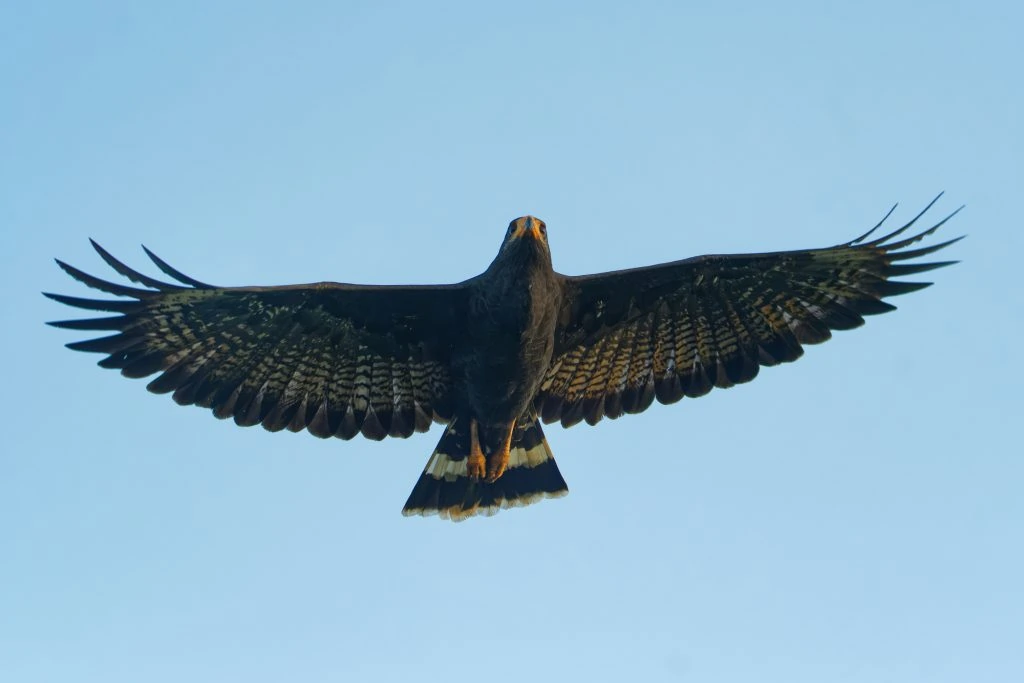
Common Black Hawks have broad wings, short tails, long legs, and large bodies. They are black, except for a white band across the tail.
- Length: 17 – 21 in (43 – 53)
- Weight: 33oz (930g)
They can be spotted along the southern border from California to Texas, mostly in summer. However, they usually remain resident all year in their range in Mexico and Central America.
Although called ‘common’, they are not very common in the United States, and only about 250 pairs are thought to exist here.
They hunt along streams near woods, looking for crabs, fish, frogs, and lizards, but they will also hunt birds and small mammals.
39. Hawaiian Hawk
40. Great Black Hawk
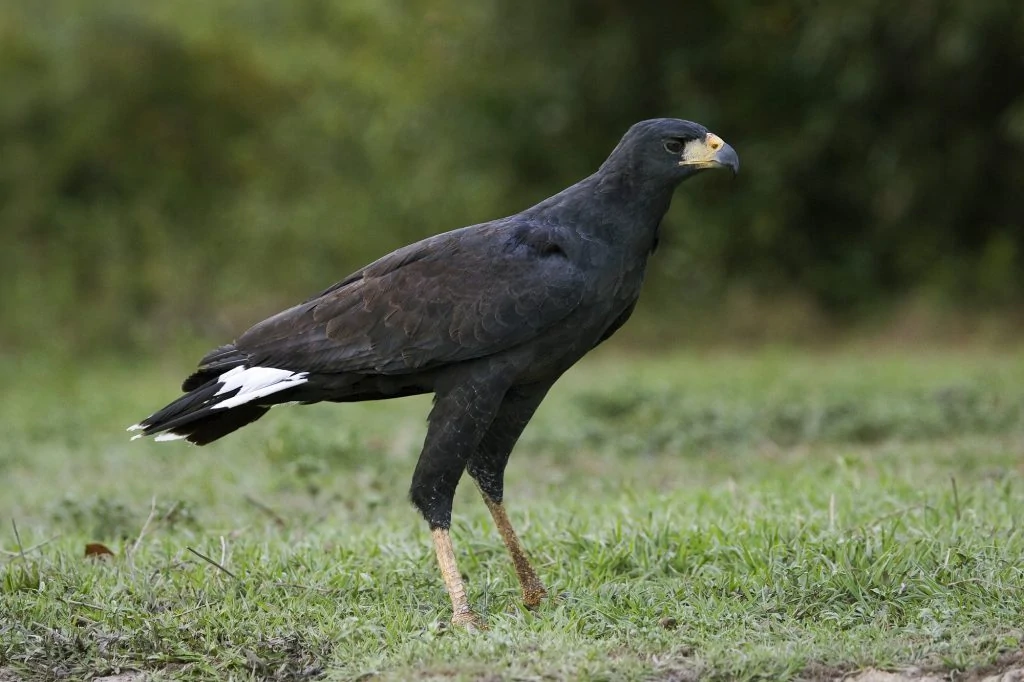
Great Black Hawks are considered rare or accidental species here, but they have been spotted in Texas and Florida in recent years.
Great Black Hawks are similar in appearance to Common Black Hawks but are larger and have two white tail bands.
- Length: 22 – 25 in (56 – 64)
- Weight: 2lb 7oz (1.2kg)
Great Black Hawks are usually resident in Central and South America, but some have flown into southern US states and Florida.
They feed on reptiles, small vertebrates, large insects, and eggs or chicks from nests.
41. Roadside Hawk
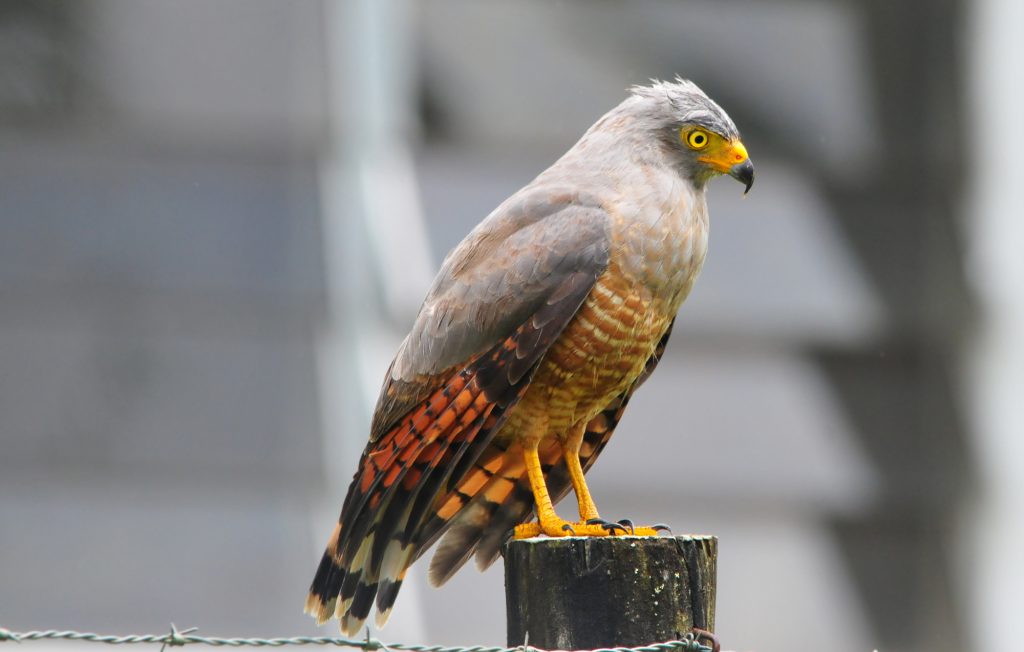
Roadside Hawks are small brown or gray birds of prey with barred bellies. Their tails also have 5 gray bars.
- Length: 12 – 16 in (31 – 41 cm)
- Weight: 8.8 – 10.6 oz (250 – 300g)
Roadside Hawks usually live in Mexico, Central America, and South America, but some have ventured as far as Southern US states.
They eat small mammals, lizards, and insects and can often be spotted on wires and posts.
42. Eurasian Marsh-Harrier
43. Crane Hawk
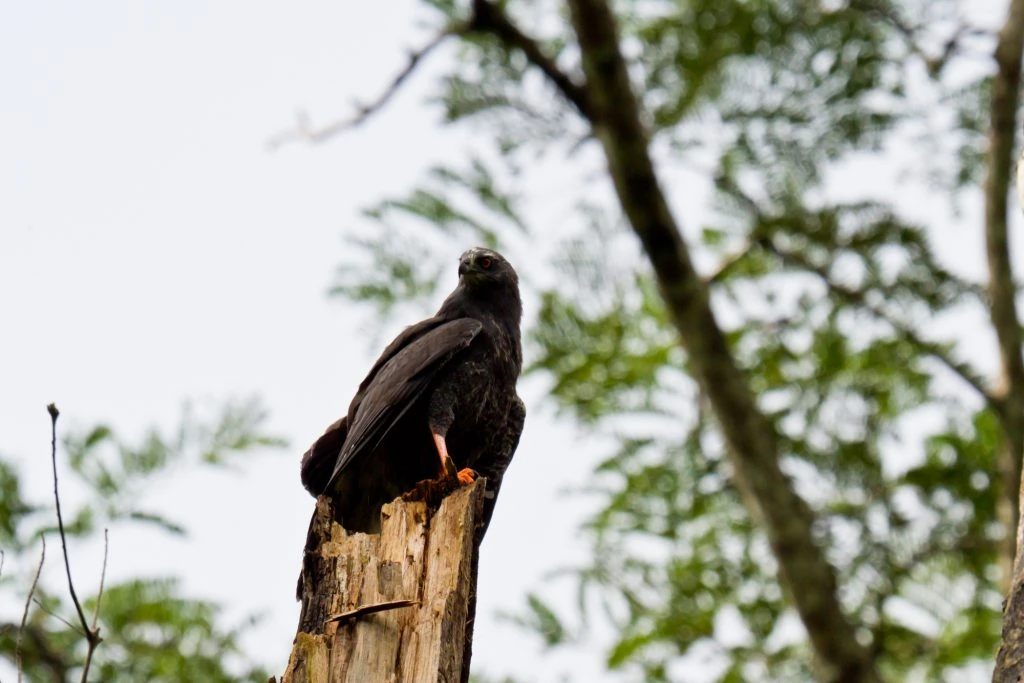
Crane Hawks are slightly odd-looking, with small heads and long legs. They can range in color from solid black to banded gray, have white stripes on their tails and have red legs.
Birds in the north of the range have red eyes, and those in the south have yellow eyes.
- Length: 15 – 21 in (38 – 54 cm)
- Weight: 8 – 18 oz (225 – 519g)
Crane Hawks are resident in Central and South America and along the coasts of Mexico. They sometimes move north into southern US states depending on conditions.
They eat small mammals, lizards, snakes, and birds and are found in wooded areas hunting in the trees for hiding spaces as they have double-jointed legs and can get in places that other birds of prey cannot.
44. Variable Hawk
45. Long-legged Buzzard
46. Chinese Sparrowhawk
47. Eurasian Sparrowhawk
Vultures
48. Black Vulture
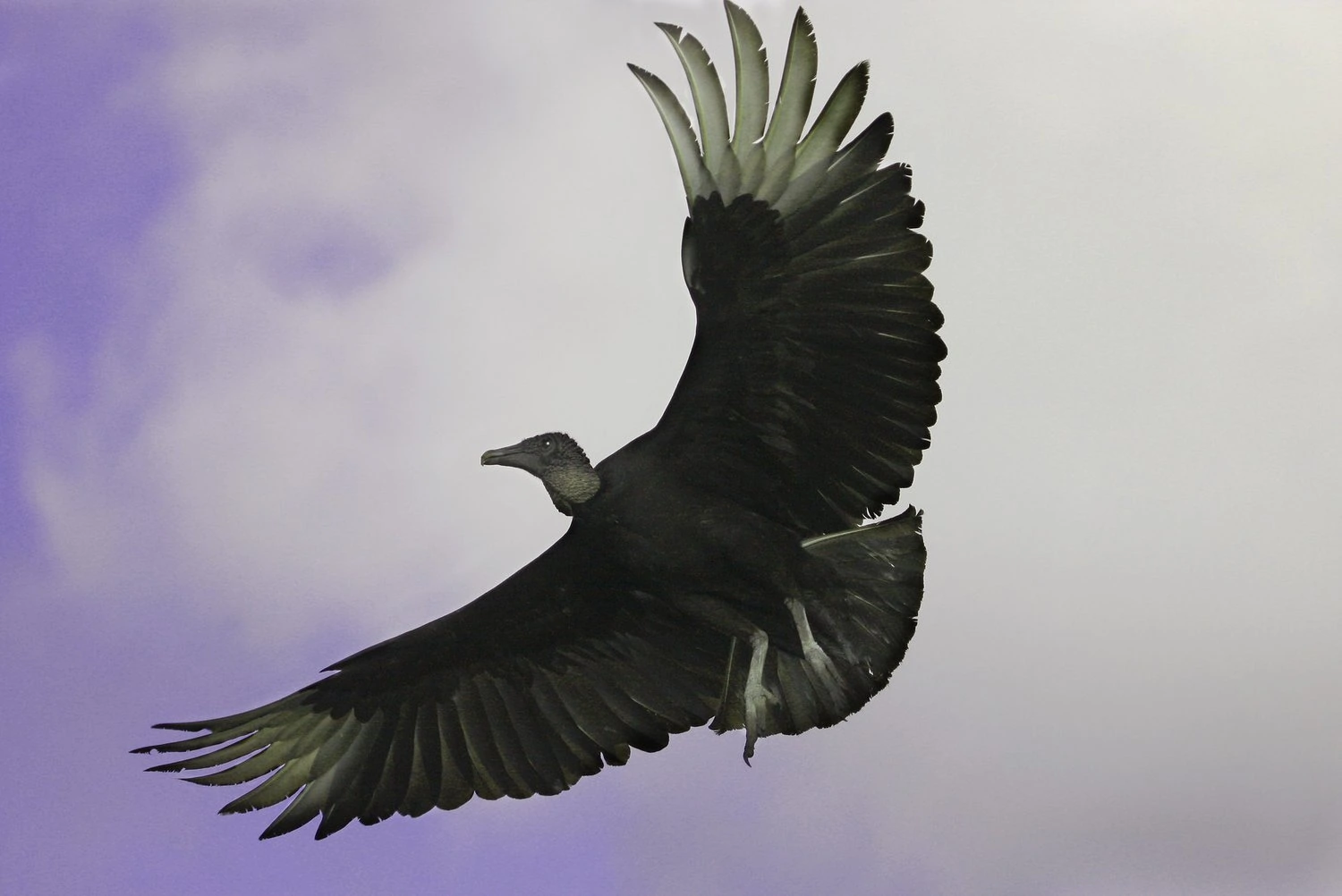
The body of the Black Vulture is black. They’re considered the blackest of all the vultures. Their backs, wings, breasts, bellies, and tails are black, although they have silvery patches on the underside of their wings that make it look like they have fingers when in flight. Their eyes are brown and they have grayish-white legs.
The Black Vulture has a gray, featherless head and neck that look like wrinkled skin.
Black Vultures are “bald” out of necessity because it needs to stick its head into the bodies of dead animals to get to their juiciest parts. Having feathers on their heads will make it hard for them to clean themselves up when bits and pieces of the carrion stick to the feathers.
The Black Vulture is also commonly called American Black Vulture but is not its official name. It’s only meant to distinguish it from the Eurasian Black Vulture, Aegypius monachus.
- Coragyps atratus
- Length: 23 – 27 in (58 – 69 cm)
- Weight: 76.8 oz (2177 g)
- Wingspan: 54 – 60 in (137 – 152 cm)
You can find Black Vultures in open areas of lowland and middle elevations. They are often seen in forested landscapes and roost in wooded areas that are close to water. Other habitats include shrublands, grasslands, swamps, and pastures, and they are even sighted in human-occupied towns foraging in trash cans and garbage dumps.
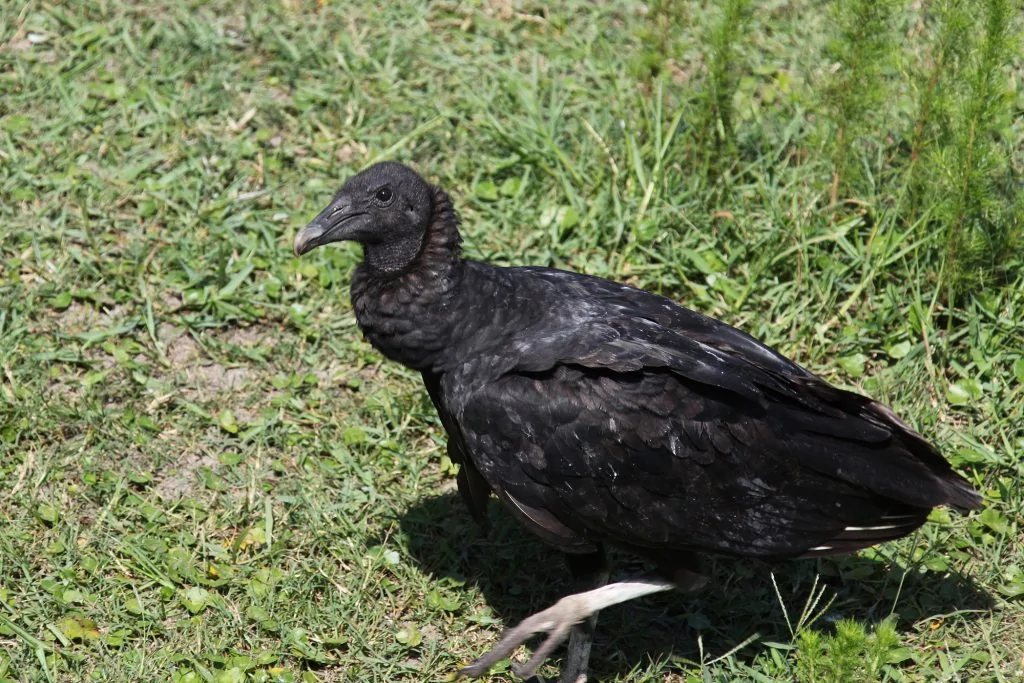
Black Vultures eat practically anything, but mainly they eat carrion or decaying animals. They may be able to see dead animals on the ground themselves, but they usually rely on other scavenger birds to direct them towards food.
They eat small to large-sized dead poultry, raccoons, coyotes, snakes, and even floating fish. They also kill small or vulnerable animals like newborn calves, lambs, and tortoises and spend time at the dumpsters and landfills rummaging among the trash.
Black Vultures Calls: They do not make many sounds and instead have a deep ‘coo’ grunt.
Nests of Black Vultures technically are non-existent since they don’t build them. They just lay their eggs on the ground in places like caves, abandoned buildings, and thickets. They may also put them inside hollow trees and tree stumps and re-use successful nesting sites for many years.
Female Black Vultures lay one to three eggs that both parents incubate for twenty-eight to forty-one days. Once they hatch, they are fed by their parents through regurgitation, meaning parents spit up food from their own stomachs and into the mouths of their babes. They nurture their young for as long as eight months.
Black vultures form strong social bonds such that they have communal roosts and they share food among relatives. They’re extremely selective about non-relatives joining in the communal roosts and will attack those who will try.
Fun Fact: The Black Vulture has a keen sense of sight but not a keen sense of smell, so it will follow others that have that skill in order to find food.
49. California Condor
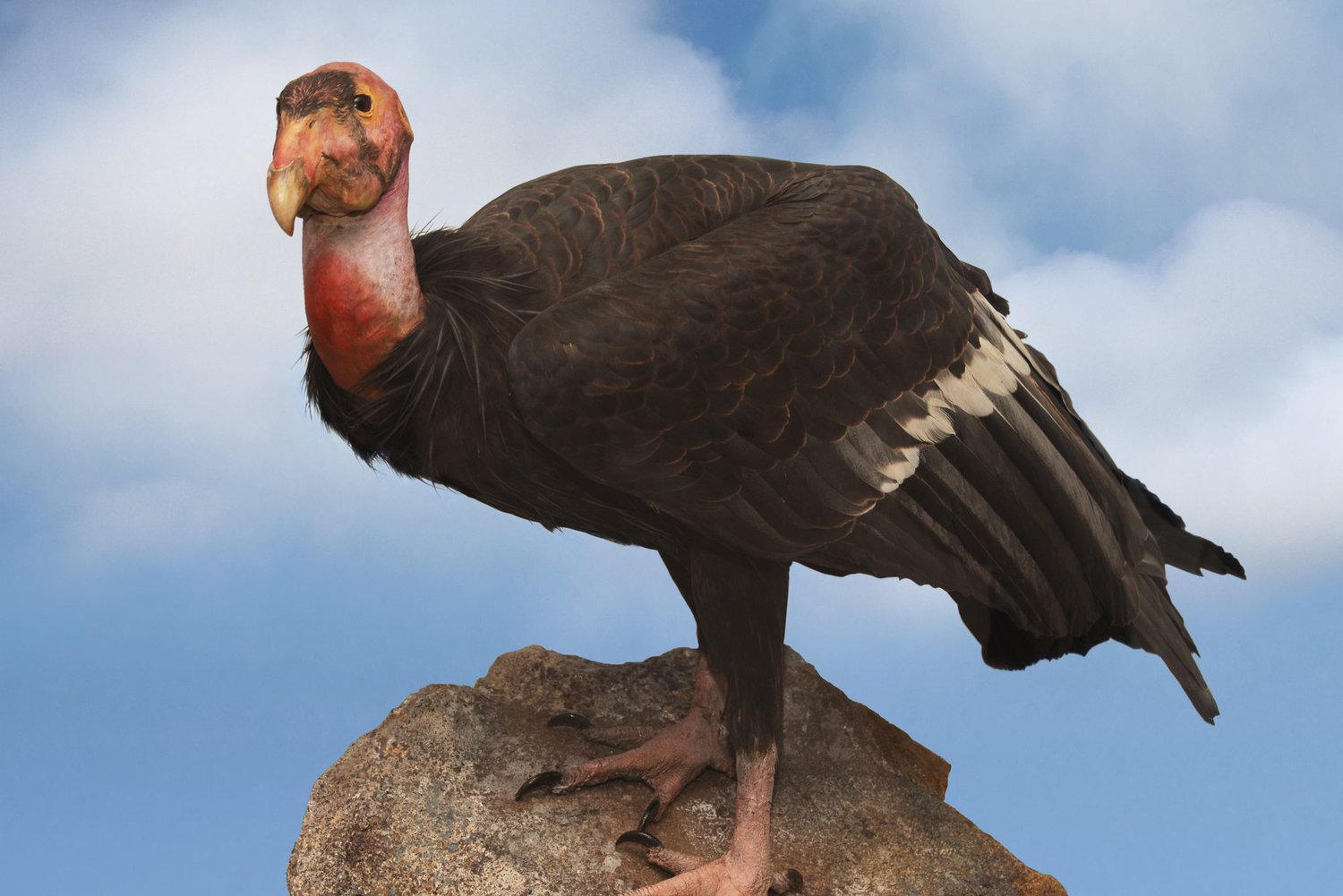
The California Condor is the largest North American land bird. It is a critically endangered species with only about 500 living individuals as of 2020.
California Condors are very large birds of prey. They resemble airplanes when in flight because of their broad wings, which they hardly flap at all. Their primary feathers also look like long “fingers” as they’re spread out when in the air.
California Condors have yellow skin coloring on their heads and necks. The color can change from yellowish to red (and variants in between) during courtship or when it’s angry or distressed. Their eyes are brownish-red with red scleras (surrounding the iris).
They have pinkish air sacs in the throat and near the breast area, which puff out during courtship or for aggressive displays. They also have black feathers around the base of their necks. Their backs and wings are black. The underside of the wings have triangular white patches that are visible in flight.
Juveniles look similar to adults, with the exception of the coloration on the head and the patches on the underside of their wings. A Juvenile’s head is mottled dark brown with black. Under its wings, the color is mottled gray instead of white.
- Gymnogyps californianus
- Length: 46 – 52 in (117 – 132 cm)
- Weight: 356.8 oz (10, 112 g)
- Wingspan: 72 – 108 in (183 – 274 cm)
You can find California Condors in a variety of habitats as they need open or semi-open grasslands, scrublands, and woodlands for foraging and nesting. They also need as much as 6,000 feet of elevation and open and windy areas, like cliff edges or exposed tree branches, to give them high perches for launching into flight.
The California Condor normally uses thermals, or upward currents of warm air, to gain height and keep them soaring in the air.
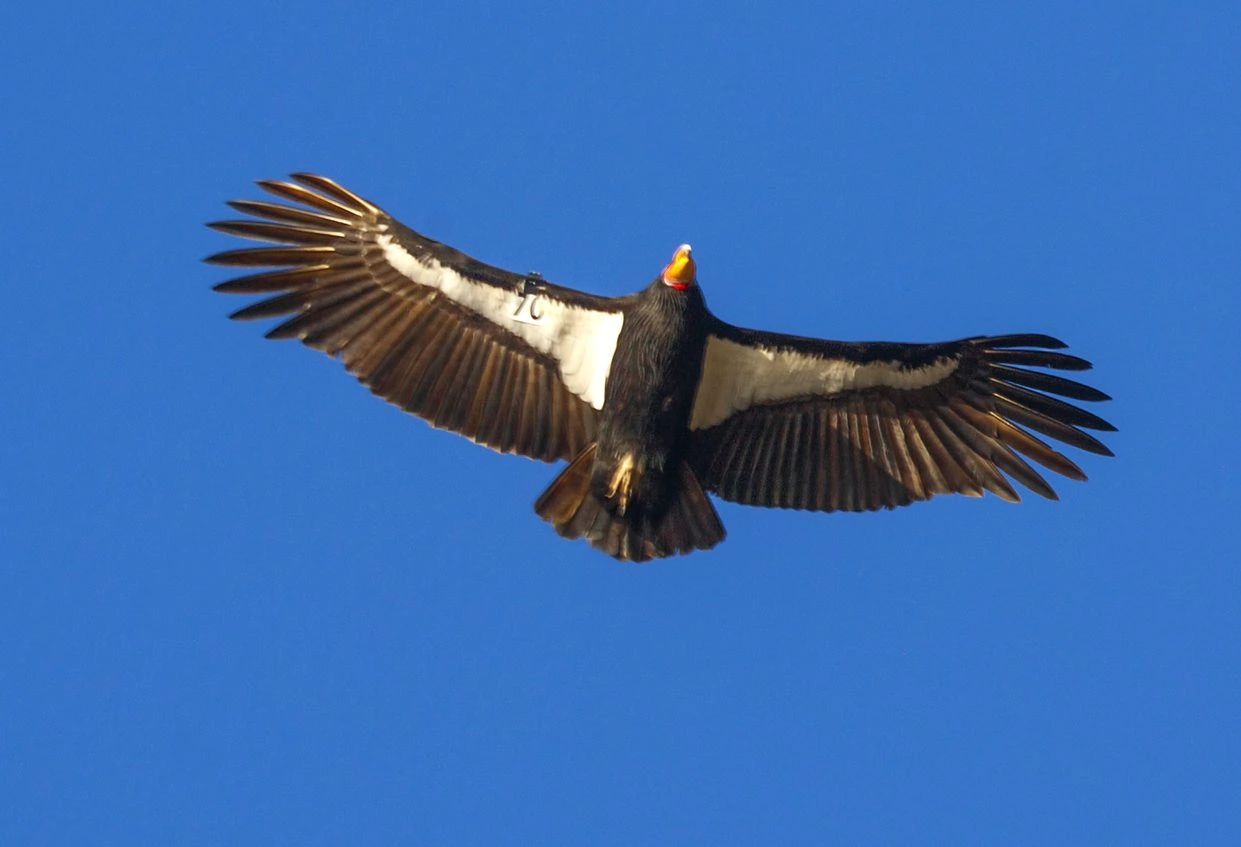
California Condors are carrion eaters. Carrion is flesh from any decaying animal. They eat medium to large-sized dead animals, preferably those recently killed or died. These animals include sheep, deer, elk, horses, sea lions, and whales. They eat even the bones of smaller animals to supplement their calcium needs.
California Condor calls: They are usually silent, but can make some grunts, hisses, or snorts.
Nests of Calfornia Condors are usually in cliff caves, but these are not actual nests because California Condors don’t actually build them. The female lays only one egg every other year. This is one of the reasons why their numbers are too few. But, the good thing is that they are known to “double clutch”, meaning they may lay another egg to replace a “lost” one.
Researchers then take advantage of this to double the reproductive rate by taking one egg to raise themselves and leaving the second egg for the actual parents to raise. Incubation is done by both parents for around fifty-five days. Once hatched, the young stay with their parents until they’re in their second year.
Fun Facts: California Condors have a long life span, reaching up to sixty years. They were originally almost extinct despite this, but conservation efforts have proven successful, and now there are as many as 500 birds in the wild and in captivity.
50. Turkey Vulture
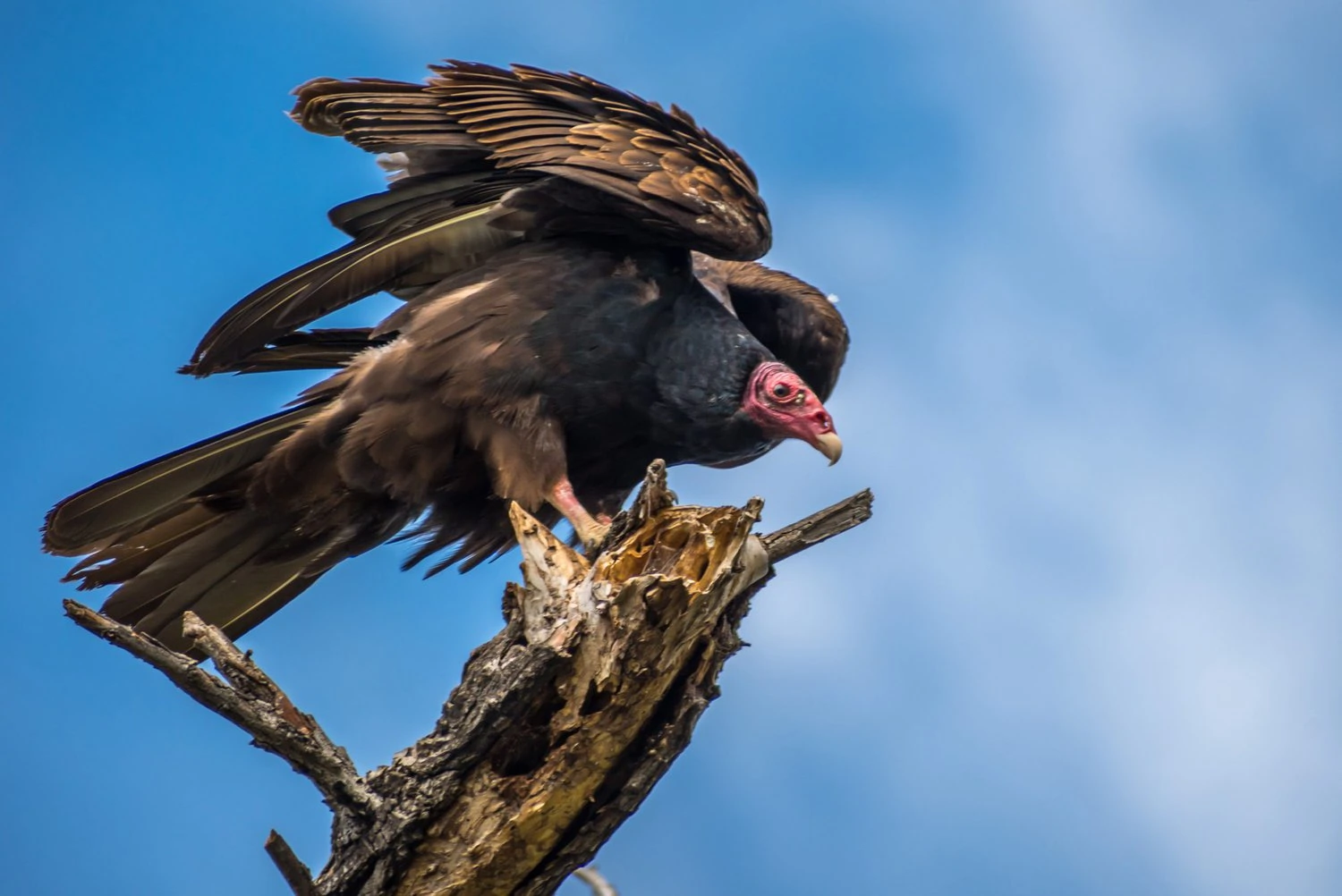
Turkey Vultures are aptly named. They do look like turkeys with their big, bald, red heads and upper necks and brownish-black bodies. However, they are larger than turkeys, and when they’re in flight, their broad wings are slightly raised and make a “V”.
Under their wings, they have gray coloring, making it seem like they’re two-toned. Their eyes are dark brown, and their bills are light-colored.
There are a total of 6 subspecies of Turkey Vultures, and three of them are in North America, which is why they are sometimes classified as “Northern” Turkey Vultures. There are only minor differences among them, mainly tail and wing proportions and color in the underwing feathers.
- Cathartes aura
- Length: 26 – 32 in (66 – 81 cm)
- Weight: 51.2 oz (1451 g)
- Wingspan: 68 – 72 in (173 – 183 cm)
You can find Turkey Vultures in a wide range of habitats, but the most common is open and semi-open areas next to woodlands. They need open areas, like grasslands, shrublands, deserts, and wetlands for foraging. They also need forests with high trees for nesting and roosting, and they need middle to high elevations, like hills and mountainous areas, to give them a height advantage for taking flight.
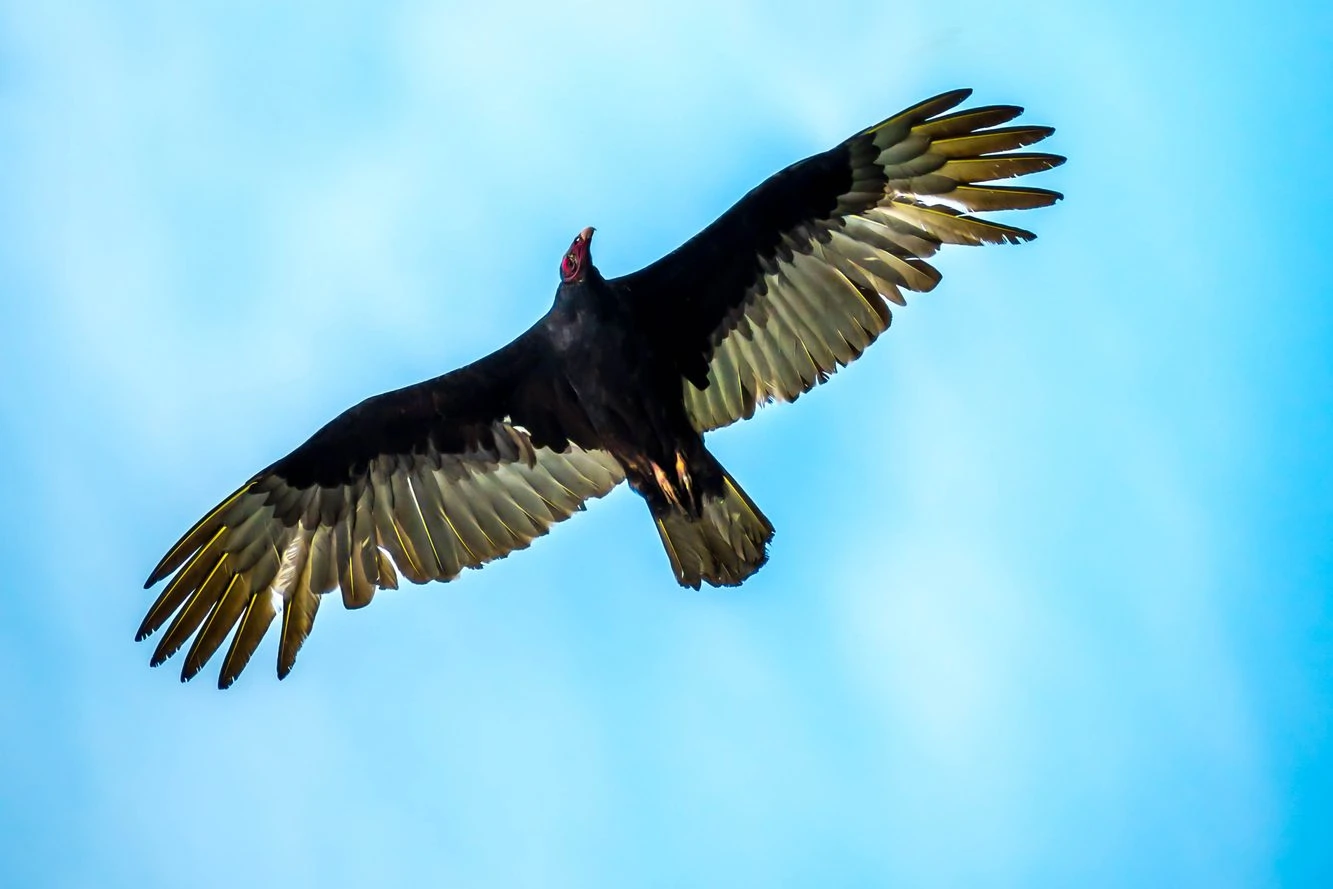
Sometimes, they will also venture into farmlands or pasturelands for foraging and roosting. Human-made structures are also taken over by them when they’re in urban areas, but only if they can’t find their preferred habitats.
Turkey Vultures’ main source of food is carrion or recently dead or decaying animals as long as it hasn’t decayed too much. They may feed on roadkill and washed-up fish and may even kill small or weak animals.
Turkey Vultures calls: They can only make a raspy hissing sound, but are usually silent.
Nests of Turkey Vultures are often found in sheltered areas, like crevices in cliffs and old buildings. They may also use hollow trees or logs and dense thickets. However, they don’t actually build nests. Instead, the female just lays one to three eggs on the ground at the nesting site. Incubation takes around thirty-eight to forty-one days and is accomplished by both parents.
Fun Facts: The sense of smell of Turkey Vultures is quite strong and they’re able to detect odors of decaying or dead animals on the ground from great distances.
When Turkey Vultures are threatened or aggravated, they will vomit to provide a distraction and fly away. They may even pretend to be dead.
Falcons
51. American Kestrel
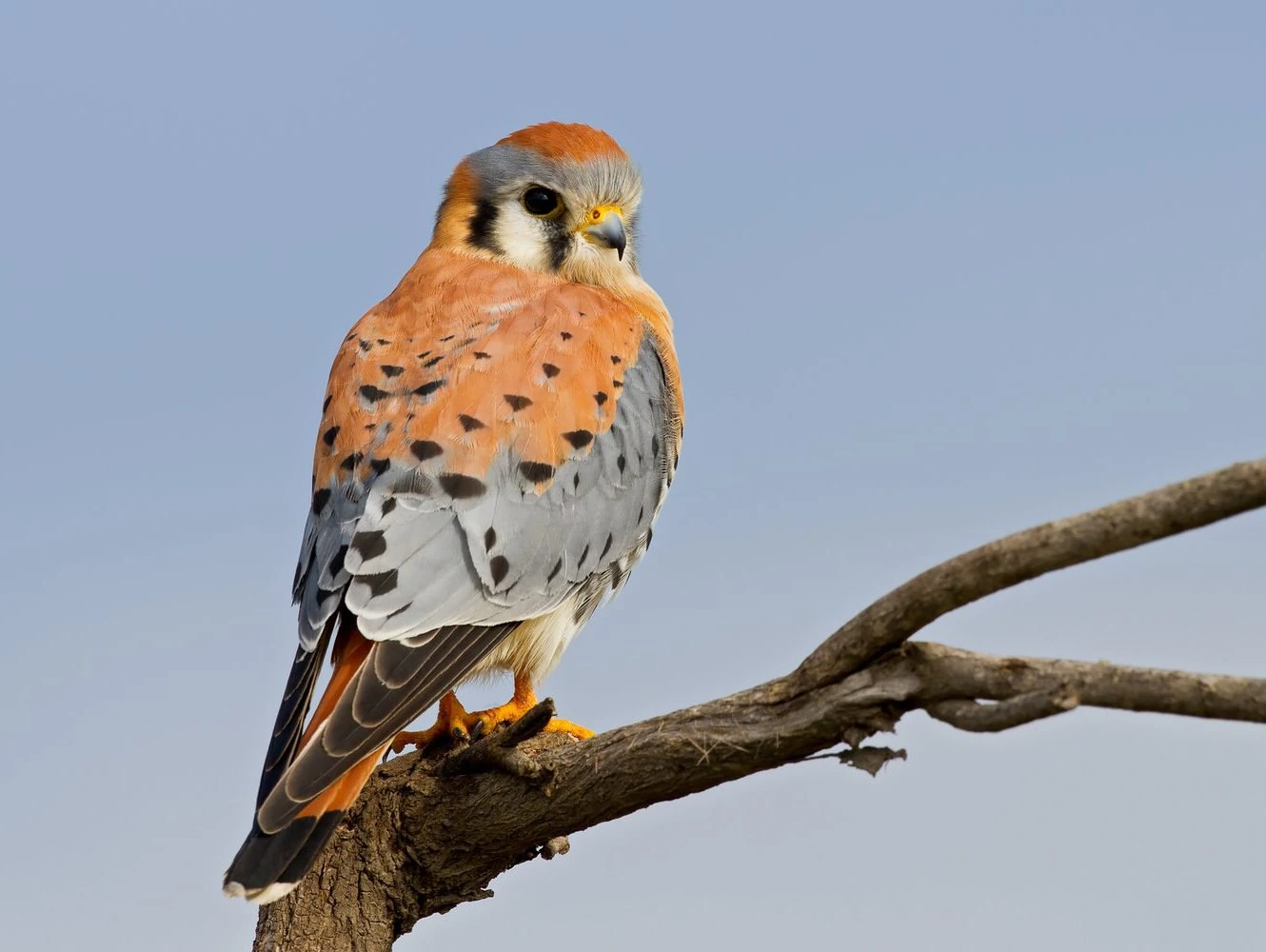
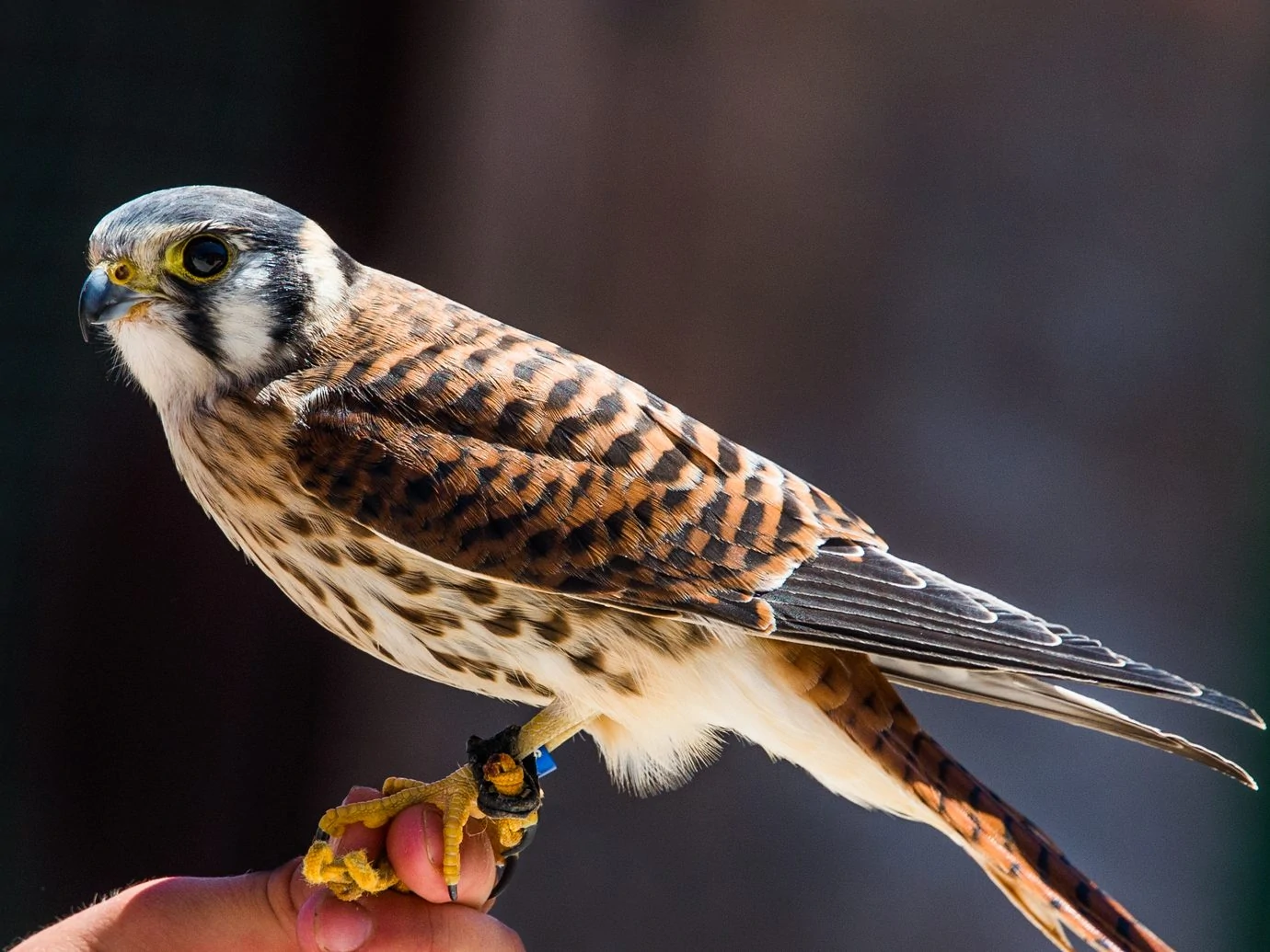
American Kestrels are the smallest and most colorful falcons in North America. Males and females have different colors and markings.
Adult Male American Kestrels have dark gray heads with varying amounts of rufous on the crown, white throats, blue-black bills, and unique vertical slashes on their white faces – one under their eyes and another behind their eyes. This is significant because most falcons only have one.
Their bellies and breasts are orange with brown spots, their backs are red-brown, their wings are blue-gray with white spotting, and they have yellow legs and feet. Their underwings appear spotted. Their tails are reddish-brown with one broad black band and a white tip.
Female American Kestrels share similar traits with the males – rufous crowns, gray heads, white faces, and two black vertical slashes on the face. They also both have two black spots at the back of their heads that deceives potential attackers when hunting from the rear.
However, female American Kestrels have a general rufous coloring, particularly on their backs and wings, and their barring is more pronounced. They have white bellies and breasts with rufous streaks. Their tails are also reddish-brown with many bars.
- Falco Sparverius
- Length: 9 – 12 in (23 – 30 cm)
- Weight: 3.9 oz (111 g)
- Wingspan: 20 – 25 in (51 – 64 cm)
American Kestrels are the most common falcon with seventeen subspecies living in varied environments and habitats across the Americas. With many subspecies, American Kestrels have plenty of regional variation in their coloring, markings, and vocalizations.
American Kestrels are found in North and South America. Those that breed in Canada migrate south for winter, but the rest remain resident all year.
You can find American Kestrels mainly in open areas without dense cover as they prefer viewing their whole territory from a single perch.
They typically live in grasslands, pastures, plains, meadows, agricultural fields, deserts, and even urban environments. You may see them perched on fence posts, lone trees, and low shrubs.
Since American Kestrels can inhabit a wide range of environments, they can also have a diverse range of prey. They can hunt and eat grasshoppers, crickets, cicadas, beetles, and dragonflies. What they do is sit and wait on a perch. When they have their prey in sight, they either catch it on the ground or while in flight.
American Kestrels can also hunt by hovering while scanning for prey on the ground.
They may use this strategy when hunting mice, voles, lizards, frogs, and small birds. American Kestrels only attack when they’re sure that they will succeed.
American Kestrel Call:
Nests of American Kestrels include abandoned nests of woodpeckers or other birds, their own tree cavities which they’re reusing, their old nesting sites along cliff ledges and tops of buildings, and tree holes or cavities in cactuses. They also make use of artificial nest boxes.
Female American Kestrels usually lay up to seven eggs. Incubation begins only when all eggs have been laid. The female incubates the eggs for about a month. During this time, the male hunts for food and feeds his bounty to the female. He may sometimes assist in incubation to let the female hunt on her own.
Attracting American Kestrels to your backyard is possible if you put up nest boxes that are within their preferred habitats. They need a perch and open area and preferably with no outdoor pets.
Fun Fact: American Kestrels can see using ultraviolet light which comes in handy when trying to hunt their prey. It is especially handy when seeing the trails of urine that are left by voles that allow the American Kestrels to pinpoint their exact location.
52. Peregrine Falcon
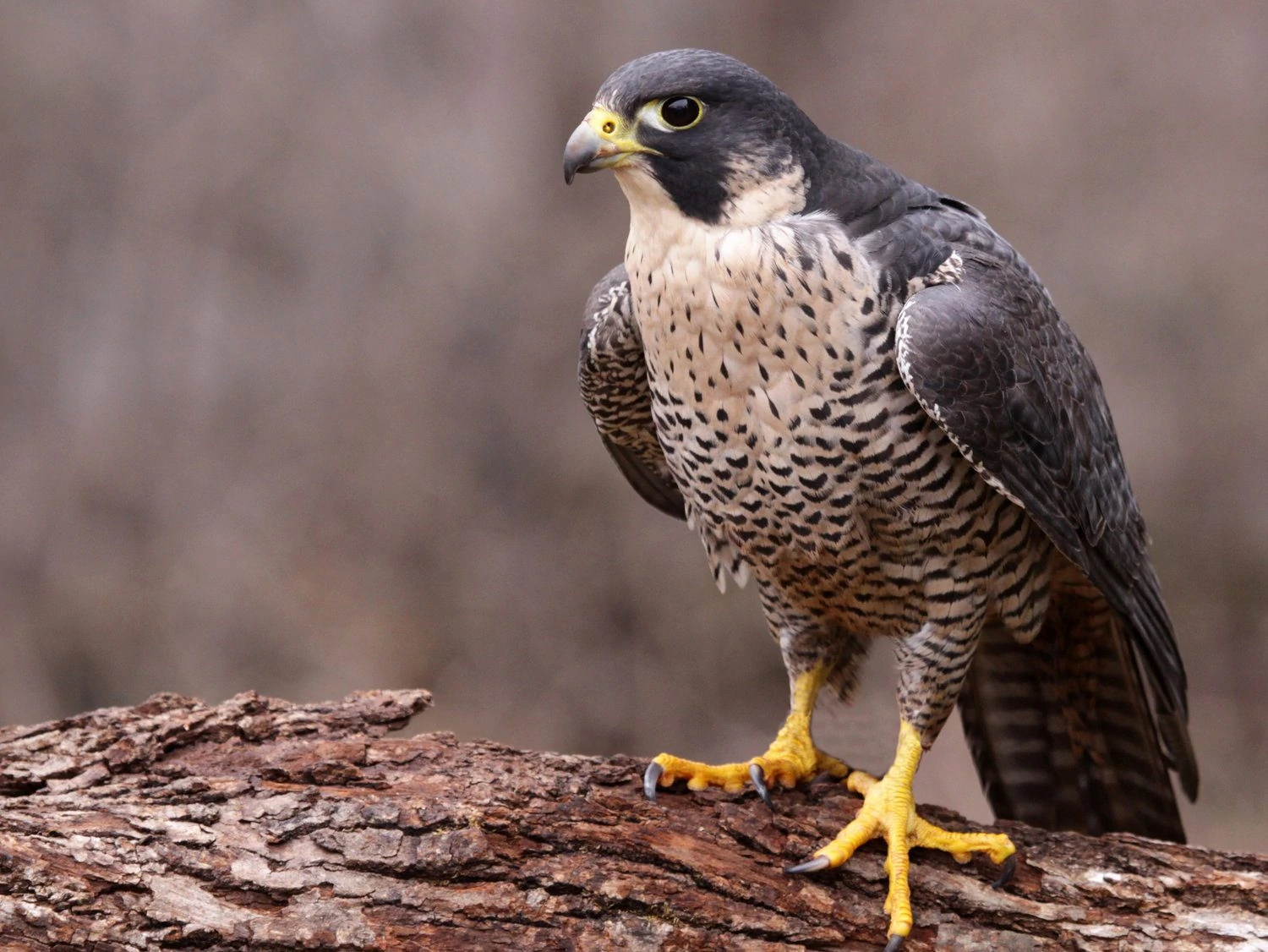
The Peregrine Falcon holds several distinctions. It is known as the fastest bird in the world, the fastest of all animals, and it is also the world’s most widespread raptor.
Peregrine Falcons are dark on the back and lighter underneath and they appear to have dark gray to black hoods on their heads. Their tails are bluish-black with bars, a black tip, and white rims. They have yellow legs and feet.
They have predominantly dark heads with bright yellow earrings, yellow ceres (base of the bill), and gray-to-black hooked bills. Their backs and wings are bluish-black with faint barring and black wingtips. Their underwings, flanks, bellies, and thighs are heavily barred with black and white.
Their throats and breasts may be all-white but sometimes they are spotted or barred.
Females are larger but similarly colored as the males. Juveniles generally have brown coloring and they have heavily streaked underneath. Their eyerings and ceres are also bluish, instead of yellow.
- Falco peregrinus
- Length: 16 – 20 in (41 – 51 cm)
- Weight: 52.91 oz (1499 g)
- Wingspan: 43 – 46 in (109 – 117 cm)
Peregrine Falcons are widespread throughout the world. In North America they breed predominantly in the arctic and migrate to coastal and southern states.
You can find Peregrine Falcons anywhere in the world except Antarctica. They prefer mountain ranges, open landscapes with cliffs, along rivers and coastlines, and more recently, in urban areas. Generally, they will stay in habitats that have an abundant supply of prey.
Peregrine Falcons are expert hunters, dive-bombing birds, practically any size, at extremely high speeds. Their typical prey include ducks, pigeons, jays, larks, ptarmigans, and starlings. On occasion, they may kill and eat bats and sometimes steal prey like fish and rodents from other hunting birds.
Peregrine Falcon Call:
Nests of Peregrine Falcons are usually on cliff ledges, up to 1,300 feet high. In urban areas, they are mostly found on skyscrapers and tall bridges. In other regions, they use tree hollows for nests.
Typical nests are scrapes where the female “scrapes” a depression in the earth (either soil, sand, or gravel) and where she lays two to six eggs. Both parents take turns incubating the eggs for as many as thirty-three days with the male taking the day shift and the female at night.
Fun Fact: The Peregrine Falcon was considered an Endangered Species from the 1950s to the 1970s because of DDT poisoning. When this pesticide was banned, the species began to thrive again. Today, it’s considered a species of Least Concern.
53. Merlin
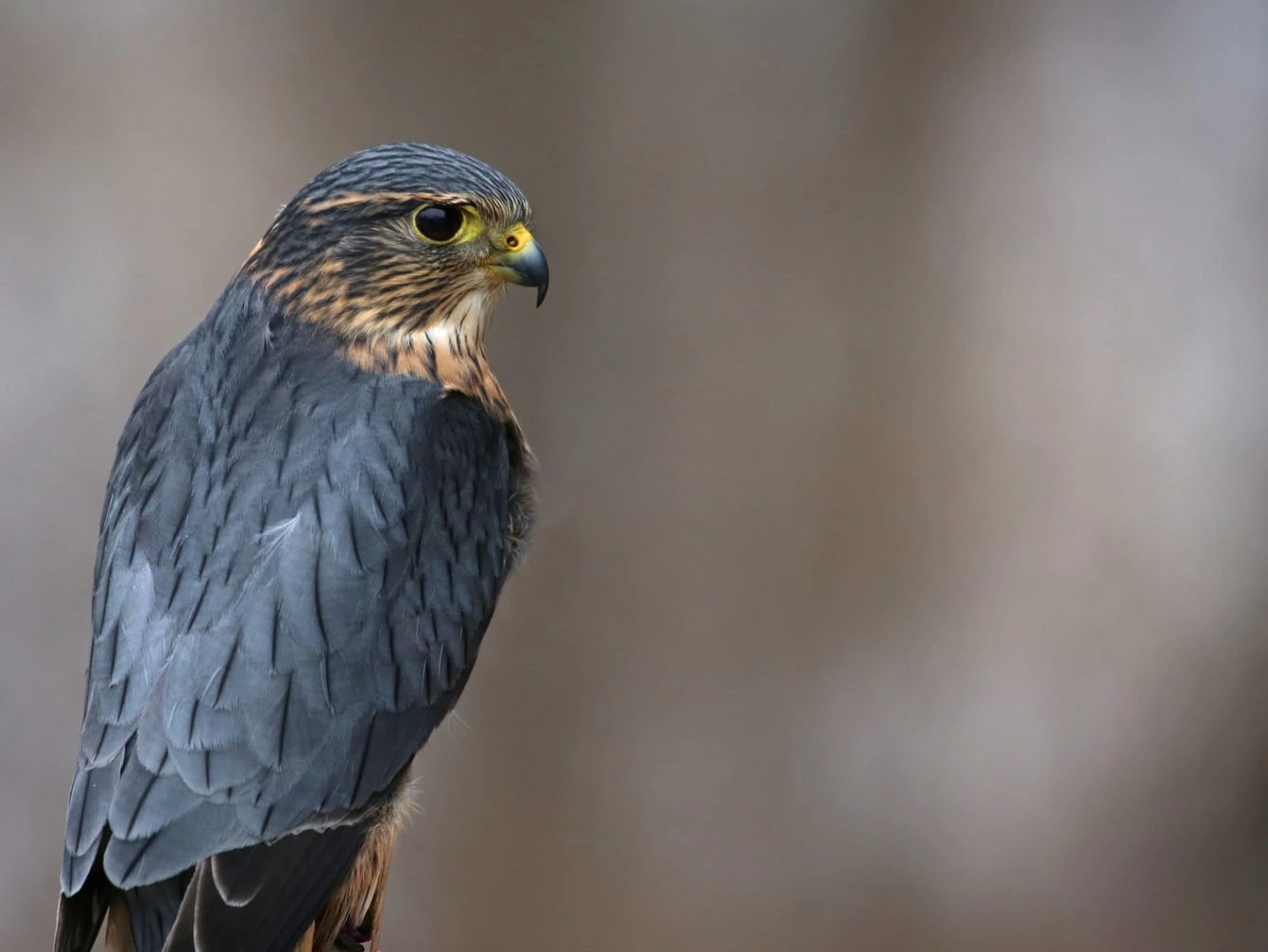
Merlins are small but fierce falcons that have as many as nine subspecies, three are in North America and the rest are in Europe and Asia. In North America, these three subspecies have varying degrees of coloration depending on their geographic location.
The Black Merlin, Pacific Northwest or Coastal Forest Merlins are very dark blue almost black with white or brown-streaked undersides. The Taiga Merlins have intermediate coloring and Prairie Merlins are the palest of the three.
They are all darker on the back and paler on the underside, but this may range from white to brown. They have small hooked bills and yellow skin at the base of their dark bills and around their dark eyes.
- Falco columbarius
- Length: 11 – 13 in (28 – 33 cm)
- Weight: 7.4 oz (210 g)
- Wingspan: 23 – 26 in (58 – 66 cm)
Merlins breed in Canada, Alaska, and northern US states before migrating into the rest of the US, and down into northern South America. They also breed in northern Europe and migrate to southern Europe and the Middle East for winter.
You can find Pacific Northwest Merlins in coastal areas, Prairie Merlins in open areas with shrubs, and Taiga Merlins near forested openings near water. Merlins are slowly moving into urban areas too.
Merlins are usually on the hunt for small birds, whichever has the most supply in their habitat. They attack from the air, chasing their prey at high speed until their prey becomes exhausted.
Breeding pairs also hunt together, with one bird flushing out prey from the ground and the other catching the disturbed prey from above. They will also supplement their main diet with other animals like insects and reptiles.
Merlin Call:
Nests of Merlins are mostly in cliffs and tree cavities without the adults adding any material to them. Sometimes, they will use abandoned birds’ nests. What’s important for Merlins is that they be able to see over their territory. The female lays four to five eggs and will incubate them for about a month.
Fun Fact: Merlins were once known as “Pigeon Hawk” in North America.
54. Crested Caracara
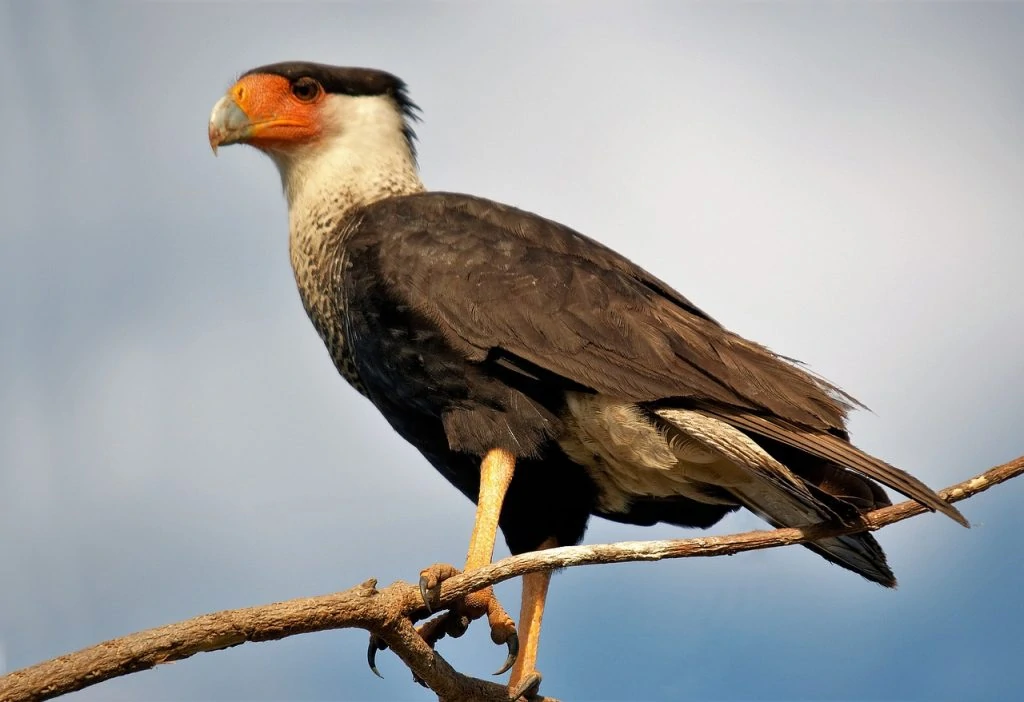
Crested Caracaras are large, dark-bodied falcons with distinctive flat heads with black scruffy crowns, and massive orange bills with gray tips. These chunky birds feed on carrion and are aggressive to other birds such as vultures muscling in on their food.
Their throats and rumps are white as are their breasts but with black fine barring. Their bellies and wings are black. Their tails are white with black barring and a thick black band at the tip. Their legs and feet are yellow.
Southern Crested Caracaras are browner than Northern Crested Caracaras which are more black.
Juveniles of both Crested Caracaras look similar to the adults except they’re browner. They have gray or purple facial skin, a buff neck and throat, white with brown streaking on the chest, neck, and back and grayish legs and feet.
- Caracara cheriway
- Length: 20 – 25 in (51 – 64 cm)
- Weight: 33.6 oz (952 g)
- Wingspan: 45 – 48 in (114 – 122 cm)
Crested Caracara do not migrate and are found in Central and South America, Mexico, and southern US states. They are also spotted more sporadically across the rest of the United States and into Canada.
You can find Crested Caracaras in open and semi-open areas, like prairies, deserts, savannahs, and agricultural lands. It’s easy to find them as they’re most often perched on high vantage points like fence posts, trees, and cacti as they look out for prey.
They also spend a lot of time on the ground, but not in areas with thick ground cover because this prevents them from doing a running headstart and being able to lift themselves up in flight.
Crested Caracaras are opportunistic hunters. They will go where the prey is and will do anything to get what they can find. For instance, they are known to eat carrion or bodies of small animals that have recently died. They will wade in the water to catch fish with their bills and turtle eggs with their feet.
They also take advantage of fires that disturb animals and give the Crested Caracaras a chance to capture fleeing animals. They also stay with vultures and wait for them to open a dead body since their own bills aren’t capable of it, but then try to chase the vultures away.
Crested Caracara Call:
Nests of Crested Caracaras are built from twigs and vines usually high up in trees, lodged in between strong branches of trees, or in the crooks of cactus arms. The female lays up to four eggs and both parents incubate the eggs for about a month.
Fun Fact: Crested Caracaras are unique in the sense that they’re the only falcon species that build their own nests instead of simply using cavities in trees or taking over abandoned nests of other birds.
55. Prairie Falcon
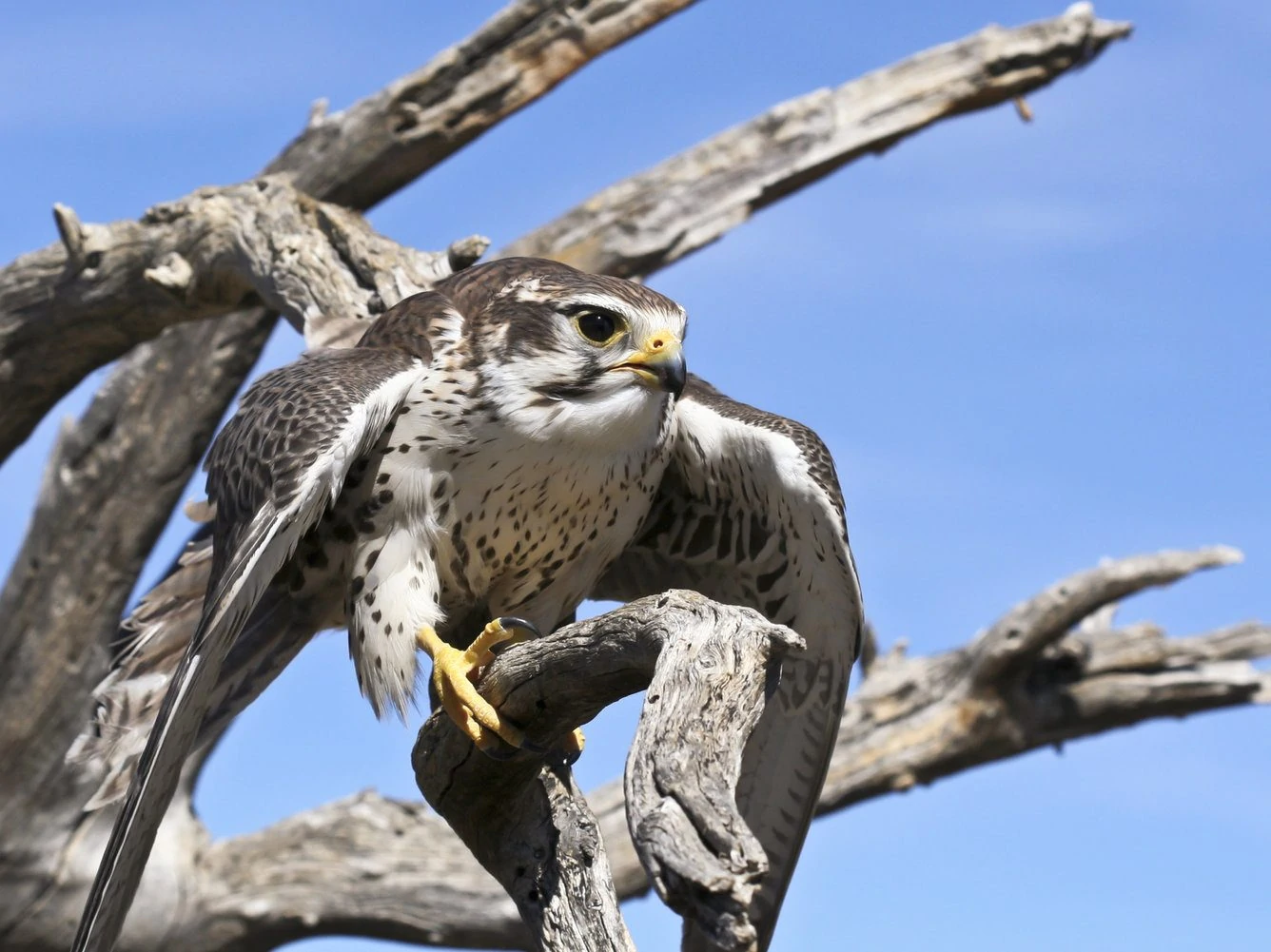
Prairie Falcons are the arid-environment counterparts of peregrine falcons although they’re lighter and need less food than the peregrines. They are sandy-brown on their crowns, napes, backs, and wings.
They have a thin, dark mustache stripe on their faces, white cheeks, and eyebrows. Their underparts are also white with neat brown spotting. Their tails are lighter-colored than their wings and when in flight, they have visible “armpit” feathers that are unique to them.
Females are similar to males except that they’re larger. Juveniles are also the same as the adults but they are darker in color and have heavy brown streaking on their underparts. Their ceres (base of the bill) and legs are grayish.
- Falco mexicanus
- Length: 15 – 19 in (38 – 48 cm)
- Weight: 19.2 oz (544 g)
- Wingspan: 40 – 42 in (102 – 107 cm)
Prairie Falcons are widespread in western US states and can also be found in southwestern Canada and northern Mexico.
You can find Prairie Falcons in open areas like prairies, dry plains, and barren mountains, with cliffs and buffs for nesting. They also frequent grasslands, agricultural fields, alpine tundra, and high desert.
The diet of Prairie Falcons is mostly small mammals and small to medium-sized birds. When looking for prey, Prairie Falcons prefer to hunt and stalk prey smaller than themselves so that they’re easier to kill.
Prairie Falcons can easily kill ground squirrels, prairie dogs, chipmunks, sparrows, doves, quail, pigeons, mallards, and even lizards and snakes. When nesting, they will hunt prey that they can carry home for their young and their females. They are also known to stash food in separate sites in case hunting is not successful.
Prairie Falcon Call:
Nests of Prairie Falcons are often found on ledges on a cliff, halfway up the cliff face to prevent predators from reaching them. They will also make use of both natural and artificial crevices as nests. They may also nest in trees, caves, and on top of buildings.
Prairie Falcons’ nests are just scrapes or depressions which hold the eggs. The female lays around two to six eggs that she alone incubates roughly for about forty days. During this time, the male hunts and feeds her. It takes around sixty-five days for the young to be self-sufficient.
Fun Fact: Prairie Falcons can dive at speeds of up to 120 mph in their pursuit of food.
56. Gyrfalcon
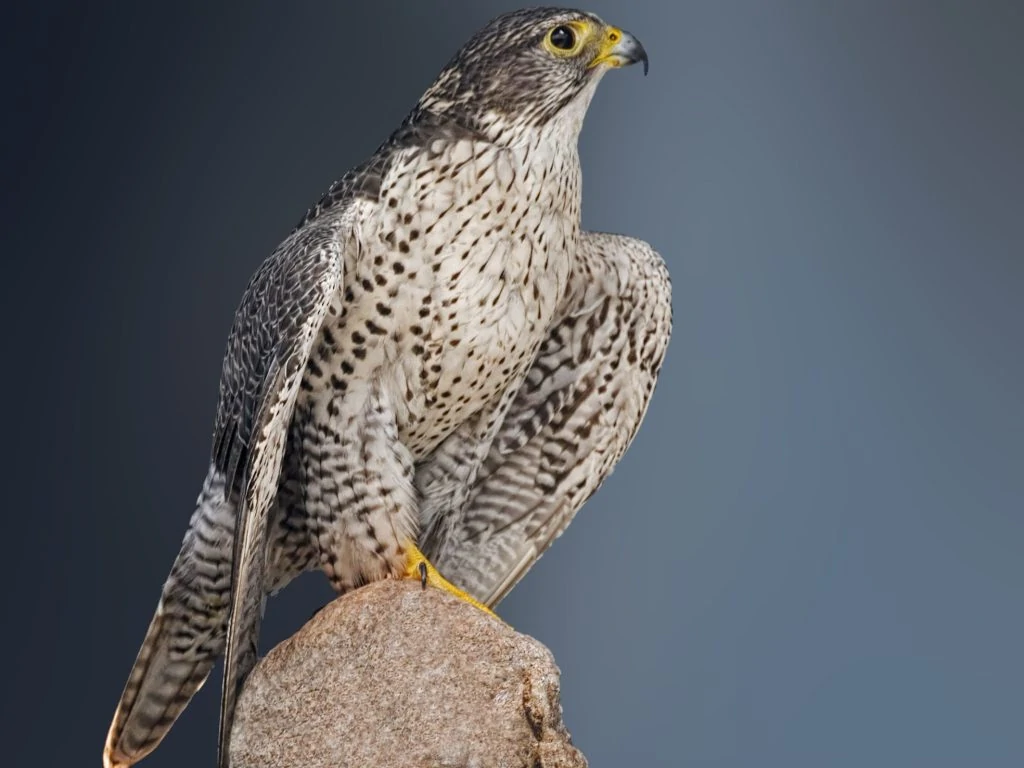
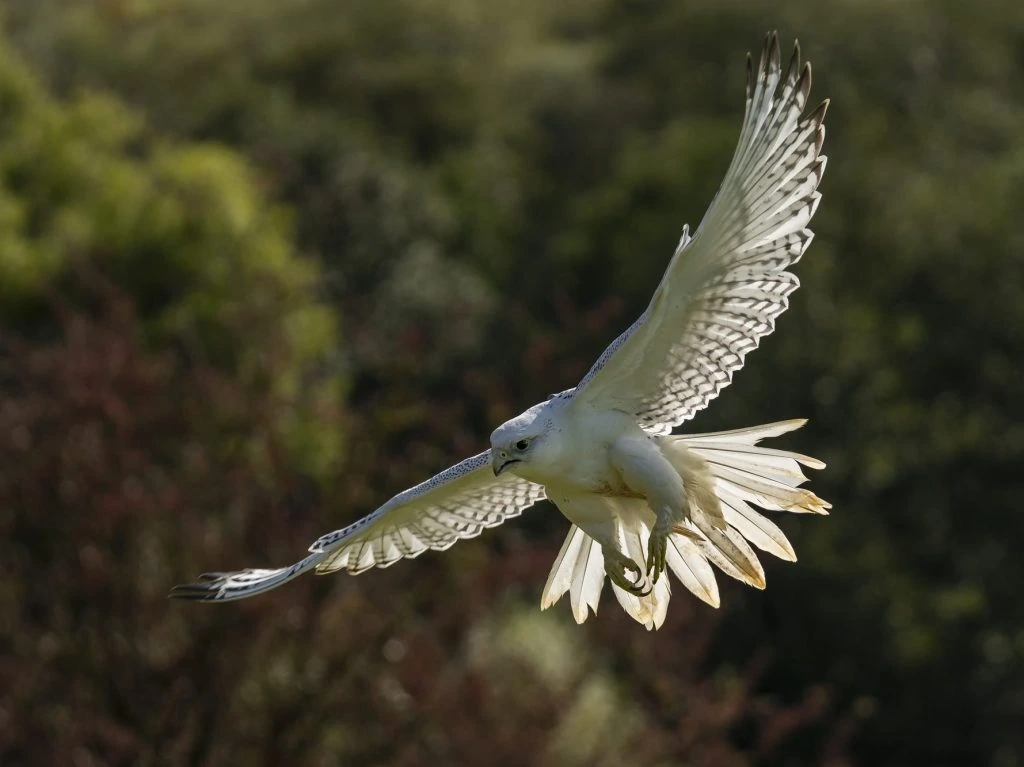
Gyrfalcons are the largest Falcons and are apex predators of the Arctic, where they snatch birds from the sky or dive at great speed to catch unsuspecting prey from the ground.
Their coloring varies greatly but generally have three morphs – white, silver/gray, and dark. Silver/gray is most common in North America
The silver/gray morphs are heavily banded gray and white on their upperparts but some are mostly gray without obvious banding. Their underparts are evenly spotted and white at the throat. Juveniles have solid dark heads and are browner overall.
The White morphs of Gyrfalcons are white with brown/black barring on their upperparts with dark wingtips and a white tail. Some birds have barring on their tails and spots on their breasts. Juveniles are similar but have more barring on their upperparts but have faint streaks on their underparts.
- Falco rusticolus
- Length: 20 – 25 in (51 – 64 cm)
- Weight: 41.6 oz (1179 g)
- Wingspan: 48 – 64 in (122 – 163 cm)
Gyrfalcons breed in the high arctic of Canada before migrating south across Canada and northern US states, those that breed further south in the arctic remain all year. They are also found in Europe.
You can find Gyrfalcons in one of the harshest places on earth, the arctic tundra. They usually stay on cliffs near shorelines or rivers and with a vast open space where they can easily hunt prey. When they migrate during the winter, they stay in areas with plenty of birds for them to hunt, like coasts, reservoirs, grasslands, farmlands, and river valleys.
Gyrfalcons primarily hunt ptarmigans and waterfowl but they also hunt and eat songbirds. Their diet is not limited to birds since they also prey on hares, ground squirrels, and arctic foxes.
They may hunt low by cruising near the ground to scare birds and animals and immediately grab them with their talons. When hunting while flying, they usually strike down their prey from above and let them fall to the ground. They will then retrieve it.
Gyrfalcon Call:
Nests of Gyrfalcons are often found on cliffs. They don’t build their own nests but instead make use of abandoned nests of other birds. The female lays up to five eggs and she incubates them for as many as thirty-six days.
Fun Fact: When the chicks aren’t able to finish off their meal, the female Gyrfalcon will keep or store their leftovers behind some vegetation to retrieve for later.
57. Aplomado Falcon
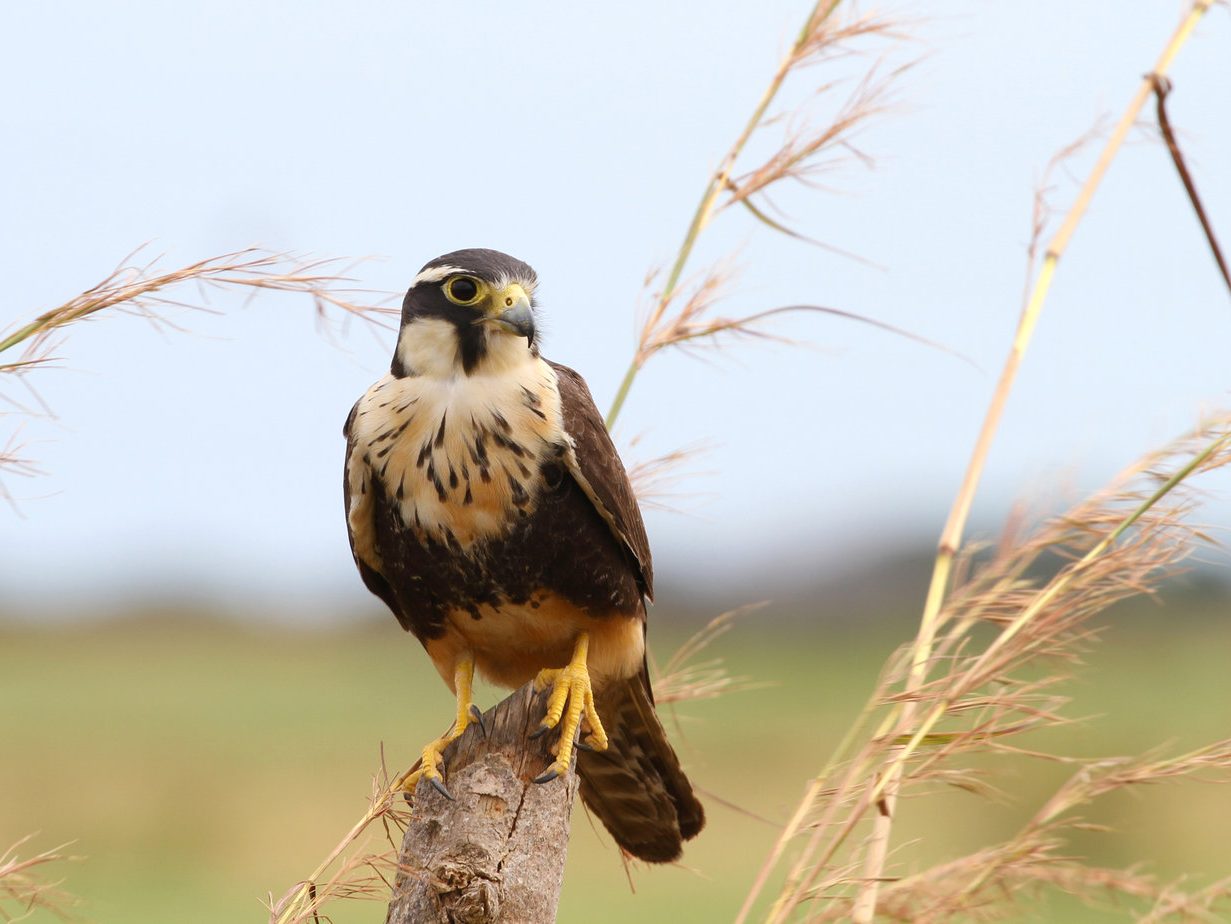
Aplomado Falcons are likened to American Krestels because they’re colorful and they have similar facial patterns. But they are larger and have longer wings and tails.
Male and female Aplomado Falcons appear similar and are slate-gray or brown with lighter patches on their breasts and lower bellies.
They have white heads with bold, thick slate-gray, brown or black stripes on their faces and they have yellow eyerings. Their throats and upper breasts are white, sometimes with some buff and streaks.
They have a darker horizontal band across their bellies. Underneath this dark band, their bellies and flanks are cinnamon-colored.
Their upper parts are slate-gray or brown and their legs and feet are yellow. Their long tails are dark-gray or brown and barred, like the underwings.
While adults have similar characteristics, females are slightly larger than males. Juveniles are browner overall with plenty of streaking on their chest. There are also regional variations between North and South America.
- Falco femoralis
- Length: 15 – 18 in (38 – 46 cm)
- Weight: 9.2 oz (261 g)
- Wingspan: 40 – 48 in (102 – 122 cm)
Aplomado Falcons do not migrate and are resident of Central and South America, Mexico, and into the southern United States.
You can find Aplomado Falcons in open areas with places to perch so they favor desserts, grasslands, prairies, and savannahs. In the United States, they are considered endangered species and are currently being reintroduced but in their other ranges, they are considered as “Species of Least Concern” by the IUCN.
Aplomado Falcons have a varied diet. They eat a lot of insects that they catch and eat while they’re in flight. They also eat lizards and small mammals which they hunt on the ground. But they’re most particularly known for hunting and eating small birds.
When hunting, Aplomado Falcons often work in pairs with one flushing prey from the ground and the other waiting in the air to capture whatever animal is disturbed.
Aplomado Falcon Call:
Nests of Aplomado Falcons are usually the abandoned nests of other birds that are in a tree or bush. The female lays two to four eggs which both parents incubate for about a month or so.
Fun Fact: Aplomado Falcons get their “aplomado” name from the Spanish word meaning the gray color of lead.
58. Eurasian Hobby

Eurasian Hobbies are small falcons with slate-gray crowns, backs, and wings. They have a distinct black stripe below each eye, a yellow eyering, thin white eyebrows, and white throats.
Their breasts and bellies are white with heavy black streaking. Their thighs and undertail coverts are plain orange/rufous and look like they’re wearing pants when in flight. Their tails are finely barred and dark-colored.
Adult Eurasian Hobbies look similar but Juveniles have dark brown upperparts, heavily streaked underparts, and are without the orange “pants”.
- Falco subbuteo
- Length: 11 – 13 in (28 – 33 cm)
- Weight:7.2 oz (204 g)
- Wingspan: 29 – 31 in (74 – 79 cm)
Eurasian Hobbies, or simply Hobbies, are widespread in Europe and are also resident across Asia and parts of Africa. They are considered vagrants to the United States with sightings in Alaska, Washington State, and Massachusetts.
You can find Eurasian Hobbies in many open and semi-open habitats like farmlands, woodlands, grasslands, and savannahs with scattered trees. Areas with rivers and wetlands with scattered trees and even rows of fences are ideal environments for Eurasian Hobbies.
Eurasian Hobbies often prey on large insects like dragonflies, and when that’s not available, will often eat small birds like swallows, house martins, larks, sparrows, and swifts. Eurasian Hobbies are fast and powerful when flying and will often grab their prey with their talons and eat their prey while in flight.
Eurasian Hobby Call:
Nests of Eurasian Hobbies are often old and abandoned nests of other birds, usually in a tree. The female lays about three to five eggs and incubates them for about a month.
Fun Fact: The Eurasian Hobby’s name “subbuteo” became the trademark of a tabletop football game when its owner, Peter Adolph, was denied permission to name the game “Hobby”.
59. Eurasian Kestrel
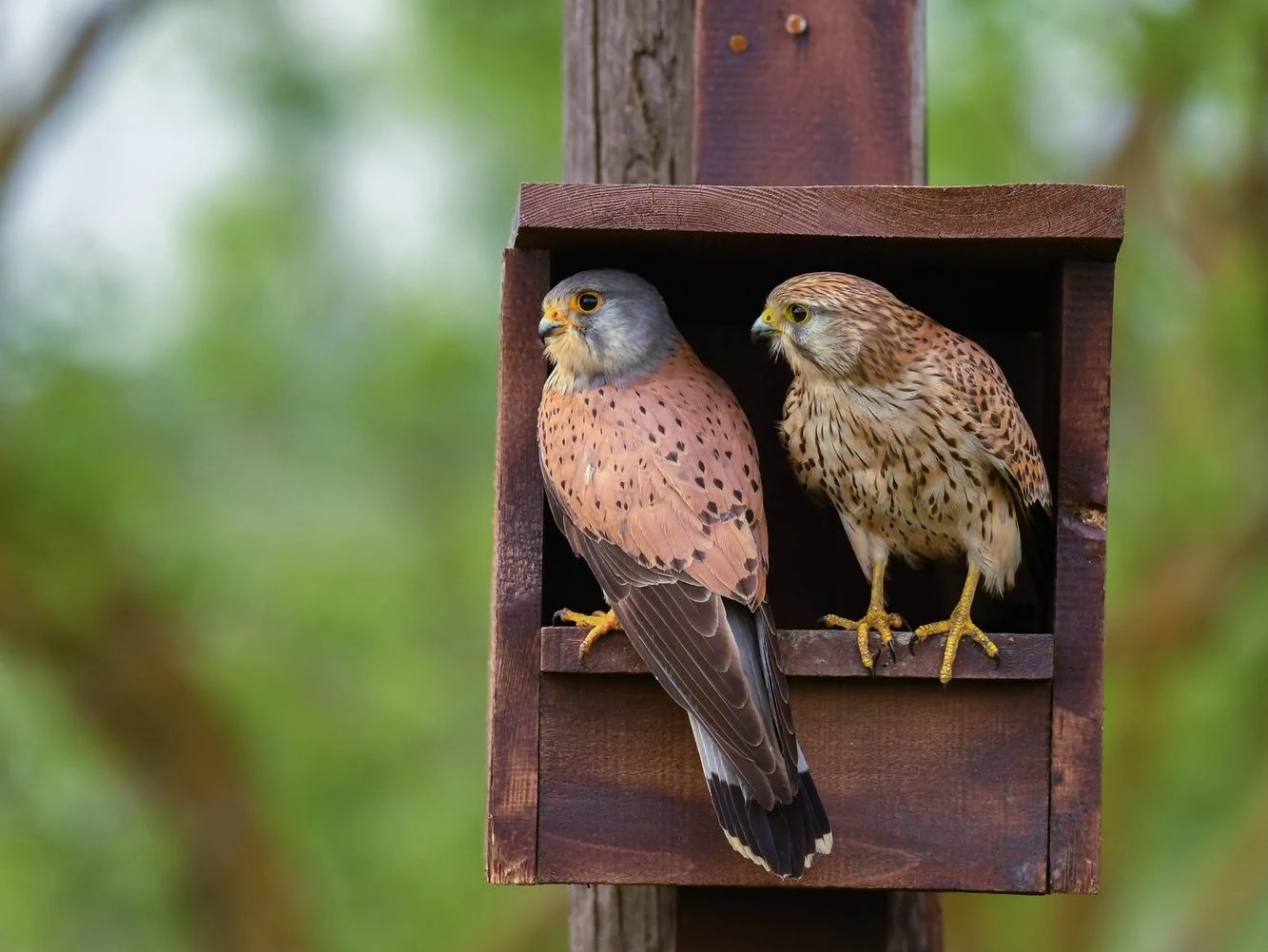
The Eurasian Kestrel, also known as the Common Kestrel, is the Eurasian counterpart of the American Kestrel, but it is larger. They are widespread in Europe and Asia and look very similar to American Kestrels.
Male Eurasian Kestrels have gray heads with black mustache stripes under their dark eyes and have bright yellow eyerings. Their ceres (base of the bills) are also bright yellow as are their legs and their bills are hooked and dark.
They have spotted reddish-brown upperparts and buff brown-streaked underparts. Their wings are long with their primary (outer) flight feathers blackish with rufous spots.
Their tails are long, and colored black with a blue-gray band, a black tip, and white rims on the back, and their under tails colored white with a black band at the tip.
Female Eurasian Kestrels have light brown-streaked heads, napes, and underparts. Their backs and wings are rufous and heavily spotted, much more so than the males. Their tails are brown with black bars, a black tip, and white rims.
Juveniles resemble the Females but with a much heavier barring on their upperparts and tails and the streaks on their underwings are much wider.
- Falco tinnunculus
- Length: 12 – 16 in (30 – 41 cm)
- Weight: 6.6 oz (187 g)
- Wingspan: 27 – 30 in (69 – 76 cm)
Eurasian Hobbies, or simply Hobbies, are widespread in Europe and are also resident across Asia and parts of Africa. They are considered vagrants in the United States with only a few sightings.
You can find Eurasian Kestrels in open habitats with a lot of places for perching. These areas are usually in lowlands like fields, shrublands, marshlands, and agricultural lands. They are also seen in semi-forested areas like woodland edges and are adapted to humans so they may be around suburban areas and urban parks.
Eurasian Kestrels mostly eat voles, shrews, and mice and may also eat small birds like songbirds. When available, they will eat bats, swifts, lizards, earthworms, and other large insects like beetles and winged termites. They hunt from a perch, when hovering and flying low to the ground to ambush animals.
Eurasian Kestrel Call:
Nests of Eurasian Kestrels are usually in cavities in cliffs, trees, or even buildings. They will reuse abandoned nests of another species and modify them with added sticks and other materials. The female lays three to six eggs and she incubates them for about a month.
After the eggs hatch, the female feeds the young while the male delivers food to them. The young take thirty to forty days to fledge.
Fun Facts: Eurasian Kestrels also hang around fires and wait for an opportunity to snatch the animals that may be fleeing from the flames.
60. Red-footed Falcon
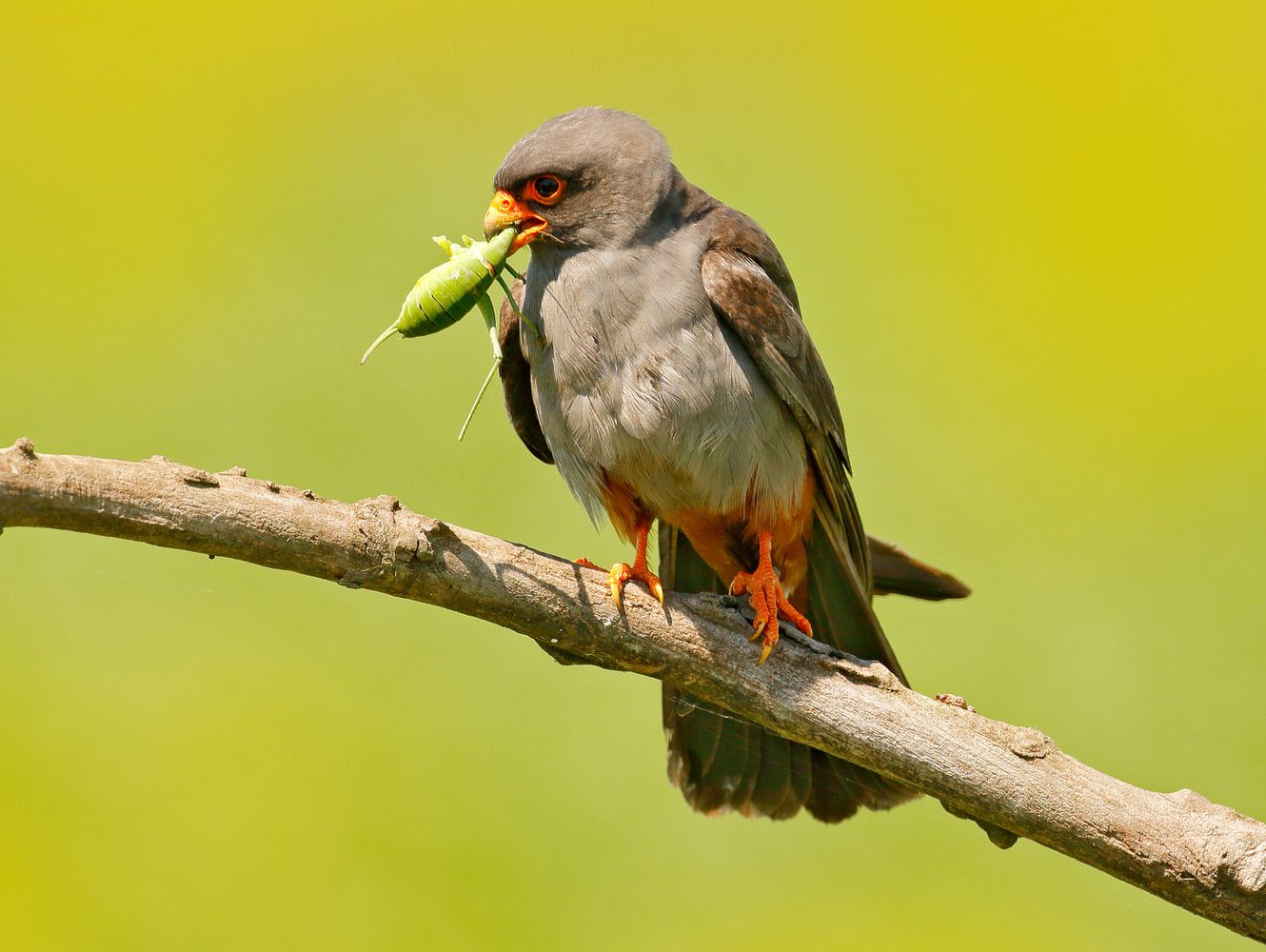
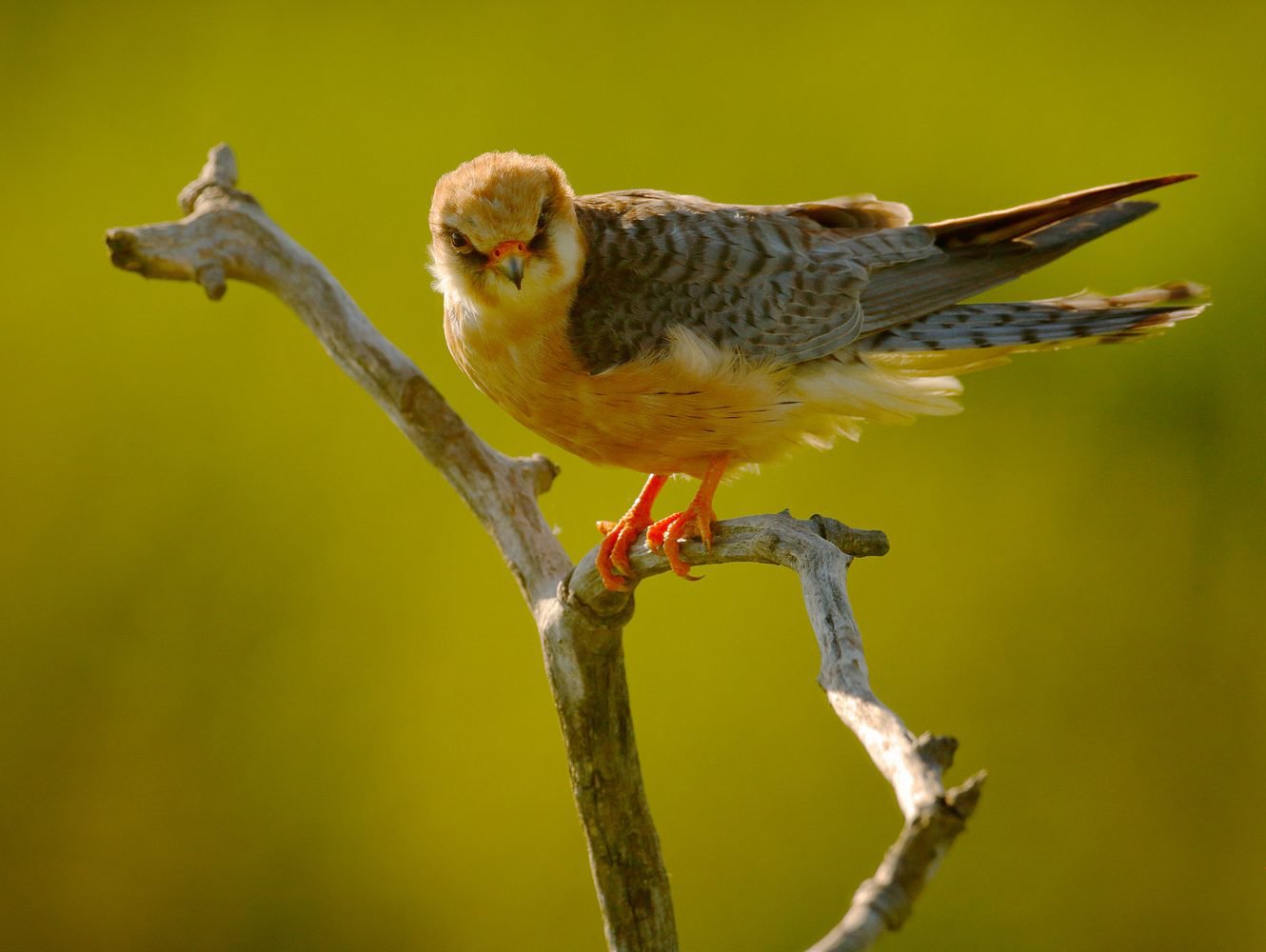
Red-Footed Falcons are small to medium-sized birds known for being long-distance migrants. Adult males are slate-gray overall but their underparts are lighter, and their bellies, undertails, legs and feet are red.
Their underwings are plain gray but their flight feathers are silvery-gray. Their ceres (base of the bill) are red and the tip of their bills is blackish. They have brown eyes with red eyerings.
Females have a rufous head, white cheeks, dark eye masks, and mustache stripes. They have barred gray upperparts and plain rufous underparts. Their flight feathers and tails are barred gray above and white-barred underneath.
Juveniles resemble the females but they are mostly brown overall with dark streaks on the underparts. They go through several changes in their coloring until they reach adult coloring at three years old.
- Falco vespertinus
- Length: 11 – 13 in (28 – 34 cm)
- Weight: 5.5 oz (155 g)
- Wingspan: 26 – 30 in (65 – 75 cm)
Red-footed Falcons are usually found in Europe but are occasional vagrants to North America.
You can find Red-footed Falcons in semi-open habitats like forest clearings, valleys, farmland, and marshes during the breeding season. During winter they spend their time in open grassy habitats with trees and shrubs.
They are also found in towns and villages on occasion. They form large nighttime communal roosts, as many as thousands, in groves of eucalypts.
Red-footed Falcons mostly hunt insects like beetles, butterflies, dragonflies, cicadas, and moths. When on their wintering habitats, they feast on flying ants, termites, locusts, and grasshoppers, which they catch while flying.
Their priority during the breeding season is mostly vertebrates to feed their chicks and these include small rodents, small birds, lizards, and amphibians. They hunt low on the ground or over water, hunting from a perch or hovering over an area and then swooping down for the kill.
Red-footed Falcon Call:
Nests of Red-footed Falcons are usually old and abandoned stick nests of other birds like crows or magpies. They may join a small colony or nest on their own depending on how abundant food is. Nests are located on cliff ledges, and tree cavities, concealed among vegetation on the ground, or in artificial nest boxes.
The female lays two to five eggs and then both parents incubate these for three to four weeks. The young fledge only a month after hatching and can be independent two weeks later.
Fun Facts: Red-Footed Falcons are currently listed as Vulnerable due to the destruction of their nest sites and habitats, they are hunted during their migration, and the increased use of pesticides that diminish the insects that are their primary food.
61. Collared Forest Falcon
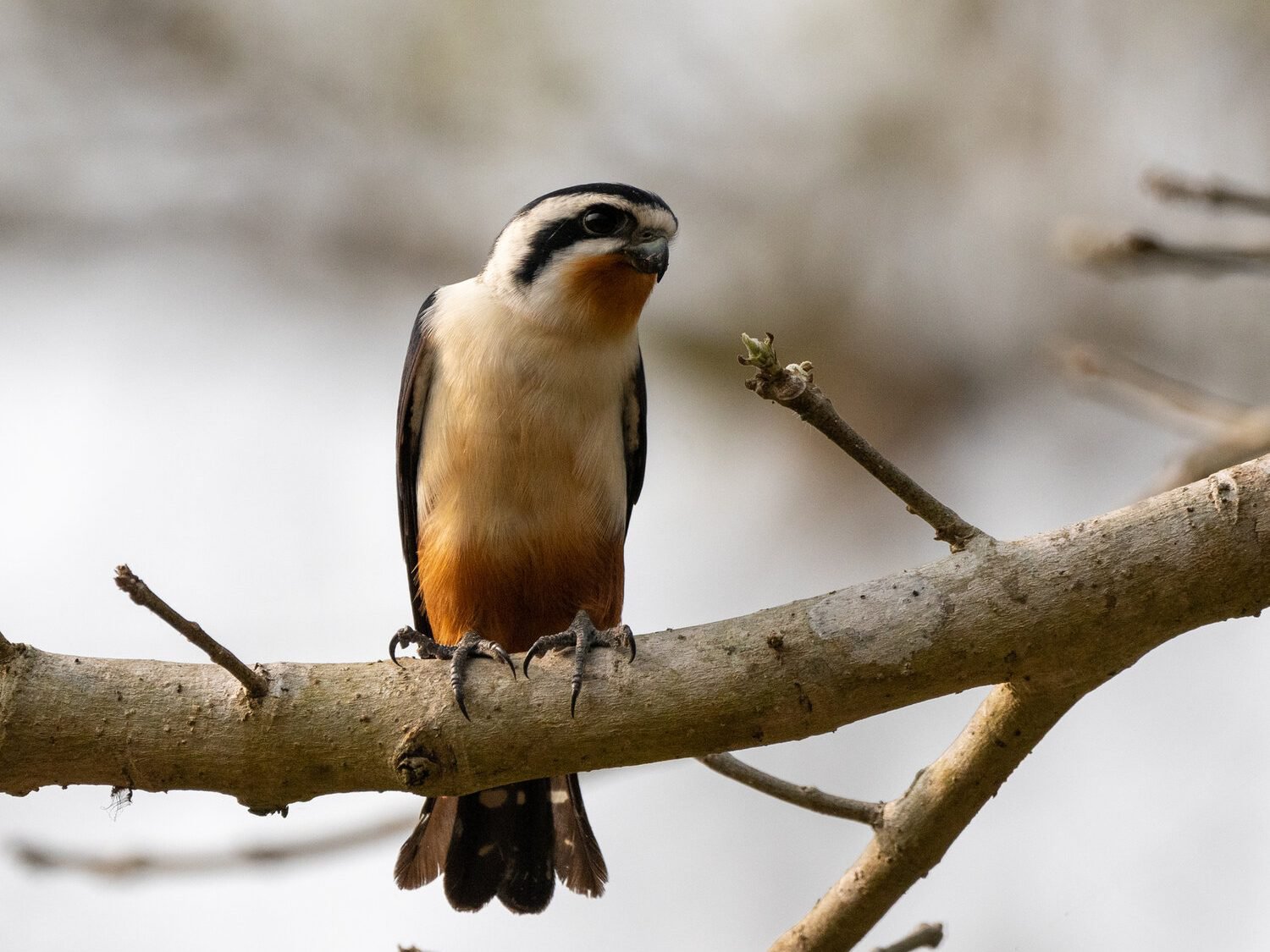
Collared Forest Falcons get their name from the two dark bands on the back of their necks that resemble a collar. They are the largest of the Forest Falcons and are dark on the back and pale underneath.
They have greenish facial skin, dark upperparts, white necks and breasts, bills that are dark grey to black, large brown eyes, long yellow legs and feet, short wings, and long black and white tails with three narrow white bars and a white tip.
They are also known to have three color morphs, pale, tawny, and dark. The dark is rare and black overall, the tawny is cinnamon underneath instead of white like the pale variant.
Juveniles are similar and are dark on the back and lighter underneath, but the collar may not be visible.
- Micrastur semitorquatus
- Length: 18 – 22.8 in (46 – 58 cm)
- Weight:16 – 33 oz (479 – 940 g)
- Wingspan: 28 – 33.8 in (72 – 86 cm)
The Collared Forest Falcon has only been seen in Texas, probably since it borders Mexico where they are usually found as well as South America.
You can find the Collared Forest Falcon in a wide range of forested environments. As a forest falcon, it favors edges and clearings, secondary-growth forests with a dense understory, and mangroves. It hardly moves deep into a large forested area.
Collared Forest Falcons hunt small prey like frogs, snakes, rodents, and large insects but they’re also known to hunt bigger prey like birds, and other animals much bigger than them.
They ambush their prey with stealth as they fly from perch to perch. They can also run fast on the ground through the forest’s dense cover.
Collared Forest Falcon Call:
Nests of Collared Forest Falcons are usually in cavities of old, large trees or cliffs. They don’t add any other material to modify their nests. In cases where there are scarce tree cavities, they may take over other birds’ nests and displace any eggs or chicks that are there.
The female lays two to three eggs and she alone incubates them for as long as forty-eight days. The male supports her by feeding her. When the eggs hatch, both parents feed their young and continue to care for them even after they’re capable of flight.
Fun Fact: Collared-forest Falcons call before sunrise so the sound will travel further to claim their territory.
Kites
62. White-tailed Kite
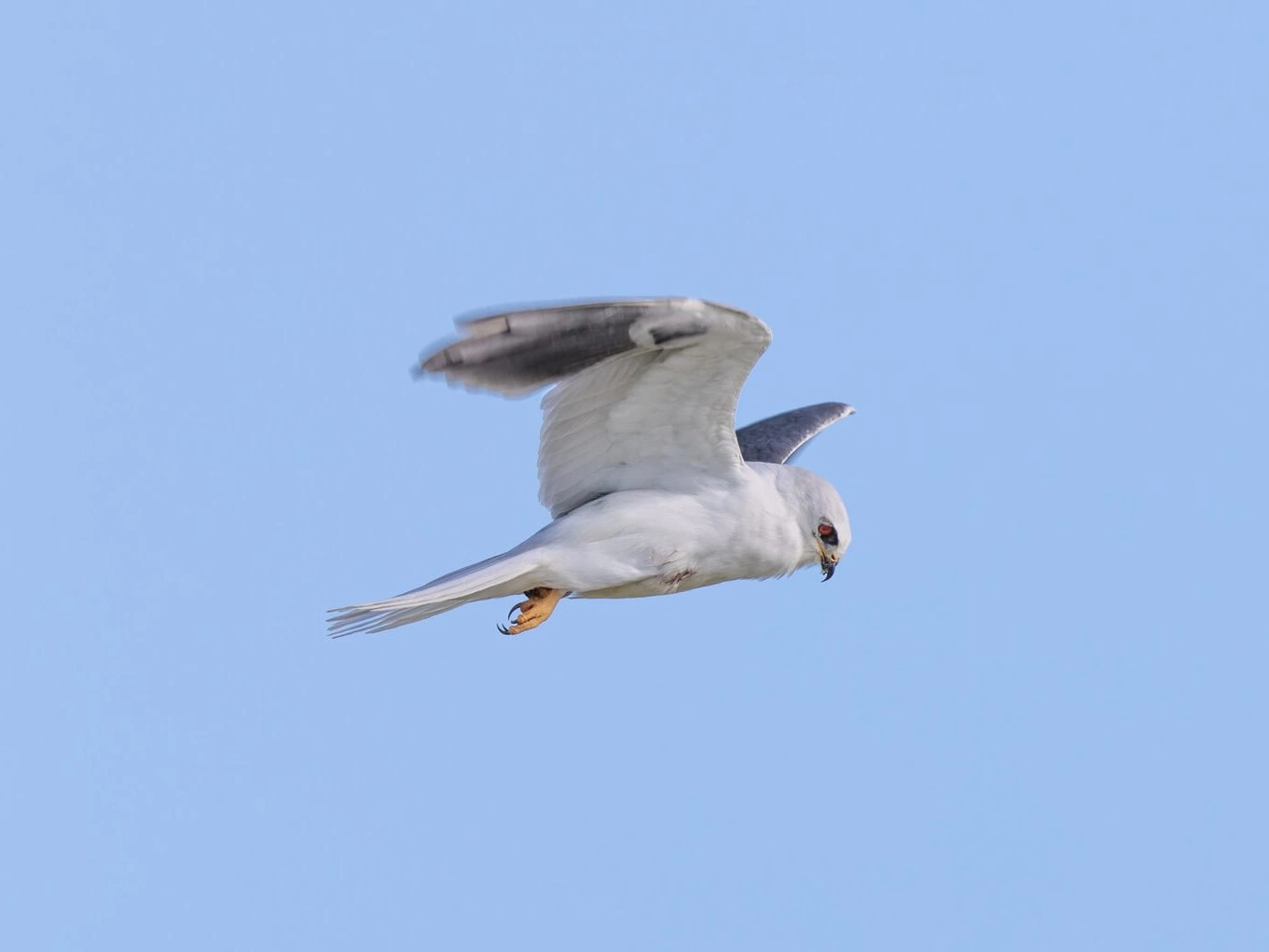
White-tailed kites are small graceful raptors with white faces and underparts and dark gray wings.
White-tailed kites are small and narrow with white faces and underparts. Adults look similar. Their eyes are red and their hooked bills are black. Their wings are gray with black patches on their shoulders. Underneath, their wings are white and gray. Their tails are short, square, and pale gray.
Juveniles have a reddish-brown coloring on their crowns and breasts, but they have similar white faces, dark shoulders, and gray wings as the adults.
- Elanus leucurus
- Length: 15 – 17 in (38 – 43 cm)
- Weight: 12 oz (340 g)
- Wingspan: 40 – 42 in (102 – 107 cm)
White-tailed Kites are resident all year in southern US states and along the Pacific Coast.
You can find White-tailed Kites within a limited range in the United States. They are usually in open savannahs, desert grasslands, cultivated fields, and partially cleared lands.
During the non-breeding season, it’s easy to spot them since they roost in groups communally on trees and tall shrubs at the edge of grasslands.
White-tailed Kites’ usual meal involves rodents, like voles, field mice, and gophers, and may include small birds, snakes, lizards, and frogs. They will also catch flying insects like grasshoppers, crickets, and beetles, as they’re flying.
When hunting, White-tailed Kites are noted for their hovering motion above ground before they swoop in to grab their prey with their talons.
White-tailed Kite Call:
Nests of White-tailed Kites are usually made of thin twigs and built high atop tall trees, about ten to one hundred sixty feet tall. The male brings the twigs, grass, hay, and leaves and the female builds them.
She will then lay about four eggs and incubates them for a month. She is fed by the male during this time.
Fun Fact: White-tailed Kites hover in one position while hunting by facing into the wind and fluttering their wings – this is known as ‘kiting’.
63. Mississippi Kite
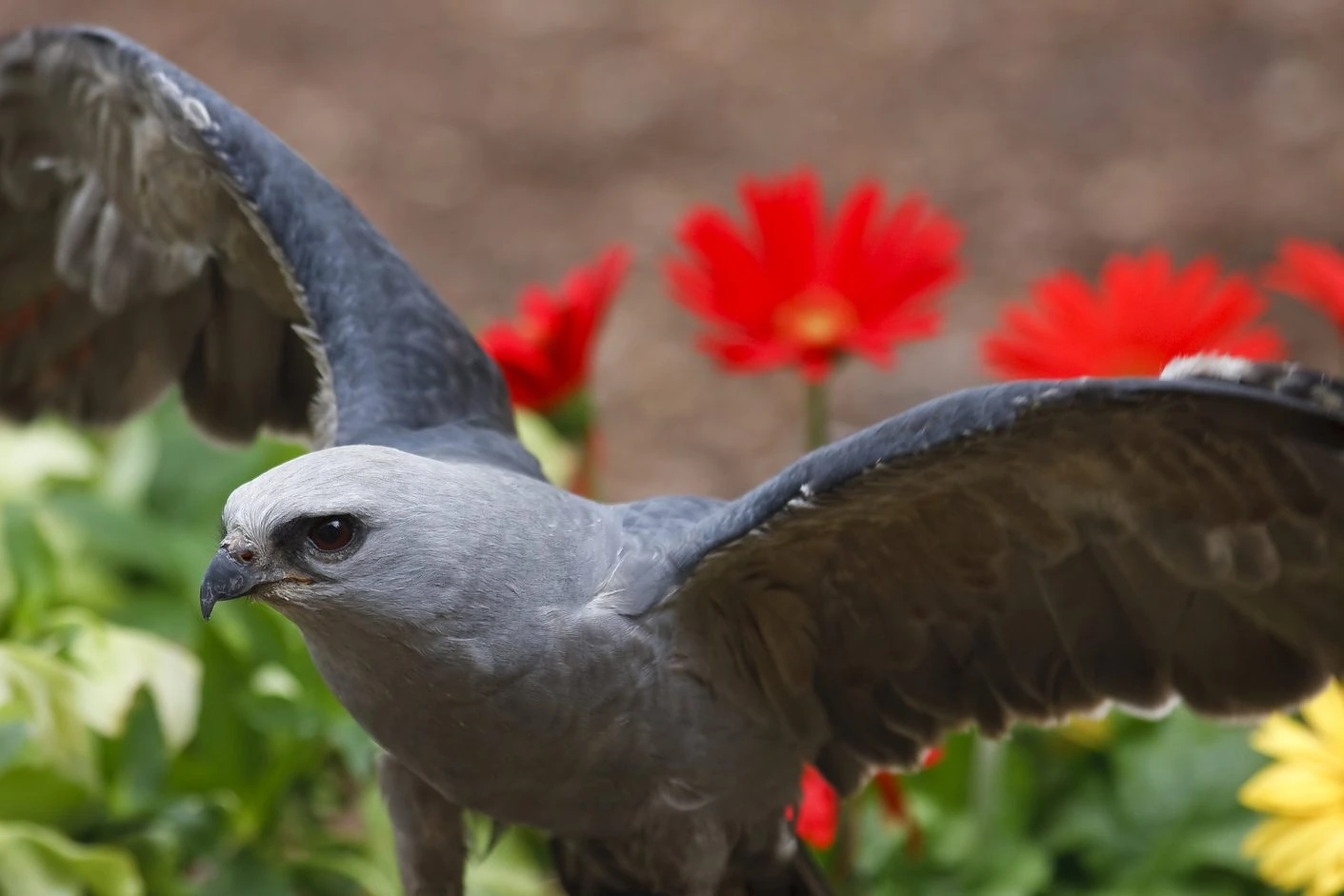
Mississippi Kites are small and slender birds of prey. They have light gray heads, red eyes with a dark eye patch in front, and small, strongly hooked dark bills.
Their underparts are light gray while their upperparts are dark gray. Their primary wings are dark gray, secondary wings are white, and wingtips are black. They have long, dark tails and red legs and feet.
Male and female Mississippi Kites look similar except that males are slightly paler than females. Juveniles have heavily streaked brown and white bellies, heavily mottled wings, and long, banded tails.
- Ictinia mississippiensis
- Length: 13 – 17 in (33 – 43 cm)
- Weight: 12.6 oz (357 g)
- Wingspan: 34 – 37 in (86 – 94 cm)
Mississippi Kites breed in southern and eastern United States and migrate to South America, mainly Argentina, Paraguay, Uraguay, and southern Brazil.
You can find Mississippi Kites in small woodland forests in the prairies, dense old-growth hardwood forests, and more recently, in tree-lined areas like windbreaks, shelterbelts, city parks, golf courses, and other urban areas.
It is best to keep your sights above the trees for they love to sail on the wind and float in the air. In cityscapes, they’re likely to perch on tall buildings.
Most of the time, Mississippi Kites forage from the air and catch their prey and eat them while in flight. They capture medium to large-sized insects like grasshoppers, beetles, cicadas, and dragonflies.
They also hunt from their perch in trees and snag snakes, turtles, small birds, lizards, frogs, and fish. Sometimes, they hang around bison, horses, deer, and people and snatch whatever insects are flushed out by their activities.
Mississippi Kite Call:
Nests of Mississippi Kites are built on most types of trees. They can use tree branches that are a few feet off the ground or even as high as 115 feet up. They can build them on their own using twigs, leaves, and moss or they can re-use old, abandoned nests by other birds or even squirrels.
Both adults build the nest together and the female lays one to three eggs in it. They both take the time to incubate the eggs for about twenty-nine to thirty-two days. Mississippi Kites usually nest in colonies and will sometimes accept help with the nest from a one-year-old bird.
They’re also very protective of their nest and will attack anyone, people and animals alike when they get too close.
Fun Fact: Mississippi Kites are more successful at producing offspring in their urban habitats because there are fewer predators there than in forests and woodlands.
64. Swallow-tailed Kite
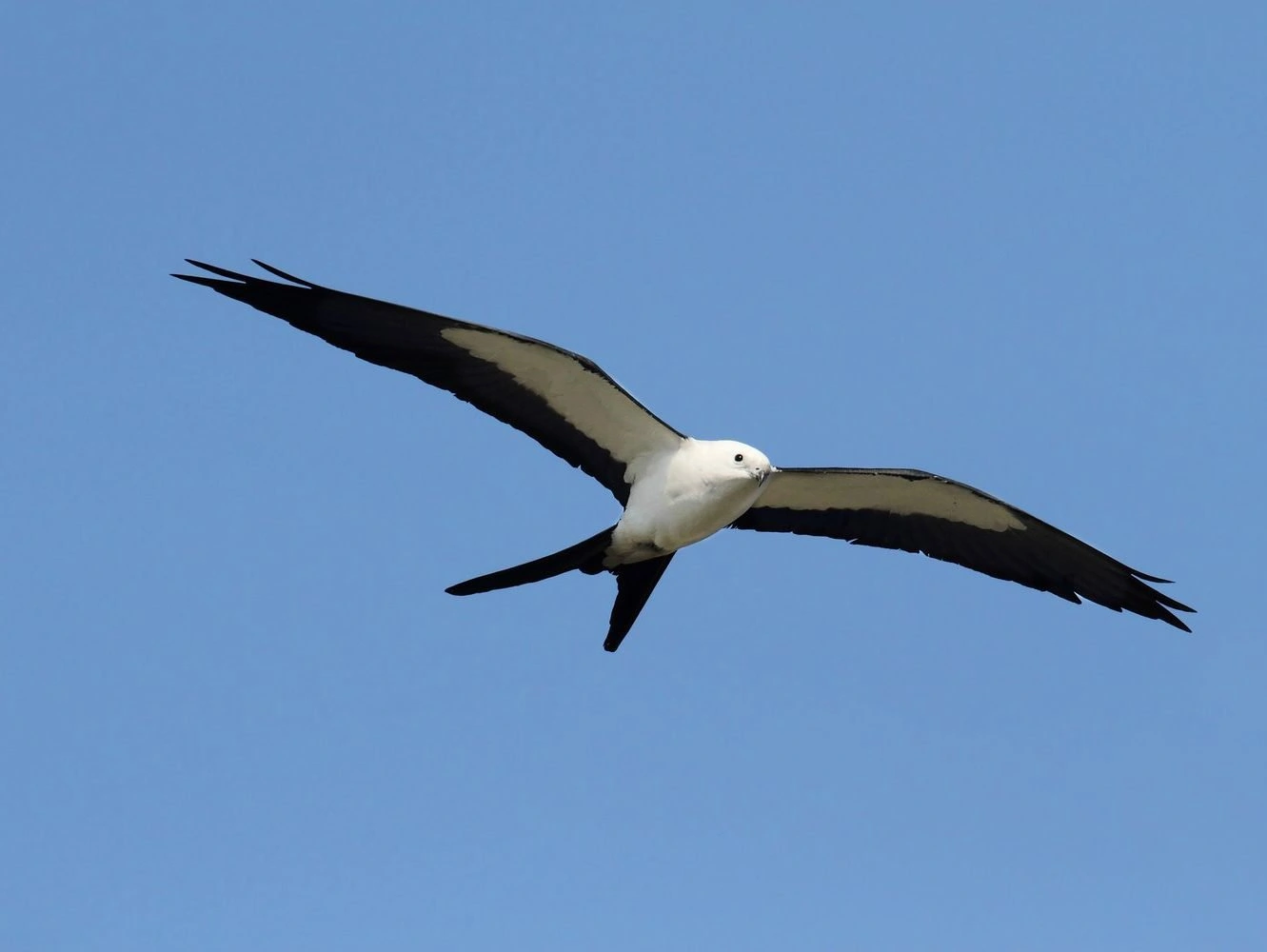
Swallow-tailed Kites are large but slender birds of prey that are most often seen hovering in the skies with their distinctive forked tail.
Males and females look similar and have white heads and underparts and black bills, flight feathers, tails, and feet. Their underwings are both black and white. Their long, forked tails resemble a swallow’s hence the name “swallow-tailed”.
Juveniles are paler in comparison and their tails are not that deeply forked.
- Elanoides forficatus
- Length: 19 – 25 in (48 – 64 cm)
- Weight: 15.6 oz (442 g)
- Wingspan: 45 – 50 in (114 – 127 cm)
Swallow-tailed Kites are predominantly resident in South America but they breed around the Gulf Coast of the United States.
You can find Swallow-tailed Kites in swamps, marshes, and humid, lowland forests. When nesting, look for them in tall trees around open areas with an abundance of small prey to feed their young.
Swallow-tailed Kites almost always spend their time in flight so it’s best to look skyward when looking for them. Also, summer is the best time to see them since they migrate to South America for the winter.
Swallow-tailed Kites are graceful, acrobatic hunters and they usually catch their prey mid-air.
Insects like dragonflies, cicadas, wasps, bees, crickets, and beetles are their primary food. They also eat small snakes, frogs, lizards, and small birds when flying in from the treetops.
They eat their prey immediately during their flight. When catching prey to feed their mates and their young, they will usually carry the food item with their feet and then transfer it to their beaks to give to the female.
Swallow-tailed Kite Call:
Nests of Swallow-tailed Kites are often concealed by foliage in the tallest of trees in the forest. Both adults build a new nest each year and they bring materials like sticks, lichens, and moss to the nesting site. Other times, they may repair and reuse their old nesting site.
The female lays one to three eggs and incubation takes twenty-four to twenty-eight days. Not all young survive since sometimes the eldest chick will kill the younger, smaller sibling, particularly if there’s not enough food.
Fun Fact: Swallow-tailed Kites are famous for their aerial acrobatics and they twist, turn, roll and dive whilst flicking their forked tail in pursuit of prey.
65. Snail Kite
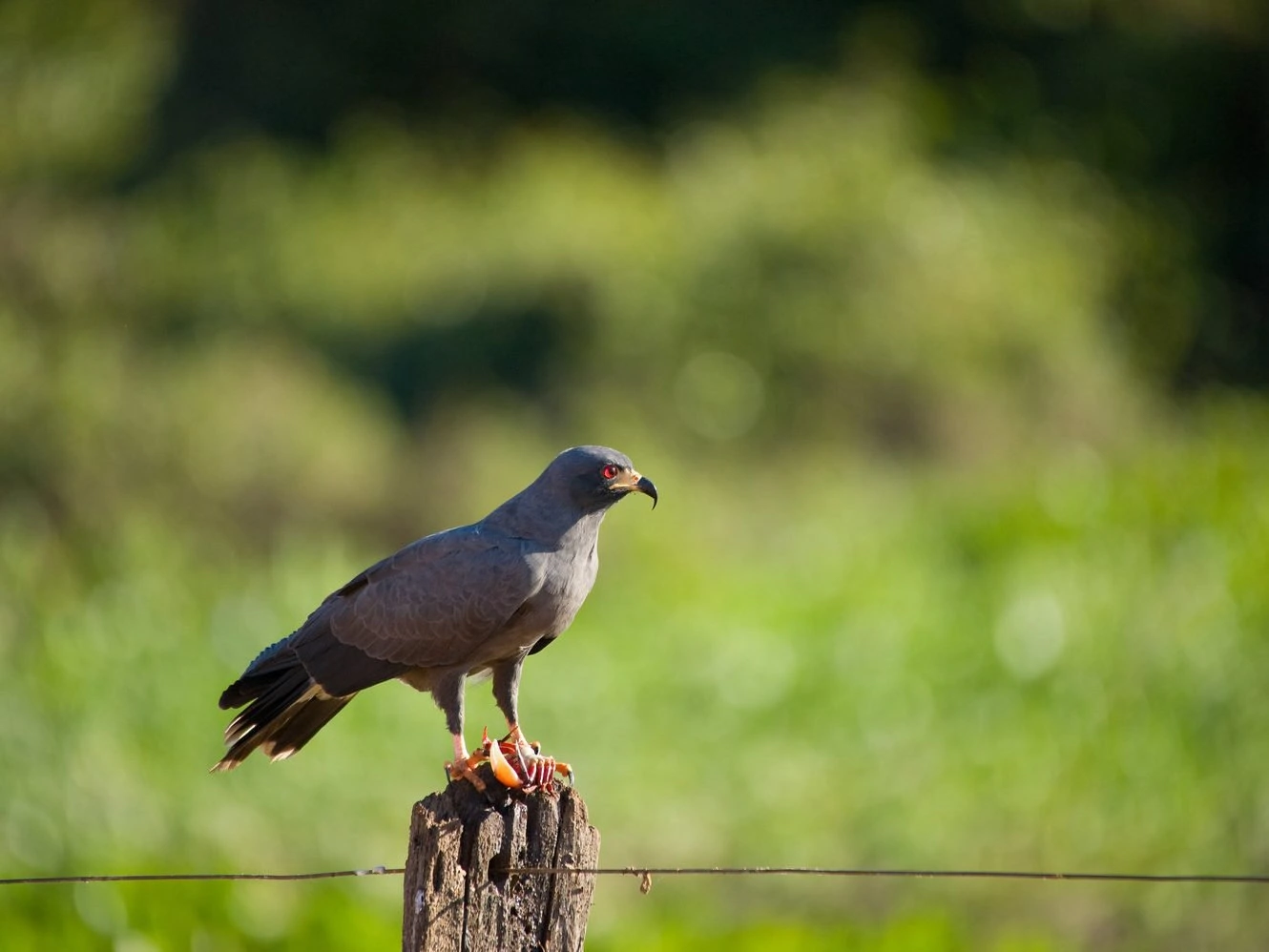
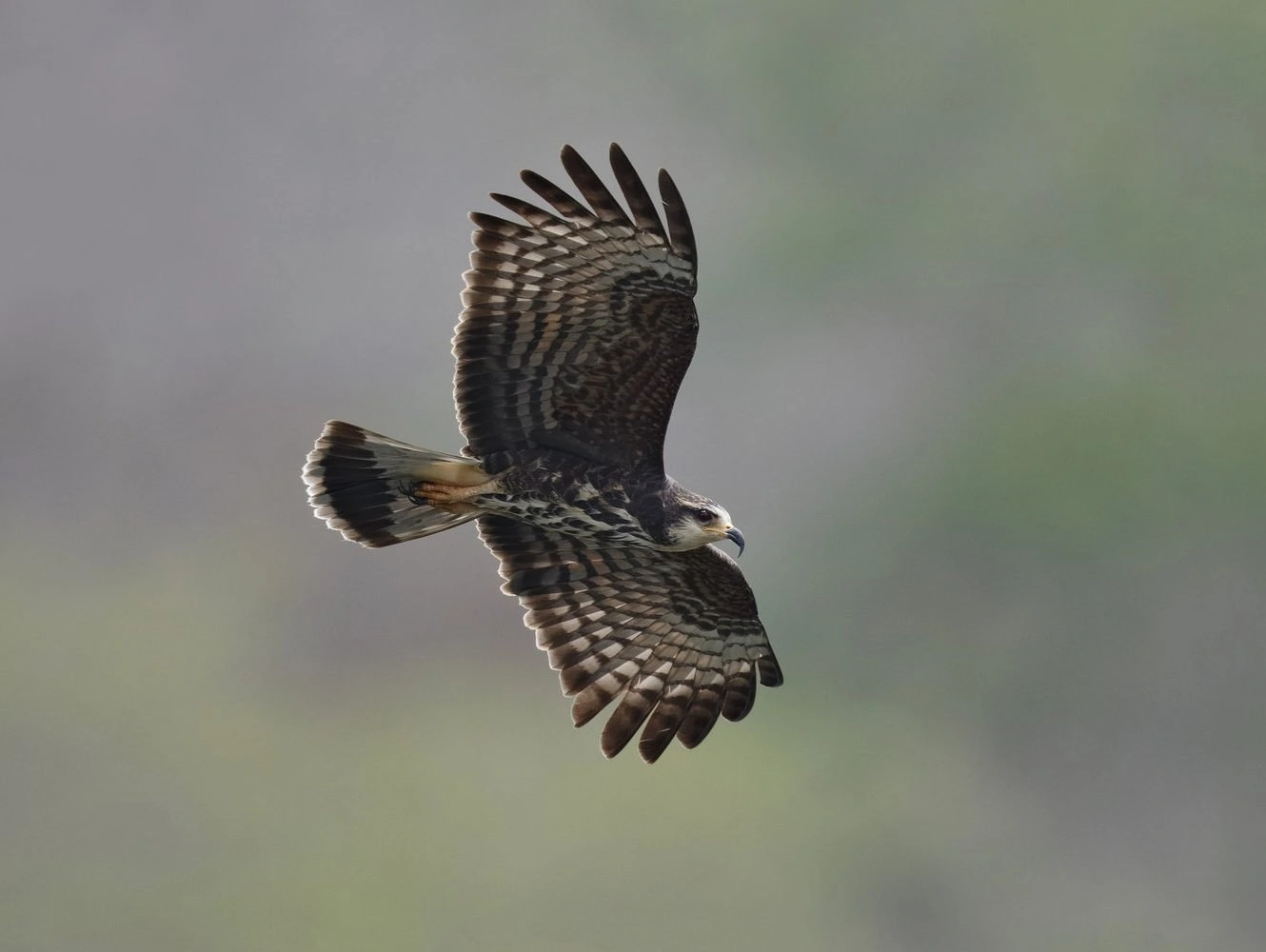
Snail Kites are named for their primary prey, apple snails. Male Snail Kites have dark gray bodies, red eyes, specially-hooked orange bills with black tips, long white tails with thick blue-black distal bands, and gray terminal bands. Their legs are reddish-orange.
Females are brown overall with heavy white streaks on their bellies. They have whitish heads, with darker areas above and behind the eyes. They have orangish-brown eyes, a thin, curved orange bill with a black tip, and white chins. Their legs are red-orange.
Juveniles resemble females with their dark brown coloring and streaks on their heads and bellies. Their eyes are dark brown, their bills are entirely dark and their legs are yellowish.
- Rostrhamus sociabilis
- Length: 16 – 18 in (41 – 46 cm)
- Weight: 13.3 oz (377 g)
- Wingspan: 45 in (114 cm)
Snail Kites are resident all year in Central and South America, Cuba and mainly Florida in the southern United States.
You can find Snail Kites in freshwater marshes, shallow lakes, and other bodies of water with marsh edges and emergent vegetation. They roost communally in tropical woodlands near these wetlands.
The apple snail is the primary food of these Snail Kites. They hunt them from a perch or while flying over shallow and clear waters. They grasp them with their talons and then perch on a branch to extract the snail from within with their specialized hooked bills.
When apple snails are less abundant, they may feed on other prey like turtles, crayfish, snakes, small crabs, or fish.
Snail Kite Call:
Nests of Snail Kites are often found in bushes on the ground or in trees less than 30 feet tall. They are usually beside shallow water next to feeding areas. The male builds the nest with dry sticks and plant materials lined with leaves, reeds, and grasses.
The female lays two to four eggs and both adults incubate them for twenty-six to thirty days.
Fun Fact: Once the young become fledglings, one parent will establish another brood with another mate, in a mating system called “sequential monogamy”.
66. Hook-billed Kite
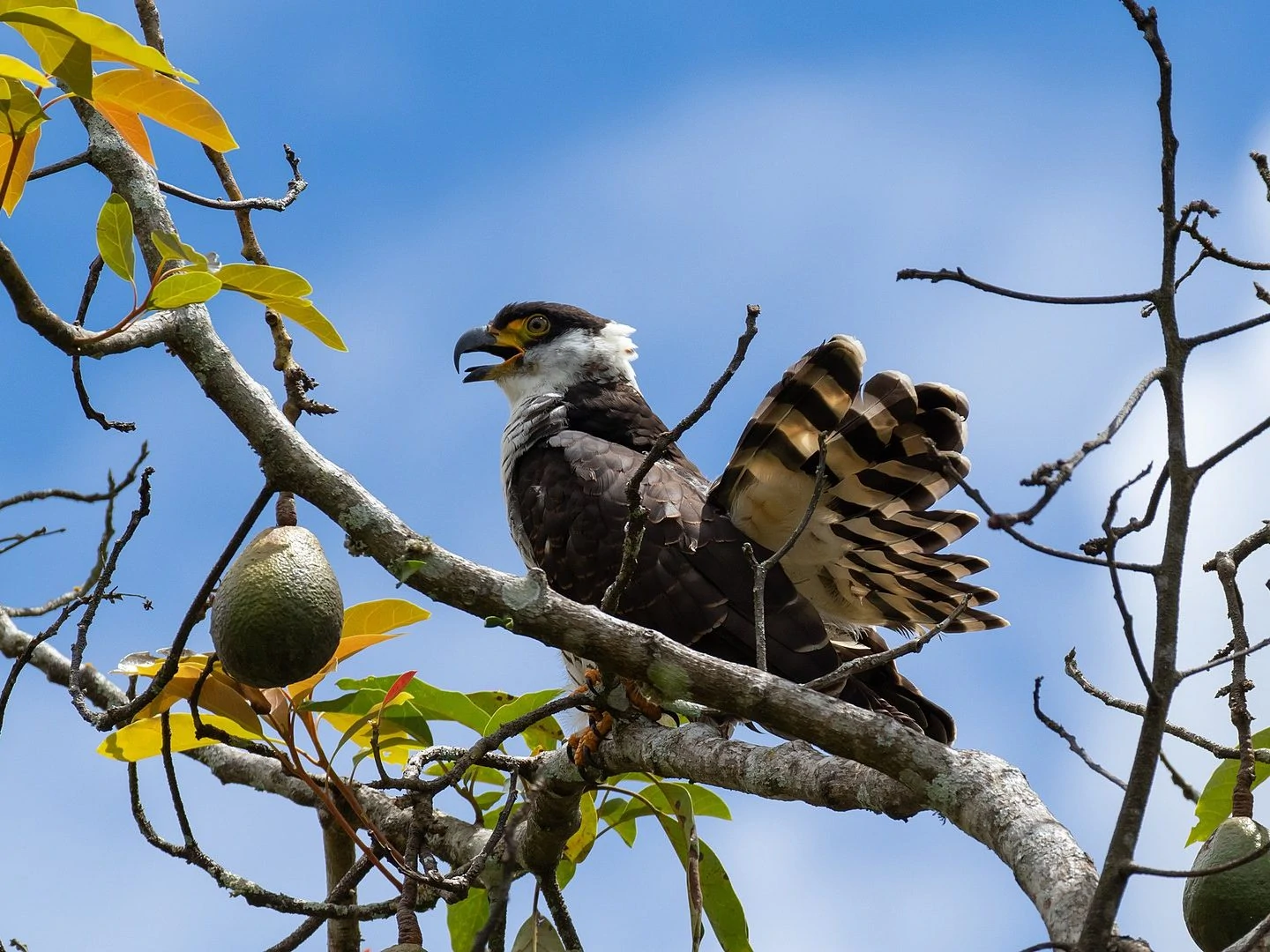
Hook-billed Kites are distinctive birds of prey because of their parrot-like, hooked bills. Males are generally gray all over, particularly on their heads, backs, and wings.
Their eyes are white with a pale green eyering and they have an orange patch above their green lores (the bare skin in front of their eyes). Their breasts are gray too but have varying degrees of white barring. Their tails are black with two broad white bands.
Females share similar head characteristics as males. However, they are mostly brown on their upperparts but rufous (reddish) with white barring on their breasts. They also have an orange-brown collar. Their tails are also rufous with two dark-brown bands.
Juveniles are dark brown above, and white with blackish barring on the underparts. Their tails show three to four bars instead of two.
The Hooked-bill Kites have a dark morph that is black with a broad white tail band.
- Chondrohierax uncinatus
- Length: 16 – 18 in (41 – 46 cm)
- Weight: 9.8 oz (278 g)
- Wingspan: 34 – 38 in (86 – 97 cm)
Hooked-bill Kites are resident all year in Central and South America down to southern Brazil and they have also wandered into the southern United States.
You can find Hooked-bill Kites in lowland rainforests, second-growth and disturbed forests, forest edges, and clearings. They also frequent wooded streams and dry coastal forests. They may go where their favorite tree snails are, moving from one location to another depending on the abundance of their food.
Hooked-bill Kites favorite food are tree snails. They jump from tree limb to tree limb in search of them. Once they find one, they snatch it from the tree with their bill, insert their hooked bill into the shell, and then crack it open.
They will do almost anything to get that snail, even catching it in flight or hanging upside down from branches to reach it. Aside from tree snails, they also eat, insects, crabs, frogs, and salamanders.
Hooked-bill Kite Call:
Nests of Hooked-bill Kites are usually small and messy nests made of sticks and twigs. Hooked-bill Kites set them on branches of trees about five meters to twenty-five meters above the ground.
The female lays one to three eggs and incubation is done within thirty-five days mostly by the female while the male supports her with food. Both parents care for their young for as long as forty days until they’re ready to fly.
Fun Fact: Hooked-bill Kites have varying sizes of bills. Their bills are indicative of the size of the tree snails that they consume. Small bills eat small snails and vice versa.
67. Double-toothed Kite
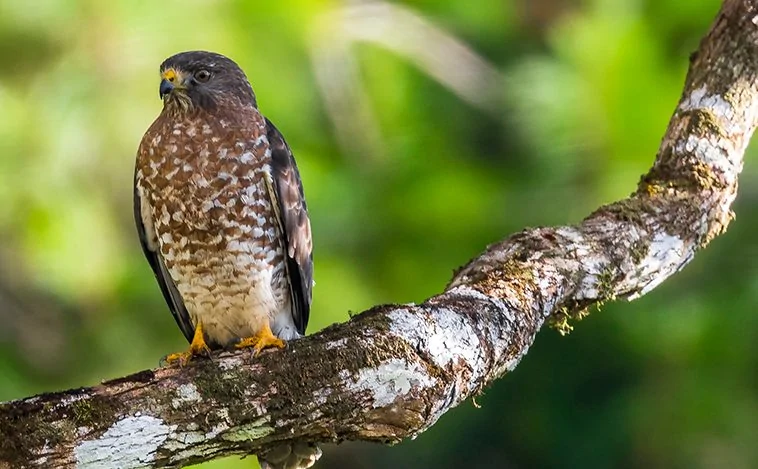
Double-toothed Kites are relatively small raptors. They have dark gray heads, backs, and wings. Their eyes are orange with dark pupils and their bills are short, stout, and black and gray at the tip. Their bellies and breasts have varying rufous (reddish) coloring with grayish-white streaks or barring.
Their throats are white and have a vertical dark stripe in the center. Their rumps and the undersides of the wings are white and visible during flight. Their legs are bright yellow.
Females are similar to males but they have deeper rufous coloring on their underparts and the barring is more often dark chestnut instead of grayish-white.
Juveniles have the same coloring as adults except for their underparts. Juveniles have whitish breasts with varying brownish vertical streaks or mottling. Their bellies are whitish, too.
- Harpagus bidentatus
- Length: 11 – 13.7 in (29 – 35 cm)
- Weight: 5.8 – 8 oz (161 – 229 g)
- Wingspan: 23.6 – 28 in (60 – 72 cm)
The Double-toothed Kite is a member of the bird of prey family that is normally found in Central and South America. However, in 2011, it was photographed in Texas and is now considered a vagrant in the United States.
You can find Double-toothed Kites in rainforests, at the edges of forests and clearings, in dense forests, and in previously disturbed second forests. Second forests are woodland areas that are growing again after the cutting of timber.
Double-toothed Kites typically hunt from their perch just below the treetops. They target lizards, bats, and insects, like cicadas, grasshoppers, and crickets. They may simply swoop down and snatch their prey or they can catch them in flight. Sometimes they hop on branches to reach their prey, too.
They have also been observed to follow monkeys, not to eat, but to capture any animals that they rustle up when they move.
Double-toothed Kite Call:
Nests of Double-toothed Kites are made of sticks and twigs built by the female. These are placed on the fork of a tree, usually at a high elevation. She will then lay one to two eggs and incubates them for about forty-two to forty-five days.
During this time, the male stays away but returns to deliver food. When they’ve hatched, the female also hunts to feed the young. Even when they’ve already learned to fly, younglings are still dependent on their parents for about another month or two.
Fun Fact: The Double-toothed Kite doesn’t really have any teeth despite its name. The “Tooth” part refers to the tooth-like structures on the edges of their upper mandibles.
68. Black Kite
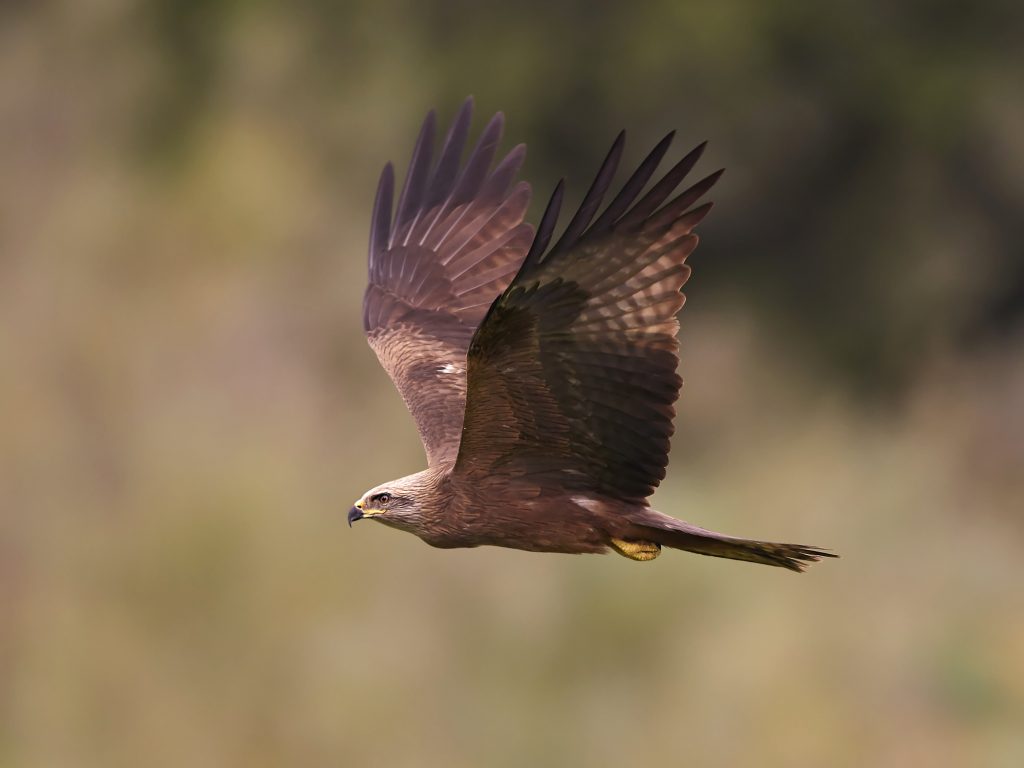
The Black Kite is a medium- to large-sized, widely distributed bird of prey that are generally dark brown in coloring. Their heads and necks are a bit on the lighter side, with some having grayish-brown streaks.
They have a dark patch behind the eye, a yellow cere (skin connecting the bill to the forehead), and a black bill (which differentiates them from the yellow-billed kite).
Their underparts are dark-brown, sometimes with some rufous (red) mixed in. Their outer wings are black with a large pale patch at their base. Their tails are short, forked, and with darker-brown barring. Their legs are yellow and their talons are black.
- Milvus migrans
- Length: 17 – 25 in (43 – 64 cm)
- Weight: 22 – 38 oz (623 – 1077 g)
- Wingspan: 47 – 60 in (119 – 152 cm)
Its current population stands at 6 Million, spanning four continents – Europe, Asia, Australia, and Africa. It has been seen in Alaska, which makes it a vagrant to North America.
You can find Black Kites in many different types of habitats considering how widespread they are in the world. They favor wetlands, river edges, coasts, grassland, open plains, shrubland, and woodlands.
You may be surprised to find them in cities, like the subspecies in India that are adapted to urban living. However, you won’t find them in dense forests and high mountains.
Surprisingly, they form large flocks in winter as they hunt for food, which is rare in birds of prey.
Black Kites are birds of prey so they are carnivores that hunt fish, small mammals, birds, bats, and rodents. They are also carrion (dead animals) eaters and they also scavenge around garbage.
Black Kite Call:
Nests of Black Kites are sturdy constructions made of sticks and twigs located on tree branches, cliff ledges, or buildings. Black Kites re-use these nests so they tend to add to the material and repair them over time.
The female lays two or three eggs. Both parents take turns in incubating the eggs, which may take as long as thirty-four days. The young stay in their nests for the next fifty days, until they learn to fly.
Fun Facts: Black Kites are known to flock around bushfires (in Australia), waiting to ambush the animals that are fleeing from the fires.
Osprey

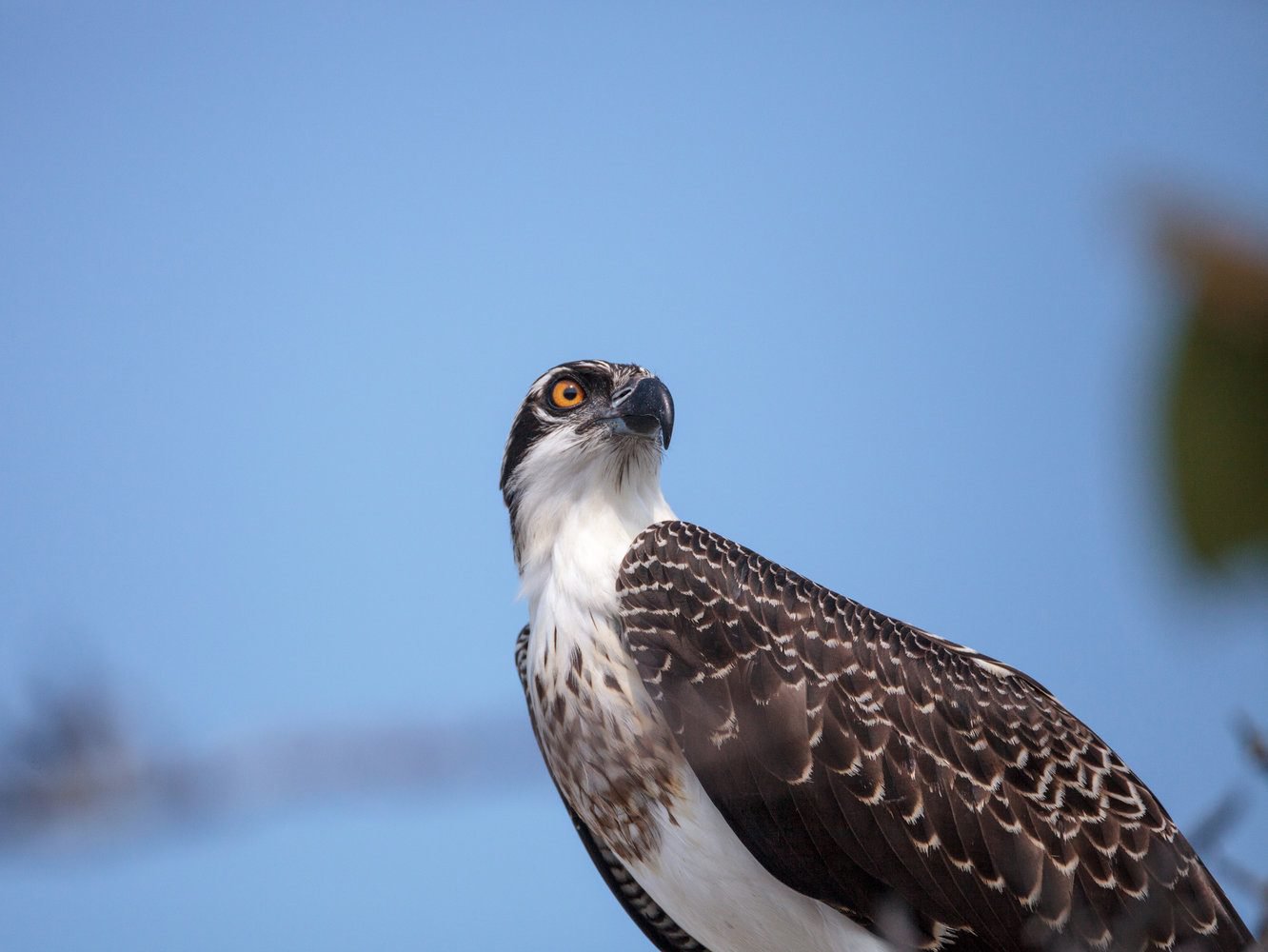
Ospreys are large, fierce-looking birds of prey that are also known as fish hawks or sea hawks for their specialized ability to catch large fish. Their outer toe can turn backward and they have long powerful talons and spiny scales on the soles of their feet which aid them in grasping slippery, strong fish.
There is only one species of Osprey around the world, however, there are three subspecies, but they are all generally brown on the back and white underneath.
Their heads are white, with some brown streaking on their crowns and foreheads. They have a distinctive broad brown line through their eyes that extends to the sides of their necks. Their eyes are yellow and their bills are black and extremely hooked. Their breasts have a pale, sometimes dark, band. Their legs and feet are gray with black talons.
Adults are fairly similar except that males are slightly slimmer with narrower wings and their breast bands are pale and sometimes nonexistent.
Juveniles have slightly buff feathers and scaled, brown upperparts.
Ospreys fly with M-shaped wings when seen from below.
- Pandion haliaetus
- Length: 21 – 24 in (53 – 61 cm)
- Weight: 63.49 oz (1799 g)
- Wingspan: 54 – 72 in (137 -183 cm)
You can find Ospreys practically anywhere in the world, except Antarctica, particularly with large bodies of water. They can tolerate any habitat as long as the food is accessible and abundant.
Ospreys feed almost exclusively on live fish. They will search for prey and when found, hover over water, then dive, feet and talons first, to capture fish. They will then carry the fish to a nearby perch or carry it over longer distances. On some occasions, they may target rodents, rabbits, snakes, frogs, and birds.
Osprey Calls:
Nests of Ospreys are often built on elevated sites, like treetops, cliffs, and man-made platforms. Nest habitats must be within easy access to their favorite prey, fish. Nests are also built in open environments to allow for easy landings. Nests are made of sticks and lined with grasses, vines, and algae.
Ospreys build up their nests over time so even if the nests start small, they can grow large and deep. Female Ospreys lay one to four eggs and they take about thirty-five to forty-three days to hatch.
Attracting Ospreys to your backyard is possible if you provide the proper nest platform and if you live near the water with an abundant fish supply.
Fun Facts: Ospreys have reversible outer toes, like owls, that allow them to easily and securely grasp fish. They also have closeable nostrils to keep water from entering their noses when they plunge into the water.

